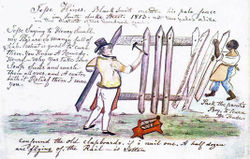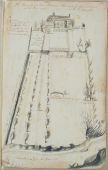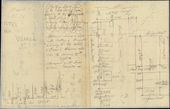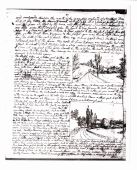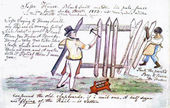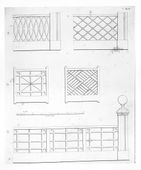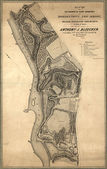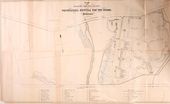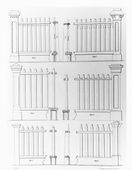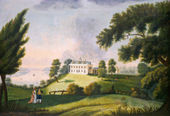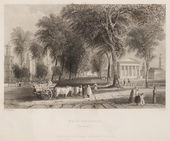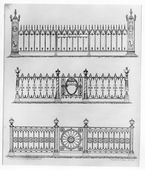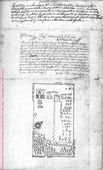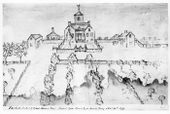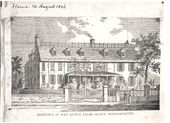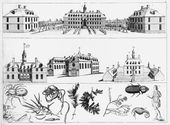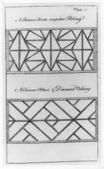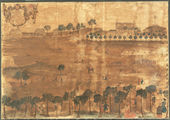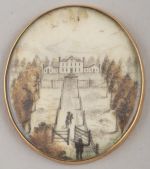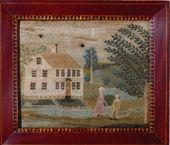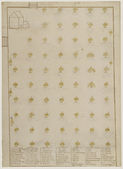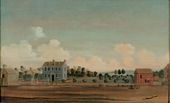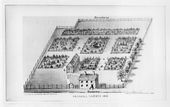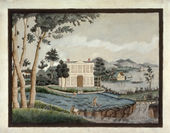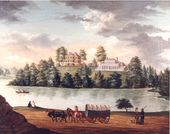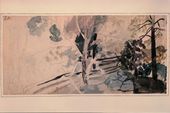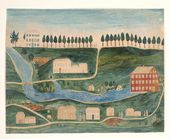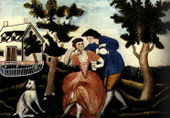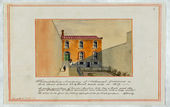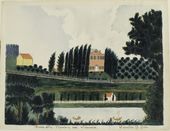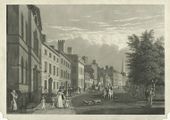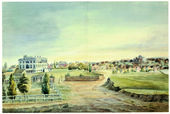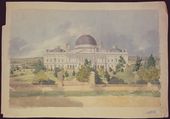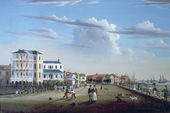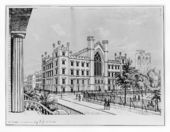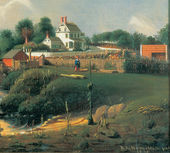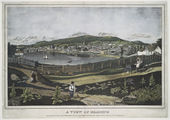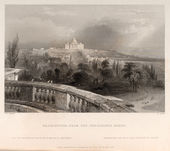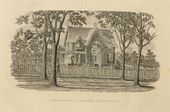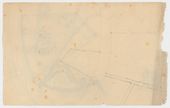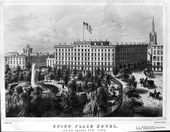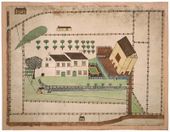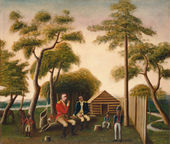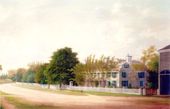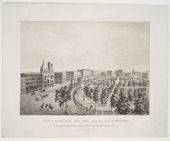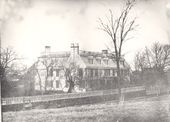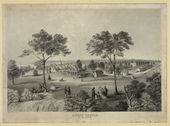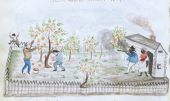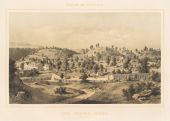Difference between revisions of "Fence"
m (CE) |
A-whitlock (talk | contribs) |
||
| (112 intermediate revisions by 8 users not shown) | |||
| Line 4: | Line 4: | ||
[[File:1467.jpg|thumb|left|Fig. 1, John Lewis Krimmel, Tree and rocks near a split-rail fence, c. 1813.]] | [[File:1467.jpg|thumb|left|Fig. 1, John Lewis Krimmel, Tree and rocks near a split-rail fence, c. 1813.]] | ||
| − | [[File:0234.jpg|thumb|Fig. 2, | + | [[File:0234.jpg|thumb|Fig. 2, Lewis Miller, “Jesse Hines. Black Smith, menden his pale fence,” 1813, in Lewis Miller, ''Sketches and Chronicles: The Reflections of a Nineteenth-Century Pennsylvania German Folk Artist'' (1966), 86.]] |
| − | Humphry Repton wrote in 1803 in reference to England that “every county has its peculiar mode of fencing, both in the construction of [[hedge]]s and ditches, which belong rather to the farmer than the landscape gardener.”<ref>Humphry Repton, ''Observations on the Theory and Practice of Landscape Gardening'' (London: Printed by T. Bensley for J. Taylor, 1803), 84, [https://www.zotero.org/groups/54737/keywords_in_early_american_landscape_design/items/itemKey/VVQPC3BI/q/repton view on Zotero].</ref> In America, where the tasks of partitioning, cultivating, and embellishing the landscape were considered inseparable, the distinction between farmer and gardener was less easily made. Frequent references to the fence in both the written and visual record place it among the most fundamental elements of the designed landscape in America. A fence, as dictionary definitions agree, enclosed areas such as gardens, cornfields, [[park]]s, [[woods]], or groups of trees. As <span id="Gregory_cite"></span>[[G. (George) Gregory|G. Gregory]] (1816) noted, the feature could be formed by a [[hedge]], [[wall]], ditch, or bank ([[#Gregory|view | + | Humphry Repton wrote in 1803 in reference to England that “every county has its peculiar mode of fencing, both in the construction of [[hedge]]s and ditches, which belong rather to the farmer than the landscape gardener.”<ref>Humphry Repton, ''Observations on the Theory and Practice of Landscape Gardening'' (London: Printed by T. Bensley for J. Taylor, 1803), 84, [https://www.zotero.org/groups/54737/keywords_in_early_american_landscape_design/items/itemKey/VVQPC3BI/q/repton view on Zotero].</ref> In America, where the tasks of partitioning, cultivating, and embellishing the landscape were considered inseparable, the distinction between farmer and gardener was less easily made. Frequent references to the fence in both the written and visual record place it among the most fundamental elements of the designed landscape in America. A fence, as dictionary definitions agree, enclosed areas such as gardens, cornfields, [[park]]s, [[woods]], or groups of trees. As <span id="Gregory_cite"></span>[[G. (George) Gregory|G. Gregory]] (1816) noted, the feature could be formed by a [[hedge]], [[wall]], ditch, or bank ([[#Gregory|view text]]). Terms for different fence types abound in American landscape design vocabulary: blind, board, close, cradle, cross, double, foss, hurdle, invisible, live, open board, pale/paling, palisade, picket, post-and-plank, post-and-rail, snake, sunk, [[trellis]], Virginia, wattle, wire, worm, and zigzag.<ref>For a more detailed discussion of fence types, see Vanessa Patrick, “Partitioning the Landscape,” ''Colonial Williamsburg Research Report'' (Williamsburg, VA: Williamsburg Foundation, 1983), [https://www.zotero.org/groups/54737/keywords_in_early_american_landscape_design/items/itemKey/KK726D7T/q/partitioning%20the%20landscape view on Zotero]; Elizabeth Wilkinson and Marjorie Henderson, eds., ''Decorating Eden: A Comprehensive Sourcebook of Classic Garden Details'' (San Francisco: Chronicle Books, 1992), 42–69, [https://www.zotero.org/groups/54737/keywords_in_early_american_landscape_design/items/itemKey/5TNM2M83/q/Decorating%20Eden%3A%20A%20Comprehensive%20Sourcebook%20of%20Classic%20Garden%20Details view on Zotero]; Wilbur Zelinsky, “Walls and Fences,” in ''Changing Rural Landscapes'', ed. Ervin H. and Margaret J. Zube (Amherst: University of Massachusetts Press, 1977), 53–63, [https://www.zotero.org/groups/54737/keywords_in_early_american_landscape_design/items/itemKey/X8FV99J7/q/Changing%20rural%20landscapes view on Zotero].</ref> |
| − | [[File:0197.jpg|thumb|left|Fig. 3, | + | [[File:0197.jpg|thumb|left|Fig. 3, Francis Guy, ''Rose Hill'', 1798. The home of William Gibson in Baltimore, MD, which is depicted in this detail from a John and Hugh Finley armchair, illustrates the use of a fence to frame the [[view]] of the façade.]] |
[[File:1701.jpg|thumb|Fig. 4, [[J. C. Loudon]], Diagram of worm fence, in ''An Encyclopaedia of Gardening'' (1834), 412, fig. 276.]] | [[File:1701.jpg|thumb|Fig. 4, [[J. C. Loudon]], Diagram of worm fence, in ''An Encyclopaedia of Gardening'' (1834), 412, fig. 276.]] | ||
| − | The choice of fence type was dictated by the materials available, local custom, and the need at hand. For instance, worm fences (also called zigzag, snake, split rail, or Virginia fences) did not require posts or post holes and therefore were easily moved to accommodate changing field use and avoided the problem of posts rotting in soil. They were also useful in areas where rocky soil made it difficult to dig post holes or in wooded areas where trees made straight fence lines impractical, as seen in the watercolor sketch by John Lewis Krimmel [Fig. 1]. Paled fences offered a more solid line of defense against deer and rabbits, but had less flexibility and required more labor and finished lumber [Fig. 2]. Such high fences were effective barriers for animals as well as humans, as attested by <span id="Waln_cite"></span>Robert Waln Jr.’s 1825 description of the board fence at the Friends Asylum for the Insane in Pennsylvania ([[#Waln|view | + | The choice of fence type was dictated by the materials available, local custom, and the need at hand. For instance, worm fences (also called zigzag, snake, split rail, or Virginia fences) did not require posts or post holes and therefore were easily moved to accommodate changing field use and avoided the problem of posts rotting in soil. They were also useful in areas where rocky soil made it difficult to dig post holes or in wooded areas where trees made straight fence lines impractical, as seen in the watercolor sketch by John Lewis Krimmel [Fig. 1]. Paled fences offered a more solid line of defense against deer and rabbits, but had less flexibility and required more labor and finished lumber [Fig. 2]. Such high fences were effective barriers for animals as well as humans, as attested by <span id="Waln_cite"></span>Robert Waln Jr.’s 1825 description of the board fence at the Friends Asylum for the Insane in Pennsylvania ([[#Waln|view text]]). |
| − | [[File:0476.jpg|thumb|left|Fig. 5, James Smillie (artist), Sarony & Major (printers), ''View of Union Park, New York, from the Head of Broadway,'' 1848. The ironwork fence, at 14th Street, encircles what was known as Union Square Park.]] | + | [[File:0476.jpg|thumb|left|Fig. 5, James Smillie (artist), Sarony & Major (printers), ''[[View]] of Union [[Park]], New York, from the Head of Broadway,'' 1848. The ironwork fence, at 14th Street, encircles what was known as Union [[Square]] [[Park]].]] |
| − | [[File:0424.jpg|thumb|Fig. 6, [[Alexander Jackson Davis]], Ithiel Town, and James Dakin, ''New York University, [[ | + | [[File:0424.jpg|thumb|Fig. 6, [[Alexander Jackson Davis]], Ithiel Town, and James Dakin, ''New York University, Washington [[Square]]'', 1833.]] |
| − | Paling fences created visual barriers and were sometimes erected to screen unpleasant views or to provide privacy, particularly in urban settings. For instance, in 1857 <span id="Watson_cite"></span>John Fanning Watson complained that “in the usual selfish style of Philadelphia improved grounds” at William Bingham’s Philadelphia residence, “the whole was surrounded and hid from the public gaze by a high fence” ([[#Watson|view | + | Paling fences created visual barriers and were sometimes erected to screen unpleasant views or to provide privacy, particularly in urban settings. For instance, in 1857 <span id="Watson_cite"></span>John Fanning Watson complained that “in the usual selfish style of Philadelphia improved grounds” at William Bingham’s Philadelphia residence, “the whole was surrounded and hid from the public gaze by a high fence” ([[#Watson|view text]]). Fences were also used to direct the gaze, whether toward a house, as in Francis Guy’s chairback painting of Rose Hill in Baltimore [Fig. 3], or other focal point. In other cases, fences such as sunken types (later replaced by wire fences) were desired for their inconspicuous presence in the landscape. Numerous descriptions and horticultural advice columns praised the effect of unobstructed views created by enclosures that kept animals or human traffic at bay with minimal visibility (see [[Ha-ha]]). |
[[File:1086.jpg|thumb|left|Fig. 7, James Smillie (artist), O. J. Hanks (engraver), “The Tour—Oaken Bluff,” in Nehemiah Cleaveland, ''Green-Wood Illustrated'' (1847), pl. opp. 40.]] | [[File:1086.jpg|thumb|left|Fig. 7, James Smillie (artist), O. J. Hanks (engraver), “The Tour—Oaken Bluff,” in Nehemiah Cleaveland, ''Green-Wood Illustrated'' (1847), pl. opp. 40.]] | ||
| − | [[File:1078.jpg|thumb|Fig. 8, George W. Stilwell, Patterns of railings at | + | [[File:1078.jpg|thumb|Fig. 8, George W. Stilwell, Patterns of railings at Green-Wood [[Cemetery/Burying ground/Burial ground|Cemetery]], in Nehemiah Cleaveland, ''Green-Wood Illustrated'' (1847), pl. after 94. This book includes a description of a “neat iron paling surrounds the hill, marking it as the appropriate final home of a large family.”]] |
| − | Fences were constructed from a variety of materials. In the Tidewater’s sedimentary soils where stone was scarce, wood was the most common material and was used mainly in paled, post-and-rail or board, and worm fences. Although types of wood that could be used were varied, a typical paling fence utilized different types of wood. For example, hard wood, such as locust, cedar, or oak, was often used for posts; wood with tensile strength, such as oak, poplar, or pine, was used for rails; and lightweight wood, such as pine, could be employed for the pales.<ref>Patrick 1983, 2, 16, [https://www.zotero.org/groups/54737/keywords_in_early_american_landscape_design/items/itemKey/KK726D7T/q/partitioning%20the%20landscape view on Zotero].</ref> Although worm fences [Fig. 4] have been documented in Delaware, New York, and as far north as Canada, they were so common in the Tidewater area that they were often identified as Virginia fences. <span id="Anburey_cite"></span>Thomas Anburey even reported that New Englanders described a drunken man’s impaired movements as “making Virginia fences” ([[#Anburey|view | + | Fences were constructed from a variety of materials. In the Tidewater’s sedimentary soils where stone was scarce, wood was the most common material and was used mainly in paled, post-and-rail or board, and worm fences. Although types of wood that could be used were varied, a typical paling fence utilized different types of wood. For example, hard wood, such as locust, cedar, or oak, was often used for posts; wood with tensile strength, such as oak, poplar, or pine, was used for rails; and lightweight wood, such as pine, could be employed for the pales.<ref>Patrick 1983, 2, 16, [https://www.zotero.org/groups/54737/keywords_in_early_american_landscape_design/items/itemKey/KK726D7T/q/partitioning%20the%20landscape view on Zotero].</ref> Although worm fences [Fig. 4] have been documented in Delaware, New York, and as far north as Canada, they were so common in the Tidewater area that they were often identified as Virginia fences. <span id="Anburey_cite"></span>Thomas Anburey even reported that New Englanders described a drunken man’s impaired movements as “making Virginia fences” ([[#Anburey|view text]]). In southern New England’s glacier-formed topography, abundant fieldstone was used for stone [[wall]]s, which sometimes were referred to as stone fences.<ref>While treatise and dictionary definitions of “fence” list stone and brick as building materials, it was common practice in America to refer to stone and brick barriers as walls. In 1871, the first year for which statistics were kept, a study of fence types in New England revealed that stone fences ranged from 32 percent in Vermont and 33 percent in Connecticut to 67 percent in Maine and 79 percent in Rhode Island; see Zelinsky 1977, 59, [https://www.zotero.org/groups/54737/keywords_in_early_american_landscape_design/items/itemKey/X8FV99J7/q/Changing%20rural%20landscapes view on Zotero].</ref> Fences could also be created from live plants, predominantly thorn (hawthorn and buckthorn), although writers including Edward James Hooper (1842) and Charles Wyllys Elliott (1848) recommended osage orange, cedar, Chinese arbor vitae, privet, holly, honey and black locust, beech, willow, and hemlock. The advantages of live fences were a matter of great debate, particularly in early nineteenth-century publications that advocated the “new agriculture.” These writings included those by the New York and Massachusetts Agricultural Societies, and later, in periodical form, the ''Horticulturist''. In addition to their durability and long-term cost savings, it was argued that live fences harmonized better with the surrounding landscape (see [[Hedge]]). A similar effect could also be achieved with other fences, as suggested by <span id="Sayers_cite"></span>Edward Sayers (1838), by training “vines and creepers” to conceal old and unsightly fences ([[#Sayers|view text]]). |
| − | [[File:1677.jpg|thumb|left|Fig. 9, W. R. Hamilton, ''Landscape View of a House and Garden'' [detail], 1836.]] | + | [[File:1677.jpg|thumb|left|Fig. 9, W. R. Hamilton, ''Landscape [[View]] of a House and Garden'' [detail], 1836.]] |
| − | [[File:1752.jpg|thumb|Fig. 10, | + | [[File:1752.jpg|thumb|Fig. 10, William Halfpenny, “A [[Chinese manner|Chinese]] Acute angular Paleing” and “A [[Chinese manner|Chinese]] Obtuse & Diamond Paleing,” in ''Rural Architecture in the [[Chinese manner|Chinese]] Taste'' (1755), pl. 3.]] |
| − | Iron [[gate]]s were used in the 18th century at such sites as | + | Iron [[gate]]s were used in the 18th century at such sites as Westover, on the James River, Virginia, and the Governor’s Palace in Williamsburg, and iron fences were employed for the fronts of elite dwellings and notable institutions.<ref>At Westover, research has revealed that the iron-gate was originally painted white (Carl Lounsbury, personal communication).</ref> It was not, however, until the second quarter of the 19th century when the expansion of America’s domestic iron industry and advances in cast iron made iron fences affordable for those of more modest means. This availability is reflected in the more than one hundred fence patents that were registered between 1801 and 1857.<ref>See Gregory K. Dreicer, “Wired! The Fence Industry and the Invention of Chain Link,” in ''Between Fences'', ed. Gregory K. Dreicer (Washington, DC: National Building Museum; New York: Princeton Architectural Press, 1996), 71, [https://www.zotero.org/groups/54737/keywords_in_early_american_landscape_design/items/itemKey/6MWKQ3AI/q/wired view on Zotero].</ref> Treatises, such as those by [[Andrew Jackson Downing|A. J. Downing]] (1849) and William H. Ranlett (1851), provided examples of fashionable designs to be installed in front of suburban [[yard]]s. Elaborate iron-work fences were particularly popular as enclosures for urban [[park]]s [Fig. 5], educational institutions [Fig. 6], and family burial [[plot]]s [Fig. 7]. These [[plot]]s, with their elaborate fences, were favorite subjects in illustrated books of the new rural [[cemetery|cemeteries]] [Fig. 8]. |
| − | [[File:0184.jpg|thumb|left|Fig. 11, Caroline Betts, | + | [[File:0184.jpg|thumb|left|Fig. 11, Caroline Betts, ''A [[view]] of Col. Lincoln’s [[Seat]], Casnovia [sic]'', c. 1821.]] |
| − | [[File:0754.jpg|thumb|Fig. 12, Samuel Barnard, ''View Along the East Battery, Charleston'', 1831.]] | + | [[File:0754.jpg|thumb|Fig. 12, Samuel Barnard, ''[[View]] Along the East Battery, Charleston'', 1831.]] |
| − | Despite the variety of materials and designs, fences shared many common functions. Garden fences, like [[wall]]s, created micro-climates for plants: southern façades were ideal for promoting early harvests of fruit trees trained on [[espalier]]s or protecting tender [[nursery]] plants, while northern sides provided sheltered, shady spots in long dry summers. <span id="Cobbett_cite"></span>William Cobbett (1819) emphasized the value of fences as shelters in America, given its extremes of heat and cold in contrast to the more temperate English climate ([[#Cobbett|view | + | Despite the variety of materials and designs, fences shared many common functions. Garden fences, like [[wall]]s, created micro-climates for plants: southern façades were ideal for promoting early harvests of fruit trees trained on [[espalier]]s or protecting tender [[nursery]] plants, while northern sides provided sheltered, shady spots in long dry summers. <span id="Cobbett_cite"></span>William Cobbett (1819) emphasized the value of fences as shelters in America, given its extremes of heat and cold in contrast to the more temperate English climate ([[#Cobbett|view text]]). |
[[File:1130.jpg|thumb|left|Fig. 13, Marie L. Pilsbury, ''Louisiana [[Plantation]] Scene'', 1820.]] | [[File:1130.jpg|thumb|left|Fig. 13, Marie L. Pilsbury, ''Louisiana [[Plantation]] Scene'', 1820.]] | ||
| − | [[File:0203_detail.jpg|thumb|Fig. 14, | + | [[File:0203_detail.jpg|thumb|Fig. 14, Francis Guy, ''Perry Hall from the northwest'' [detail], c. 1805.]] |
| − | Fences were the primary boundary markers that defined property lines and distinguished “improved” from “unimproved” land, and early legislation frequently required the fencing of landholdings. Fences also marked divisions within a property owner’s estate, such as those between field, [[meadow]], pasture, [[orchard]], and [[yard]]; and, within the garden itself, fences separated areas such as the [[flower garden]], [[kitchen garden]], and [[nursery]] [Fig. 9]. The form of the fence often reflected its position or function. For example, post-and-rail fences would mark the boundaries and the divisions of the fields, while a palisaded brick [[wall]] served as a retaining [[wall]] along a [[slope]], and a picket fence delineated the [[geometric style|geometrically]] regular garden adjacent to the house. Not surprisingly, the public [[view]] of the property was often framed by more ornamented fence types, and aspiring owners could draw from pattern books, such as that by | + | Fences were the primary boundary markers that defined property lines and distinguished “improved” from “unimproved” land, and early legislation frequently required the fencing of landholdings. Fences also marked divisions within a property owner’s estate, such as those between field, [[meadow]], pasture, [[orchard]], and [[yard]]; and, within the garden itself, fences separated areas such as the [[flower garden]], [[kitchen garden]], and [[nursery]] [Fig. 9]. The form of the fence often reflected its position or function. For example, post-and-rail fences would mark the boundaries and the divisions of the fields, while a palisaded brick [[wall]] served as a retaining [[wall]] along a [[slope]], and a picket fence delineated the [[geometric style|geometrically]] regular garden adjacent to the house. Not surprisingly, the public [[view]] of the property was often framed by more ornamented fence types, and aspiring owners could draw from pattern books, such as that by William and John Halfpenny (1755), for inspiration [Fig. 10]. Numerous images, including Caroline Betts’s painting of Lorenzo on Lake Cazenovia [Fig. 11], show a more elaborate treatment given to the fences in front of houses in contrast to the pale or post-and-rail fences that lined roads and enclosed [[meadow]]s. <span id="Cobbett_cite"></span>William Cobbett (1819), in this vein, described a hierarchy of fences from the “rudest barriers” to the “grandest” and “noblest,” along with “every degree of gradation” in between ([[#Cobbett|view text]]), and <span id="Benjamin_cite"></span>Asher Benjamin (1830) recommended that the size of front fences be suited to the scale of the house ([[#Benjamin|view text]]). |
[[File:0003-detail.jpg|thumb|left|Fig. 15, William Dering, attr., ''Portrait of George Booth'' [detail], 1748–50.]] | [[File:0003-detail.jpg|thumb|left|Fig. 15, William Dering, attr., ''Portrait of George Booth'' [detail], 1748–50.]] | ||
| Line 37: | Line 37: | ||
[[File:0020.jpg|thumb|left|Fig. 17, Janika de Fériet, ''The Hermitage'', c.1820. This sketch depicts a fence demarcating the boundary between the house’s [[yard]] and the landscape beyond.]] | [[File:0020.jpg|thumb|left|Fig. 17, Janika de Fériet, ''The Hermitage'', c.1820. This sketch depicts a fence demarcating the boundary between the house’s [[yard]] and the landscape beyond.]] | ||
| − | Fences were critical for keeping livestock in and garden pests contained. During the early years of settlement when livestock (such as pigs) were not restrained, colonists fenced their garden [[plot]]s, while animals wreaked havoc on the open fields of Native Americans.<ref> William Cronon, ''Changes in the Land: Indians, Colonists, and the Ecology of New England'' (New York: Hill and Wang, 1983), 130–31, [https://www.zotero.org/groups/54737/keywords_in_early_american_landscape_design/items/itemKey/PAVPD9HR/q/changes%20in%20the%20land view on Zotero].</ref> In large estates, above-ground fences or [[ha ha|sunken fences]] around the house were used to separate animals grazing in the open land of larger, more naturalistic landscape [[park]]s from more densely planted areas immediately surrounding the house, as depicted in | + | Fences were critical for keeping livestock in and garden pests contained. During the early years of settlement when livestock (such as pigs) were not restrained, colonists fenced their garden [[plot]]s, while animals wreaked havoc on the open fields of Native Americans.<ref> William Cronon, ''Changes in the Land: Indians, Colonists, and the Ecology of New England'' (New York: Hill and Wang, 1983), 130–31, [https://www.zotero.org/groups/54737/keywords_in_early_american_landscape_design/items/itemKey/PAVPD9HR/q/changes%20in%20the%20land view on Zotero].</ref> In large estates, above-ground fences or [[ha ha|sunken fences]] around the house were used to separate animals grazing in the open land of larger, more naturalistic landscape [[park]]s from more densely planted areas immediately surrounding the house, as depicted in Francis Guy’s 1805 painting of Perry Hall in Baltimore [Fig. 14]. Urban gardens faced their share of potential intruders as well, both animal and human, and fences were an important element in defining urban public spaces such as [[common]]s, [[square]]s, roads, and [[park]]s. |
Fences were symbolic, as well as practical, boundaries.<ref>The functions, both symbolic and practical, of fences have been explored in an exhibition organized by Gregory K. Dreicer with an accompanying catalogue, ''Between Fences'', cited above.</ref> Churchyards were often fenced, in part to protect them from wandering animals, and in part to demarcate the sacred space within. The similarity of [[yard]]-like enclosures created around family burials suggests an expression of the eternal domestic unit represented within. In both images and actual landscapes, fences around residences signified the division between personal property and the world beyond. This boundary made the presence and treatment of openings, such as [[gate]]s, particularly important as they marked the passage between these realms of the public and the private. Residential fences were also a visual statement of their owners’ resources and abilities. For example, in William Dering’s portrait of George Booth, the fence in the background divides the near and middle grounds [Fig. 15]. Dering extended the [[view]] into the distant, irregular landscape, but signaled the proprietor’s control over the space within the confines of his fence with the regular plantings and trimmed path. Countless representations of houses offer a similar demarcation, usually from the reverse perspective, showing the area surrounding the dwelling separated from the larger landscape by a fence. This division of domestic space is seen in modest gardens from Eunice Pinney’s ''Mother and Child in Mountain Landscape'' [Fig. 16] to more elaborate estates such as Janika de Fériet’s ''The Hermitage'' [Fig. 17]. | Fences were symbolic, as well as practical, boundaries.<ref>The functions, both symbolic and practical, of fences have been explored in an exhibition organized by Gregory K. Dreicer with an accompanying catalogue, ''Between Fences'', cited above.</ref> Churchyards were often fenced, in part to protect them from wandering animals, and in part to demarcate the sacred space within. The similarity of [[yard]]-like enclosures created around family burials suggests an expression of the eternal domestic unit represented within. In both images and actual landscapes, fences around residences signified the division between personal property and the world beyond. This boundary made the presence and treatment of openings, such as [[gate]]s, particularly important as they marked the passage between these realms of the public and the private. Residential fences were also a visual statement of their owners’ resources and abilities. For example, in William Dering’s portrait of George Booth, the fence in the background divides the near and middle grounds [Fig. 15]. Dering extended the [[view]] into the distant, irregular landscape, but signaled the proprietor’s control over the space within the confines of his fence with the regular plantings and trimmed path. Countless representations of houses offer a similar demarcation, usually from the reverse perspective, showing the area surrounding the dwelling separated from the larger landscape by a fence. This division of domestic space is seen in modest gardens from Eunice Pinney’s ''Mother and Child in Mountain Landscape'' [Fig. 16] to more elaborate estates such as Janika de Fériet’s ''The Hermitage'' [Fig. 17]. | ||
| − | Descriptions by travelers, such as Timothy Dwight, also demonstrate the significance of fences as an indication of the prosperity or decline of an area. <span id="Bigelow_cite"></span>Timothy Bigelow (1805) described the Shaker Village of Hancock, New York, as “much better fenced than any other in [the] vicinity” ([[#Bigelow|view | + | Descriptions by travelers, such as Timothy Dwight, also demonstrate the significance of fences as an indication of the prosperity or decline of an area. <span id="Bigelow_cite"></span>Timothy Bigelow (1805) described the Shaker Village of Hancock, New York, as “much better fenced than any other in [the] vicinity” ([[#Bigelow|view text]]). With some pride, a writer in the <span id="Register_1836_cite"></span>''Horticultural Register'' in 1836 found Maine wanting in comparison to Massachusetts since there was “not that attention paid to the appearance of fences about the dwellings, door [[yard]]s, &c. as with us” ([[#Register_1836|view text]]). In something of an horticultural parable the <span id="Register_1837_cite"></span>''Horticultural Register'' (1837) described the proprietor who spent all his money on his house leaving it to stand “dreary and alone. . . an unsightly broken fence to enclose it” while, with more foresight, “a more finished appearance is presented; the house is neatly painted. . . and a picket fence encircles it” ([[#Register_1837|view text]]). |
—''Elizabeth Kryder-Reid'' | —''Elizabeth Kryder-Reid'' | ||
| Line 55: | Line 55: | ||
*Fitzhugh, William, April 1686, in a letter to Dr. Ralph Smith, describing Greensprings, VA (quoted in Lockwood 1934: 2:46)<ref>Alice B. Lockwood, ed., ''Gardens of Colony and State: Gardens and Gardeners of the American Colonies and of the Republic before 1840'', 2 vols. (New York: Charles Scribner’s for the Garden Club of America, 1931–34), [https://www.zotero.org/groups/54737/items/itemKey/JNB7BI9T view on Zotero].</ref> | *Fitzhugh, William, April 1686, in a letter to Dr. Ralph Smith, describing Greensprings, VA (quoted in Lockwood 1934: 2:46)<ref>Alice B. Lockwood, ed., ''Gardens of Colony and State: Gardens and Gardeners of the American Colonies and of the Republic before 1840'', 2 vols. (New York: Charles Scribner’s for the Garden Club of America, 1931–34), [https://www.zotero.org/groups/54737/items/itemKey/JNB7BI9T view on Zotero].</ref> | ||
| − | :“. . . the [[Plantation]] where I now live contains a thousand acres, grounds and '''fencing''' . . . a large [[orchard]] of about 2500 Apple trees most grafted, well '''fenced''' with a locust '''fence''', which is as durable as most brick [[wall]]s, a Garden, a hundred foot square, well pailed in, a [[yard|Yeard]] wherein is most of the aforesaid necessary houses, pallizad’d in with locust Punchens which is as good as if it were walled in and more lasting than any of our bricks.” | + | :“. . . the [[Plantation]] where I now live contains a thousand acres, grounds and '''fencing'''. . . a large [[orchard]] of about 2500 Apple trees most grafted, well '''fenced''' with a locust '''fence''', which is as durable as most brick [[wall]]s, a Garden, a hundred foot square, well pailed in, a [[yard|Yeard]] wherein is most of the aforesaid necessary houses, pallizad’d in with locust Punchens which is as good as if it were walled in and more lasting than any of our bricks.” |
| − | * | + | *Penn, William, c. 1687, in a letter to James Harrison, inquiring about Pennsbury Manor, country estate of William Penn, near Philadelphia (quoted in Thomforde 1986: 1)<ref>Charles Thomforde, “William Penn’s Estate at Pennsbury and the Plants of Its Kitchen Garden” (MS thesis, University of Delaware, 1986), [https://www.zotero.org/groups/54737/items/itemKey/MSV2MR5T view on Zotero].</ref> |
| − | :“I should be glad to see a draugh of Pennsberry w<sup>ch</sup> an Artist would quickly take, w<sup>th</sup> y<sup>e</sup> land scip of y<sup>e</sup> hous, out houses, [[orchard]]s, also w<sup>t</sup> grounds you have cleered w<sup>t</sup> improvem<sup>t</sup>s made. an account how the peach & apple [[orchard]]s grow; Bear. if any [[walk]]s be made, & steps at ye water & how yt garden next y<sup>e</sup> water towards ye house, is layd out & thrives, how farr you advance . . . w<sup>t</sup> '''fence''' about ye yards gardens & [[orchard]]s.” | + | :“I should be glad to see a draugh of Pennsberry w<sup>ch</sup> an Artist would quickly take, w<sup>th</sup> y<sup>e</sup> land scip of y<sup>e</sup> hous, out houses, [[orchard]]s, also w<sup>t</sup> grounds you have cleered w<sup>t</sup> improvem<sup>t</sup>s made. an account how the peach & apple [[orchard]]s grow; Bear. if any [[walk]]s be made, & steps at ye water & how yt garden next y<sup>e</sup> water towards ye house, is layd out & thrives, how farr you advance. . . w<sup>t</sup> '''fence''' about ye yards gardens & [[orchard]]s.” |
*Virginia General Assembly, October 23, 1705, describing a legislative ruling in Virginia (Colonial Williamsburg Foundation) | *Virginia General Assembly, October 23, 1705, describing a legislative ruling in Virginia (Colonial Williamsburg Foundation) | ||
| − | :“(I) Be it enacted . . . that if any horses, mares, cattle, hogs, sheep, or goats, shall break into any grounds, being inclosed with a strong and sound '''fence''', four foot and half high, and so close that the beasts or kine breaking into the same, could not creep through; or with an [[hedge]] two foot high, upon a ditch of three foot deep, and three foot broad, or instead of such [[hedge]], a rail '''fence''' of two foot and half high, the [[hedge]] or '''fence''' being so close that none of the creatures aforesaid can creep through, (which shall be accounted a lawful '''fence''',) the owner . . . shall for the first trespass by any of them committed, make reparation to the party injured.” | + | :“(I) Be it enacted. . . that if any horses, mares, cattle, hogs, sheep, or goats, shall break into any grounds, being inclosed with a strong and sound '''fence''', four foot and half high, and so close that the beasts or kine breaking into the same, could not creep through; or with an [[hedge]] two foot high, upon a ditch of three foot deep, and three foot broad, or instead of such [[hedge]], a rail '''fence''' of two foot and half high, the [[hedge]] or '''fence''' being so close that none of the creatures aforesaid can creep through, (which shall be accounted a lawful '''fence''',) the owner. . . shall for the first trespass by any of them committed, make reparation to the party injured.” |
| Line 76: | Line 76: | ||
*Kalm, Pehr, September 21, 1748, and January 22, 1749, describing fences in Pennsylvania, New Jersey, and New York (1770; repr., 1937: 1:47, 238–39)<ref>Pehr Kalm, ''The America of 1750: Peter Kalm’s Travels in North America. The English Version of 1770'', 2 vols. (1770; repr., New York: Wilson-Erickson, 1937), [https://www.zotero.org/groups/54737/items/itemKey/94EZM2V4 view on Zotero].</ref> | *Kalm, Pehr, September 21, 1748, and January 22, 1749, describing fences in Pennsylvania, New Jersey, and New York (1770; repr., 1937: 1:47, 238–39)<ref>Pehr Kalm, ''The America of 1750: Peter Kalm’s Travels in North America. The English Version of 1770'', 2 vols. (1770; repr., New York: Wilson-Erickson, 1937), [https://www.zotero.org/groups/54737/items/itemKey/94EZM2V4 view on Zotero].</ref> | ||
:“The '''fences''' and pales are generally made here of wooden planks and posts. But a few good economists, having already thought of sparing the [[woods]] for future times, have begun to plant quick [[hedge]]s round their fields; and for this purpose they take the above-mentioned privet, which they plant in a little bank that is thrown up for it.” | :“The '''fences''' and pales are generally made here of wooden planks and posts. But a few good economists, having already thought of sparing the [[woods]] for future times, have begun to plant quick [[hedge]]s round their fields; and for this purpose they take the above-mentioned privet, which they plant in a little bank that is thrown up for it.” | ||
| − | :“'''''Fences'''''. The '''fences''' built in Pennsylvania and New Jersey, but especially in New York, are those which on account of their serpentine form resembling worms are called ‘worm '''fences'''’*in English. The rails which compose this '''fence''' are taken from different trees, but they are not all of equal duration | + | :“'''''Fences'''''. The '''fences''' built in Pennsylvania and New Jersey, but especially in New York, are those which on account of their serpentine form resembling worms are called ‘worm '''fences'''’*in English. The rails which compose this '''fence''' are taken from different trees, but they are not all of equal duration. . . In order to make rails the people do not cut down the young trees. . . but they fell here and there large trees, cut them in several places, leaving the pieces as long as it is necessary, and split them into rails of the desired thickness; a single tree affords a multitude of rails. . . Thus the worm '''fence''' is one of the most useful sorts of inclosures, especially as they cannot get any posts made of the wood of this county to last above six or eight years in the ground without rotting. . . the worm '''fences''' are easily put up again, when they are forced down. . . Considering how much more wood the worm-'''fences''' require (since they zigzag) than other '''fences''' which go in straight lines, and that they are so soon useless, one may imagine how the forests will be consumed, and what sort of an appearance the country will have forty or fifty years hence. |
:“*The well-known zigzag '''fence''' of rails crossing at the ends. It is also called ‘snake '''fence'''’ or ‘Virginia rail '''fence'''.’ | :“*The well-known zigzag '''fence''' of rails crossing at the ends. It is also called ‘snake '''fence'''’ or ‘Virginia rail '''fence'''.’ | ||
| Line 84: | Line 84: | ||
| − | *<div id="Anburey"></div>Anburey, Thomas, January 20, 1779, describing Jones’s [[Plantation]], near Charlottesville, VA (1789; repr., 1969: 2:323–24)<ref>Thomas Anburey, ''Travels through the Interior Parts of America'' 2 vols. (1789; repr. New York: New York Times and Arno Pres, 1969), [https://www.zotero.org/groups/54737/items/itemKey/R77SENEZ view on Zotero].</ref> | + | *<div id="Anburey"></div>Anburey, Thomas, January 20, 1779, describing Jones’s [[Plantation]], near Charlottesville, VA (1789; repr., 1969: 2:323–24)<ref>Thomas Anburey, ''Travels through the Interior Parts of America'' 2 vols. (1789; repr. New York: New York Times and Arno Pres, 1969), [https://www.zotero.org/groups/54737/items/itemKey/R77SENEZ view on Zotero].</ref> |
:“The '''fences''' and enclosures in this province are different from others, for those to the northward are made either of stone or rails let into posts, about a foot asunder; here they are composed of what is termed '''''fence''''' ''rails'', which are made out of trees cut or sawed into lengths of about twelve feet, that are mauld or split into rails from four to six inches diameter. | :“The '''fences''' and enclosures in this province are different from others, for those to the northward are made either of stone or rails let into posts, about a foot asunder; here they are composed of what is termed '''''fence''''' ''rails'', which are made out of trees cut or sawed into lengths of about twelve feet, that are mauld or split into rails from four to six inches diameter. | ||
:“When they form an inclosure, these rails are laid so, that they cross each other obliquely at each end, and are laid zig zag to the amount of ten or eleven rails in height, then stakes are put against each corner, double across, with the lower ends drove a little into the ground, and above these stakes is placed a rail of double the size of the others, which is termed the rider, which, in a manner, locks up the whole, and keeps the '''fence''' firm and steady. | :“When they form an inclosure, these rails are laid so, that they cross each other obliquely at each end, and are laid zig zag to the amount of ten or eleven rails in height, then stakes are put against each corner, double across, with the lower ends drove a little into the ground, and above these stakes is placed a rail of double the size of the others, which is termed the rider, which, in a manner, locks up the whole, and keeps the '''fence''' firm and steady. | ||
| − | :“These enclosures are generally seven or eight feet high, they are not very strong but convenient, as they can be removed to any other place, where they may be more necessary; from a mode of constructing these enclosures in a zig zag form, the New-Englanders have a saying, when a man is in liquor, ''he is making Virginia'' '''''fences'''''.” | + | :“These enclosures are generally seven or eight feet high, they are not very strong but convenient, as they can be removed to any other place, where they may be more necessary; from a mode of constructing these enclosures in a zig zag form, the New-Englanders have a saying, when a man is in liquor, ''he is making Virginia'' '''''fences'''''.” [[#Anburey_cite|back up to History]] |
| + | |||
| + | |||
| + | *Washington, George, 1785, diary entries (Jackson and Twohig, eds., 1978: 4: 199)<ref name="Jackson-Twohig_1978">Donald Jackson and Dorothy Twohig, eds., ''The Diaries of George Washington'', 6 vols. (Charlottesville: University Press of Virginia, 1978), [https://www.zotero.org/groups/54737/keywords_in_early_american_landscape_design/items/itemKey/9ZIIR3FT view on Zotero].</ref> | ||
| + | :[March 11] “Planted. . . 13 Yellow Willow trees alternately along the Post and Rail '''fence''' from the Kitchen to the South [[Ha-Ha/Sunk fence|ha-haw]] and from the Servants’ Hall to the Smith’s Shop. . . | ||
| Line 98: | Line 102: | ||
| − | *Bentley, William, October 22, 1790, describing | + | *Bentley, William, October 22, 1790, describing Elias Hasket Derby Farm, Peabody, MA (1962: 1:180)<ref>William Bentley, ''The Diary of William Bentley, D.D., Pastor of the East Church, Salem, Massachusetts'', 4 vols. (Gloucester, MA: Peter Smith, 1962), [https://www.zotero.org/groups/54737/items/itemKey/B63ABACF view on Zotero].</ref> |
| − | :“[231] 22 | + | :“[231] 22. . . The Principal Garden is in three parts divided by an open slat '''fence''' painted white, & the '''fence''' white washed. It includes 7/8 of an Acre. . . The House is [lined?] with a superb '''fence''', but is itself a mere country House, one story higher than common with a rich owner.” |
| Line 118: | Line 122: | ||
| − | *<div id="Bigelow"></div>Bigelow, Timothy, 1805, describing visit to Hancock Shaker Village, NY (quoted in Hammond 1982: 201)<ref>Charles Arthur Hammond, “‘Where the Arts and the Virtues Unite’: Country Life Near Boston, 1637–1864” (PhD diss., Boston University, 1982), [https://www.zotero.org/groups/54737/items/itemKey/VVFZVIKT view on Zotero].</ref> | + | *<div id="Bigelow"></div>Bigelow, Timothy, 1805, describing visit to Hancock Shaker Village, NY (quoted in Hammond 1982: 201)<ref>Charles Arthur Hammond, “‘Where the Arts and the Virtues Unite’: Country Life Near Boston, 1637–1864” (PhD diss., Boston University, 1982), [https://www.zotero.org/groups/54737/items/itemKey/VVFZVIKT view on Zotero].</ref> |
| − | :“[The] lands (are) easily ascertained by the most transient observer; for they are more highly cultivated, laid out with more taste and regularity, and much better '''fenced''' than any other in their vicinity.” | + | :“[The] lands (are) easily ascertained by the most transient observer; for they are more highly cultivated, laid out with more taste and regularity, and much better '''fenced''' than any other in their vicinity.” [[#Bigelow_cite|back up to History]] |
| − | *Drayton, Charles, November 2, 1806, describing [[The Woodlands]], seat of [[William Hamilton]], near Philadelphia, PA (1806: | + | *Drayton, Charles, November 2, 1806, describing [[The Woodlands]], seat of [[William Hamilton]], near Philadelphia, PA (1806: 54—55)<ref>Charles Drayton, “The Diary of Charles Drayton I, 1806,” Drayton Papers, MS 0152, Drayton Hall, SC, [https://www.zotero.org/groups/54737/items/itemKey/HAARCGXN view on Zotero].</ref> |
| − | :“The '''Fences''' separating the [[Park]]-[[lawn]] from the Garden on one hand, & the office [[yard]] on the other, are 4 ft. 6 high. The former are made with posts & | + | :“The '''Fences''' separating the [[Park]]-[[lawn]] from the Garden on one hand, & the office [[yard]] on the other, are 4 ft. 6 high. The former are made with posts & lathes—the latter with posts, rails & boards. They are concealed with evergreeens [[hedge]]—of juniper I think. A common post & rail '''fence''', [not in sight from the house,] winds from the public road [[gate]], & joins to the garden '''fence''', which is a double sloped ditch, with a low '''fence''' of posts & 3 rails. They seemed insufficient—at least for turbulent horses or even Sheep. The [[park]] [[lawn]] is not in good order, for lack of being fed upon. Its '''fences''' where it is not visible from the house, is of common posts & rails.” |
| − | *Stebbins, William, February 6, 1810, describing the | + | *Stebbins, William, February 6, 1810, describing the White House, Washington, DC (1968: 37)<ref>William Stebbins, ''The Journal of William Stebbins'' ed. Pierce W. Gaines (Hartford, CT: Acorn Club, 1968), [https://www.zotero.org/groups/54737/items/itemKey/2TA7CCFU view on Zotero].</ref> |
| − | :“Extended my walk alone to the | + | :“Extended my walk alone to the President’s House:—a handsome edifice, tho’ like the capitol of free stone: the south [[yard]] principally made ground, bank’d up by a common stone [[wall]]: a plain picket '''fence''' on each side, the passage way to the house on the north: —some of the pickets lying on the ground.” |
| − | [[File:0116.jpg|thumb|Fig. 18, [[Charles Willson Peale]], Sketches of [[Belfield]], 1810.]] | + | [[File:0116.jpg|thumb|Fig. 18, [[Charles Willson Peale]], Sketches of [[Belfield]] [detail], 1810.]] |
*[[Charles Willson Peale|Peale, Charles Willson]], July 29, 1810, in letter to his son, Rembrandt Peale, describing [[Belfield]], estate of [[Charles Willson Peale]], Germantown, PA (Miller et al., eds., 1991: 3:55)<ref>Lillian B. Miller et al., eds., ''The Selected Papers of Charles Willson Peale and His Family'', 5 vols. (New Haven, CT: Yale University Press, 1983–2000), [https://www.zotero.org/groups/54737/items/itemKey/IZAKPCBG view on Zotero].</ref> | *[[Charles Willson Peale|Peale, Charles Willson]], July 29, 1810, in letter to his son, Rembrandt Peale, describing [[Belfield]], estate of [[Charles Willson Peale]], Germantown, PA (Miller et al., eds., 1991: 3:55)<ref>Lillian B. Miller et al., eds., ''The Selected Papers of Charles Willson Peale and His Family'', 5 vols. (New Haven, CT: Yale University Press, 1983–2000), [https://www.zotero.org/groups/54737/items/itemKey/IZAKPCBG view on Zotero].</ref> | ||
:“This [[View]] is taken at a point [from] the Tennants house a small distance, by which you see the Roof of the Mantion over the Garden '''fence''' which are of boards on a Stone [[Wall]].” [Fig. 18] | :“This [[View]] is taken at a point [from] the Tennants house a small distance, by which you see the Roof of the Mantion over the Garden '''fence''' which are of boards on a Stone [[Wall]].” [Fig. 18] | ||
| Line 152: | Line 156: | ||
| − | *<div id="Waln"></div>Waln, Robert, Jr., 1825, describing the Friends Asylum for the Insane, near Frankford, PA (1825: 231)<ref>Robert Waln Jr., “An Account of the Asylum for the Insane, Established by the Society of Friends, near Frankford, in the Vicinity of Philadelphia,” ''Philadelphia Journal of the Medical and Physical Sciences'' 1, no. 2 (1825): 225–51, [https://www.zotero.org/groups/54737/items/itemKey/D39BHTPH view on Zotero].</ref> | + | *<div id="Waln"></div>Waln, Robert, Jr., 1825, describing the Friends Asylum for the Insane, near Frankford, PA (1825: 231)<ref>Robert Waln Jr., “An Account of the Asylum for the Insane, Established by the Society of Friends, near Frankford, in the Vicinity of Philadelphia,” ''Philadelphia Journal of the Medical and Physical Sciences'' 1, no. 2 (1825): 225–51, [https://www.zotero.org/groups/54737/items/itemKey/D39BHTPH view on Zotero].</ref> |
| − | :“In the rear of the wings are situated the [[yard]]s or airing grounds, for the use of the male and female patients, separated by the space in the rear of the centre building, and each containing about five-ninths of an acre of ground, in grass, surrounded by [[walk]]s. These are enclosed by board '''fences''', ten feet in height, on the top of which is a simple, but effectual, apparatus for preventing escape of the patients. Boards about eight feet long and eight inches broad, and apparently forming part of the stationary '''fence''', but detached from it, are placed around the whole circuit of the enclosure: these are connected to the '''fence''' beneath by hinges. Blocks of wood, about two feet long, are attached to these boards on the outside, at the lower part of which, are rings through which a strong wire is conducted: at the extremities of these wires alarum bells are attached. When the patient, in attempting to escape, seizes one of these moveable boards, it turns inwards on its hinges, the adventurer falls back into the [[yard]], and the appendant blocks of wood, protruding, stretch the wire, and sound the alarm, which is distinctly heard through the building.” | + | :“In the rear of the wings are situated the [[yard]]s or airing grounds, for the use of the male and female patients, separated by the space in the rear of the centre building, and each containing about five-ninths of an acre of ground, in grass, surrounded by [[walk]]s. These are enclosed by board '''fences''', ten feet in height, on the top of which is a simple, but effectual, apparatus for preventing escape of the patients. Boards about eight feet long and eight inches broad, and apparently forming part of the stationary '''fence''', but detached from it, are placed around the whole circuit of the enclosure: these are connected to the '''fence''' beneath by hinges. Blocks of wood, about two feet long, are attached to these boards on the outside, at the lower part of which, are rings through which a strong wire is conducted: at the extremities of these wires alarum bells are attached. When the patient, in attempting to escape, seizes one of these moveable boards, it turns inwards on its hinges, the adventurer falls back into the [[yard]], and the appendant blocks of wood, protruding, stretch the wire, and sound the alarm, which is distinctly heard through the building.” [[#Waln_cite|back up to History]] |
| Line 172: | Line 176: | ||
| − | *<div id="Register_1836"></div>B., J., October 1, 1836, “Horticulture in Maine” (''Horticultural Register'' 2: 385)<ref> J. B. “Horticulture in Maine,” ''Horticultural Register, and Gardener’s Magazine'' 2 (October 1, 1836): 380–86, [https://www.zotero.org/groups/54737/keywords_in_early_american_landscape_design/items/itemKey/HDTD7A9V/q/horticulture%20in%20maine view on Zotero].</ref> | + | *<div id="Register_1836"></div>B., J., October 1, 1836, “Horticulture in Maine” (''Horticultural Register'' 2: 385)<ref> J. B. “Horticulture in Maine,” ''Horticultural Register, and Gardener’s Magazine'' 2 (October 1, 1836): 380–86, [https://www.zotero.org/groups/54737/keywords_in_early_american_landscape_design/items/itemKey/HDTD7A9V/q/horticulture%20in%20maine view on Zotero].</ref> |
| − | :“Through the whole country, the substantials of life seem to be more attended to than ornament or the luxuries of horticulture.—There is not that attention paid to the appearance of '''fences''' about the dwellings, door [[yard]]s, &c. as with us.” | + | :“Through the whole country, the substantials of life seem to be more attended to than ornament or the luxuries of horticulture.—There is not that attention paid to the appearance of '''fences''' about the dwellings, door [[yard]]s, &c. as with us.” [[#Register_1836_cite|back up to History]] |
*Adams, Nehemiah, 1842, describing [[Boston Common]], Boston, MA (1842: 42–43)<ref>Nehemiah Adams, ''Boston Common'' (Boston: William D. Ticknor and H. B. Williams, 1842), [https://www.zotero.org/groups/54737/items/itemKey/VXTWGJ58 view on Zotero].</ref> | *Adams, Nehemiah, 1842, describing [[Boston Common]], Boston, MA (1842: 42–43)<ref>Nehemiah Adams, ''Boston Common'' (Boston: William D. Ticknor and H. B. Williams, 1842), [https://www.zotero.org/groups/54737/items/itemKey/VXTWGJ58 view on Zotero].</ref> | ||
| − | :“The iron '''fence''' and brick side-walk which surround the [[Common]] are noble monuments of public enterprise and of the energy of American mechanics. The [[burial ground|burial-ground]] formerly reached to the southern line of the [[Common]]. It was resolved to continue the [[mall]] through the [[burial ground|burial-ground]], but it was foreseen that, in doing it, public accomodation would interfere with the private and sacred attachment of individuals to their ancestral tombs | + | :“The iron '''fence''' and brick side-walk which surround the [[Common]] are noble monuments of public enterprise and of the energy of American mechanics. The [[burial ground|burial-ground]] formerly reached to the southern line of the [[Common]]. It was resolved to continue the [[mall]] through the [[burial ground|burial-ground]], but it was foreseen that, in doing it, public accomodation would interfere with the private and sacred attachment of individuals to their ancestral tombs. . . [After the burials were moved] The [[mall]] was continued through the [[burial ground|burial-ground]] to make the entire circuit of the [[Common]]. A slight and graceful iron '''fence''' was thrown around the tombs, and a rich and durable '''fence''' of the same material, with a brick [[wall]] outside, surrounding the whole [[Common]], a circumference of five thousand eight hundred and sixty-seven feet, was begun and completed within six months.” |
| − | [[File:1047.jpg|thumb|Fig. 19, | + | [[File:1047.jpg|thumb|Fig. 19, Alexander W. Longfellow, Sketch of the grounds of the Vassall-Craigie-Longfellow House, 1844.]] |
*Longfellow, Samuel, September 3, 1845, describing the Vassall-Craigie-Longfellow House, Cambridge, MA (quoted in Evans 1993: 1:40)<ref>Catherine Evans, ''Cultural Landscape Report for Longfellow National Historic Site, History and Existing Conditions'', 2 vols. (Boston: National Park Service, North Atlantic Region, 1993), [https://www.zotero.org/groups/54737/items/itemKey/9TI9GUQN view on Zotero].</ref> | *Longfellow, Samuel, September 3, 1845, describing the Vassall-Craigie-Longfellow House, Cambridge, MA (quoted in Evans 1993: 1:40)<ref>Catherine Evans, ''Cultural Landscape Report for Longfellow National Historic Site, History and Existing Conditions'', 2 vols. (Boston: National Park Service, North Atlantic Region, 1993), [https://www.zotero.org/groups/54737/items/itemKey/9TI9GUQN view on Zotero].</ref> | ||
:“A buckthorn [[hedge]] has been made between us & Mr. Hastings, and Mr. Worcester not satisfied with the rustic open '''fence''' which separates between us demands a [[hedge]] there also which will cover up entirely the glimpse that I get from my western window and which I do not at all like to loose [''sic''].” [Fig. 19] | :“A buckthorn [[hedge]] has been made between us & Mr. Hastings, and Mr. Worcester not satisfied with the rustic open '''fence''' which separates between us demands a [[hedge]] there also which will cover up entirely the glimpse that I get from my western window and which I do not at all like to loose [''sic''].” [Fig. 19] | ||
| Line 195: | Line 199: | ||
*Kirkbride, Thomas S., April 1848, describing [[pleasure ground]]s and farm of the [[Pennsylvania Hospital for the Insane]], Philadelphia, PA (''American Journal of Insanity'' 4: 347, 349)<ref>Thomas S. Kirkbride, “Description of the Pleasure Grounds and Farm of the Pennsylvania Hospital for the Insane, With Remarks,” ''American Journal of Insanity'' 4, no. 4 (April 1848): 347–54, [https://www.zotero.org/groups/54737/keywords_in_early_american_landscape_design/items/itemKey/9RWM2FH8/q/kirkbride view on Zotero].</ref> | *Kirkbride, Thomas S., April 1848, describing [[pleasure ground]]s and farm of the [[Pennsylvania Hospital for the Insane]], Philadelphia, PA (''American Journal of Insanity'' 4: 347, 349)<ref>Thomas S. Kirkbride, “Description of the Pleasure Grounds and Farm of the Pennsylvania Hospital for the Insane, With Remarks,” ''American Journal of Insanity'' 4, no. 4 (April 1848): 347–54, [https://www.zotero.org/groups/54737/keywords_in_early_american_landscape_design/items/itemKey/9RWM2FH8/q/kirkbride view on Zotero].</ref> | ||
| − | :“The [[pleasure ground]]s of the two sexes are very effectually separated on the eastern side, by the [[deer park|deer-park]], surrounded by a high palisade '''fence''', but the [[Park]] itself is so low that it is completely overlooked from both sides; and the different animals in it are in full view from the adjoining grounds used by the patients of both sexes | + | :“The [[pleasure ground]]s of the two sexes are very effectually separated on the eastern side, by the [[deer park|deer-park]], surrounded by a high palisade '''fence''', but the [[Park]] itself is so low that it is completely overlooked from both sides; and the different animals in it are in full view from the adjoining grounds used by the patients of both sexes. . . |
| − | :“Between the north lodge and the [[deer park|deer-park]], separated from the latter by a sunk palisade '''fence''', is a neat [[flower garden]] | + | :“Between the north lodge and the [[deer park|deer-park]], separated from the latter by a sunk palisade '''fence''', is a neat [[flower garden]]. . . |
:“The '''fences''' that have been put up, were rendered necessary by the uses to which the different parts of the grounds were appropriated. A large part of the palisade '''fences''', like those enclosing the [[deer park|deer-park]] and drying-[[yard]], were to effect the separation of the sexes, and the close '''fences''' have been made, almost invariably, for the sole purpose of protecting the patients from observation, and giving them the proper degree of privacy.” | :“The '''fences''' that have been put up, were rendered necessary by the uses to which the different parts of the grounds were appropriated. A large part of the palisade '''fences''', like those enclosing the [[deer park|deer-park]] and drying-[[yard]], were to effect the separation of the sexes, and the close '''fences''' have been made, almost invariably, for the sole purpose of protecting the patients from observation, and giving them the proper degree of privacy.” | ||
| − | *Tuthill, Louisa C., 1848, describing New Haven Burying Ground, New Haven, CT (1848: 337)<ref>Louisa Tuthill, ''History of Architecture, from the Earliest Times; Its Present Condition in Europe and the United States; with a Biography of Eminent Architects, and a Glossary of Architectural Terms'' (Philadelphia: Lindsay and Blakiston, 1848), [https://www.zotero.org/groups/54737/items/itemKey/4ACTS7DK view on Zotero].</ref> | + | *Tuthill, Louisa C. (Louisa Caroline), 1848, describing New Haven Burying Ground, New Haven, CT (1848: 337)<ref>Louisa Tuthill, ''History of Architecture, from the Earliest Times; Its Present Condition in Europe and the United States; with a Biography of Eminent Architects, and a Glossary of Architectural Terms'' (Philadelphia: Lindsay and Blakiston, 1848), [https://www.zotero.org/groups/54737/items/itemKey/4ACTS7DK view on Zotero].</ref> |
| − | :“The ‘[[cemetery|burying-ground]]’ at New Haven, Connecticut, has long been celebrated for its beauty. It has recently been enclosed with a massive [[wall]] on three sides, and a bronzed iron '''fence''' in front. The entrance is of free-stone, in the Egyptian style | + | :“The ‘[[cemetery|burying-ground]]’ at New Haven, Connecticut, has long been celebrated for its beauty. It has recently been enclosed with a massive [[wall]] on three sides, and a bronzed iron '''fence''' in front. The entrance is of free-stone, in the Egyptian style. . . H. Austin architect.” |
| − | *<div id="Watson"></div>Watson, John Fanning, 1857, describing the house of Israel Pemberton, [[Washington Square (Philadelphia)|Washington Square]], and the house of William Bingham, Philadelphia, (1:375, 405, 414)<ref>John Fanning Watson, ''Annals of Philadelphia and Pennsylvania in the Olden Time; Being a Collection of Memoirs, Anecdotes, and Incidents of the City and Its Inhabitants . . .'', 2 vols. (Philadelphia: E. Thomas, 1857), [https://www.zotero.org/groups/54737/items/itemKey/5PTKBUW2 view on Zotero].</ref> | + | *<div id="Watson"></div>Watson, John Fanning, 1857, describing the house of Israel Pemberton, [[Washington Square (Philadelphia)|Washington Square]], and the house of William Bingham, Philadelphia, (1:375, 405, 414)<ref>John Fanning Watson, ''Annals of Philadelphia and Pennsylvania in the Olden Time; Being a Collection of Memoirs, Anecdotes, and Incidents of the City and Its Inhabitants. . . '', 2 vols. (Philadelphia: E. Thomas, 1857), [https://www.zotero.org/groups/54737/items/itemKey/5PTKBUW2 view on Zotero].</ref> |
:“The low '''fence''' along the garden on the line of Third street, gave a full expose of the garden [[walk]]s and [[shrubbery]], and never failed to arrest the attention of those who passed that way.” | :“The low '''fence''' along the garden on the line of Third street, gave a full expose of the garden [[walk]]s and [[shrubbery]], and never failed to arrest the attention of those who passed that way.” | ||
:“THIS beautiful [[square]], now so much the resort of citizens and strangers, as a [[promenade]], was, only twenty-five years ago, a ‘Potter’s Field.’ . . . It was long enclosed in a post and rail '''fence''', and always produced much grass.” | :“THIS beautiful [[square]], now so much the resort of citizens and strangers, as a [[promenade]], was, only twenty-five years ago, a ‘Potter’s Field.’ . . . It was long enclosed in a post and rail '''fence''', and always produced much grass.” | ||
| − | :“The grounds generally he had laid out in beautiful style, and filled the whole with curious and rare [[clump]]s and shades of trees; but in the usual selfish style of Philadelphia improved grounds, the whole was surrounded and hid from the public gaze by a high '''fence'''.” | + | :“The grounds generally he had laid out in beautiful style, and filled the whole with curious and rare [[clump]]s and shades of trees; but in the usual selfish style of Philadelphia improved grounds, the whole was surrounded and hid from the public gaze by a high '''fence'''.” [[#Watson_cite|back up to History]] |
| − | |||
| Line 214: | Line 217: | ||
*Worlidge, John, 1669, ''Systema Agriculturae'' (1669: 85–86)<ref>John Worlidge, ''Systema Agriculturae, The Mystery of Husbandry Discovered'' (London: T. Johnson. 1669), [https://www.zotero.org/groups/54737/items/itemKey/GP82B2GE view on Zotero].</ref> | *Worlidge, John, 1669, ''Systema Agriculturae'' (1669: 85–86)<ref>John Worlidge, ''Systema Agriculturae, The Mystery of Husbandry Discovered'' (London: T. Johnson. 1669), [https://www.zotero.org/groups/54737/items/itemKey/GP82B2GE view on Zotero].</ref> | ||
| − | :“Seeing that '''Fencing''', and Enclosing of Land is most evident to be a piece of the highest Improvement of Lands, and that all our [[Plantation]]s of Woods, Fruits, and other Tillage, are thereby secured from external Injuries, which otherwise would lie open to the Cattel | + | :“Seeing that '''Fencing''', and Enclosing of Land is most evident to be a piece of the highest Improvement of Lands, and that all our [[Plantation]]s of Woods, Fruits, and other Tillage, are thereby secured from external Injuries, which otherwise would lie open to the Cattel. . . And also subject to the lusts of vile persons. . . |
:“For which reason we are obliged to maintain a good '''Fence''', if we expect an answerable success to our Labors.” | :“For which reason we are obliged to maintain a good '''Fence''', if we expect an answerable success to our Labors.” | ||
| Line 220: | Line 223: | ||
*Marshall, Charles, 1799, ''An Introduction to the Knowledge and Practice of Gardening'' (1799: 1:114–15, 124)<ref>Charles Marshall, ''An Introduction to the Knowledge and Practice of Gardening'', 1st American ed., 2 vols. (Boston: Samuel Etheridge, 1799), [https://www.zotero.org/groups/54737/items/itemKey/DVB7T4I2 view on Zotero].</ref> | *Marshall, Charles, 1799, ''An Introduction to the Knowledge and Practice of Gardening'' (1799: 1:114–15, 124)<ref>Charles Marshall, ''An Introduction to the Knowledge and Practice of Gardening'', 1st American ed., 2 vols. (Boston: Samuel Etheridge, 1799), [https://www.zotero.org/groups/54737/items/itemKey/DVB7T4I2 view on Zotero].</ref> | ||
| − | :“For ''[[hedge]]s'' about a garden, (i.e. for the ''divisions'' of it) the ''laurel'', ''yew'', and ''holly'' are the principal ''evergreens'': the former as a lofty and open '''fence''', the second as close and moderate in height, and to be cut to any thing, the last as trainable by judicious pruning to an impregnable and beautiful '''fence''' | + | :“For ''[[hedge]]s'' about a garden, (i.e. for the ''divisions'' of it) the ''laurel'', ''yew'', and ''holly'' are the principal ''evergreens'': the former as a lofty and open '''fence''', the second as close and moderate in height, and to be cut to any thing, the last as trainable by judicious pruning to an impregnable and beautiful '''fence'''. . . |
:“Here [about the house] should be also a good portion of grass [[plat]], or ''[[lawn]]''which so delights the eye when neatly kept, also [[border]]s of shewy ''flowers'', which, if backed by any kind of '''fence''', it should be hid with evergreens, or at least with deciduous [[shrub]]s, that the scene may be as much as possible vivacious.” | :“Here [about the house] should be also a good portion of grass [[plat]], or ''[[lawn]]''which so delights the eye when neatly kept, also [[border]]s of shewy ''flowers'', which, if backed by any kind of '''fence''', it should be hid with evergreens, or at least with deciduous [[shrub]]s, that the scene may be as much as possible vivacious.” | ||
| − | *Marshall, William, 1803, ''On Planting and Rural Ornament'' (1803: 1:258–59)<ref>Williams Marshall, ''On Planting and Rural Ornament: A Practical Treatise | + | *Marshall, William, 1803, ''On Planting and Rural Ornament'' (1803: 1:258–59)<ref>Williams Marshall, ''On Planting and Rural Ornament: A Practical Treatise. . .'', 2 vols. (London: G. and W. Nicol; G. and J. Robinson; T. Cadell, and W. Davies, 1803), [https://www.zotero.org/groups/54737/items/itemKey/K48D75JJ view on Zotero].</ref> |
:“THE '''FENCE''', where the place is large, becomes necessary: yet the eye dislikes constraint. Our ideas of liberty carry us beyond our species: the imagination feels a dislike in seeing even the brute creation in a state of confinement. Beside, a tall '''fence''' frequently hides, from the sight, objects the most pleasing; not only the flocks and herds, but the surface they graze upon. These considerations have brought the ''unseen'' '''''fence''''' into general use.” | :“THE '''FENCE''', where the place is large, becomes necessary: yet the eye dislikes constraint. Our ideas of liberty carry us beyond our species: the imagination feels a dislike in seeing even the brute creation in a state of confinement. Beside, a tall '''fence''' frequently hides, from the sight, objects the most pleasing; not only the flocks and herds, but the surface they graze upon. These considerations have brought the ''unseen'' '''''fence''''' into general use.” | ||
*Repton, Humphry, 1803, ''Observations on the Theory and Practice of Landscape Gardening'' (1803: 80, 84)<ref>Humphry Repton, ''Observations on the Theory and Practice of Landscape Gardening'' (London: printed by T. Bensley for J. Taylor, 1803), [https://www.zotero.org/groups/54737/items/itemKey/VVQPC3BI view on Zotero].</ref> | *Repton, Humphry, 1803, ''Observations on the Theory and Practice of Landscape Gardening'' (1803: 80, 84)<ref>Humphry Repton, ''Observations on the Theory and Practice of Landscape Gardening'' (London: printed by T. Bensley for J. Taylor, 1803), [https://www.zotero.org/groups/54737/items/itemKey/VVQPC3BI view on Zotero].</ref> | ||
| − | :“That the boundary '''fence''' of a place should be concealed from the house, is among the few general principles admitted in modern gardening; but even in this instance, want of precision has led to error; the necessary distinction is seldom made between the '''fence''' which incloses a [[park]], and those '''fences''' which are adapted to separate and protect the subdivisions within such inclosure | + | :“That the boundary '''fence''' of a place should be concealed from the house, is among the few general principles admitted in modern gardening; but even in this instance, want of precision has led to error; the necessary distinction is seldom made between the '''fence''' which incloses a [[park]], and those '''fences''' which are adapted to separate and protect the subdivisions within such inclosure. . . |
:“To describe the various sorts of '''fences''' suitable to various purposes, would exceed the limits and intentions of this work: every county has its peculiar mode of '''fencing''', both in the construction of [[hedge]]s and ditches, which belong rather to the farmer than the landscape gardener; and in the different forms and materials of pales, rails, hurdles, [[gate]]s, &c.” | :“To describe the various sorts of '''fences''' suitable to various purposes, would exceed the limits and intentions of this work: every county has its peculiar mode of '''fencing''', both in the construction of [[hedge]]s and ditches, which belong rather to the farmer than the landscape gardener; and in the different forms and materials of pales, rails, hurdles, [[gate]]s, &c.” | ||
| − | *M’Mahon, Bernard, 1806, ''The American Gardener’s Calendar'' (1806: 57, 65)<ref>Bernard M’Mahon, ''The American Gardener’s Calendar: Adapted to the Climates and Seasons of the United States. Containing a Complete Account of All the Work Necessary to Be Done . . . for Every Month of the Year . . .'' (Philadelphia: printed by B. Graves for the author, 1806), [https://www.zotero.org/groups/54737/items/itemKey/HU4JIS9C view on Zotero].</ref> | + | *[[M’Mahon, Bernard]], 1806, ''The American Gardener’s Calendar'' (1806: 57, 65)<ref>Bernard M’Mahon, ''The American Gardener’s Calendar: Adapted to the Climates and Seasons of the United States. Containing a Complete Account of All the Work Necessary to Be Done. . . for Every Month of the Year. . .'' (Philadelphia: printed by B. Graves for the author, 1806), [https://www.zotero.org/groups/54737/items/itemKey/HU4JIS9C view on Zotero].</ref> |
| − | :“The [[pleasure ground|[pleasure] ground]] should be previously '''fenced''', which may be occasionally a [[hedge]], paling or [[wall]], &c. as most convenient | + | :“The [[pleasure ground|[pleasure] ground]] should be previously '''fenced''', which may be occasionally a [[hedge]], paling or [[wall]], &c. as most convenient. . . |
| − | :“It being absolutely necessary to have the whole of the [[pleasure ground]] surrounded with a good '''fence''' of some kind, as a defence against cattle, &c. a foss being a kind of concealed '''fence''', will answer that purpose where it can conveniently be made, without interrupting the [[view]] of such neighbouring parts as are beautified by art or nature, and at the same time affect an appearance that these are only a continuation of the [[pleasure ground|pleasure-ground]]. Over the foss in various parts may be made [[ | + | :“It being absolutely necessary to have the whole of the [[pleasure ground]] surrounded with a good '''fence''' of some kind, as a defence against cattle, &c. a foss being a kind of concealed '''fence''', will answer that purpose where it can conveniently be made, without interrupting the [[view]] of such neighbouring parts as are beautified by art or nature, and at the same time affect an appearance that these are only a continuation of the [[pleasure ground|pleasure-ground]]. Over the foss in various parts may be made [[Chinese_manner|Chinese]] and other curious and fanciful [[bridge]]s, which will have a romantic and pleasing effect.” |
*Main, Thomas, September 28, 1807, ''Directions for the Transplantation and Management of Young Thorn or Other Hedge Plants'' (1807: 37–38)<ref>Thomas Main, ''Directions for the Transplantation and Management of Young Thorn or Other Hedge Plants, Preparative to Their Being Set in Hedges, with Some Practical Observations on the Method of Plain Hedging'' (Washington, DC: A. G. and Way, 1807), [https://www.zotero.org/groups/54737/items/itemKey/UEDDDN6J/q/main view on Zotero].</ref> | *Main, Thomas, September 28, 1807, ''Directions for the Transplantation and Management of Young Thorn or Other Hedge Plants'' (1807: 37–38)<ref>Thomas Main, ''Directions for the Transplantation and Management of Young Thorn or Other Hedge Plants, Preparative to Their Being Set in Hedges, with Some Practical Observations on the Method of Plain Hedging'' (Washington, DC: A. G. and Way, 1807), [https://www.zotero.org/groups/54737/items/itemKey/UEDDDN6J/q/main view on Zotero].</ref> | ||
| − | :“A promiscuous assemblage of several different kinds of plants in a [[hedge]] cannot be recommended; such a heterogeneous composition will neither make a good '''fence''' nor look handsome. | + | :“A promiscuous assemblage of several different kinds of plants in a [[hedge]] cannot be recommended; such a heterogeneous composition will neither make a good '''fence''' nor look handsome. |
:“It may, however, be allowable for me to say, that this mode of '''fencing''', whenever it is practised in the United States, will contribute its share to give an orderly and systematic turn to our plans of rural policy, conducive to a permanent neatness and regularity among arrangements that are commonly in a continual state of confusion and change.” | :“It may, however, be allowable for me to say, that this mode of '''fencing''', whenever it is practised in the United States, will contribute its share to give an orderly and systematic turn to our plans of rural policy, conducive to a permanent neatness and regularity among arrangements that are commonly in a continual state of confusion and change.” | ||
| − | *<div id="Gregory"></div>[[G. (George) Gregory|Gregory, G. (George)]], 1816, ''A New and Complete Dictionary of Arts and Sciences'' (1816: 2:n.p.)<ref>George Gregory, ''A New and Complete Dictionary of Arts and Sciences'', 3 vols, (Philadelphia: Isaac Peirce, 1816), [https://www.zotero.org/groups/54737/items/itemKey/2H8KAZ5E view on Zotero].</ref> | + | *<div id="Gregory"></div>[[G. (George) Gregory|Gregory, G. (George)]], 1816, ''A New and Complete Dictionary of Arts and Sciences'' (1816: 2:n.p.)<ref>George Gregory, ''A New and Complete Dictionary of Arts and Sciences'', 3 vols, (Philadelphia: Isaac Peirce, 1816), [https://www.zotero.org/groups/54737/items/itemKey/2H8KAZ5E view on Zotero].</ref> |
| − | :“'''FENCE''', in country affairs, a [[hedge]], [[wall]], ditch, bank, or other inclosure, made around gardens, [[woods]], cornfields, &c. See HUSBANDRY | + | :“'''FENCE''', in country affairs, a [[hedge]], [[wall]], ditch, bank, or other inclosure, made around gardens, [[woods]], cornfields, &c. See HUSBANDRY. . . |
| − | :“GARDENING | + | :“GARDENING. . . |
| − | :“The situation of a garden should be dry, but rather low than high, and as sheltered as can be from the north and east winds. These points of the compass should be guarded against by high and good '''fences'''; by a [[wall]] of at least ten feet high; lower [[wall]]s do not answer so well for fruit-trees, though one of eight may do. A garden should be so situated, to be as much warmer as possible than the general temper of the air is without, or ought to be made warmer by the ring and subdivision '''fences'''. This advantage is essential to the expectation we have from a garden locally considered.” | + | :“The situation of a garden should be dry, but rather low than high, and as sheltered as can be from the north and east winds. These points of the compass should be guarded against by high and good '''fences'''; by a [[wall]] of at least ten feet high; lower [[wall]]s do not answer so well for fruit-trees, though one of eight may do. A garden should be so situated, to be as much warmer as possible than the general temper of the air is without, or ought to be made warmer by the ring and subdivision '''fences'''. This advantage is essential to the expectation we have from a garden locally considered.” [[#Gregory_cite|back up to History]] |
*Abercrombie, John, with James Mean, 1817, ''Abercrombie’s Practical Gardener'' (1817: 3, 339, 461–63)<ref>John Abercrombie, ''Abercrombie’s Practical Gardener Or, Improved System of Modern Horticulture'' (London: T. Cadell and W. Davies, 1817), [https://www.zotero.org/groups/54737/items/itemKey/TH54TADZ view on Zotero].</ref> | *Abercrombie, John, with James Mean, 1817, ''Abercrombie’s Practical Gardener'' (1817: 3, 339, 461–63)<ref>John Abercrombie, ''Abercrombie’s Practical Gardener Or, Improved System of Modern Horticulture'' (London: T. Cadell and W. Davies, 1817), [https://www.zotero.org/groups/54737/items/itemKey/TH54TADZ view on Zotero].</ref> | ||
| − | :“Competent '''fences''' are also serviceable in sheltering tender seedlings, and in forming warm [[border]]s for early crops and winter-standing plants; while, in another direction, some part of the line of '''fence''' will afford a shady [[border]] in summer, which is required by the peculiar constitutions of many small annual plants | + | :“Competent '''fences''' are also serviceable in sheltering tender seedlings, and in forming warm [[border]]s for early crops and winter-standing plants; while, in another direction, some part of the line of '''fence''' will afford a shady [[border]] in summer, which is required by the peculiar constitutions of many small annual plants. . . |
| − | :“'''''Fences'''''.—The [[Flower Garden]], which is not an appendage to ornamented grounds, will require a '''fence''', wherever the domestic buildings do not serve as a boundary. For the inclosure, a [[wall]] or close paling is on two accounts to be preferred on the north side; both to serve as a screen, and to afford a warm internal face for training fruit-trees. When one of those is not adopted, recourse may be had to a good hedge-'''fence''', planted on a bank, and defended by an outward ditch. The best outer hedge-'''fence''' is formed of white-thorn and holly. The [[ha-ha]], or sunk-''fence'' in a fosse, is a happy contrivance for preserving a distant [[prospect]]: but this is seldom adopted when the adjoining land belongs to another occupier | + | :“'''''Fences'''''.—The [[Flower Garden]], which is not an appendage to ornamented grounds, will require a '''fence''', wherever the domestic buildings do not serve as a boundary. For the inclosure, a [[wall]] or close paling is on two accounts to be preferred on the north side; both to serve as a screen, and to afford a warm internal face for training fruit-trees. When one of those is not adopted, recourse may be had to a good hedge-'''fence''', planted on a bank, and defended by an outward ditch. The best outer hedge-'''fence''' is formed of white-thorn and holly. The [[ha-ha]], or sunk-''fence'' in a fosse, is a happy contrivance for preserving a distant [[prospect]]: but this is seldom adopted when the adjoining land belongs to another occupier. . . |
| − | :“''External'' '''''Fences'''''.—'''Fences''' of all kinds are rather necessary and useful, as instruments of shelter and security, than to be chosen as materials of ornament. Whether the [[view]] terminates on the '''fence''', or is directed beyond it, the effect on the scene at best is negative: thus a '''fence''' is sometimes made higher than its proper use requires, merely to shut out something more unsightly; and, in judiciously employing that capital invention, the sunk '''fence''' or ''[[ha-ha]]'', the advantage, though great, is purely negative—some [[prospect]] worth retaining at considerable cost is not obstructed | + | :“''External'' '''''Fences'''''.—'''Fences''' of all kinds are rather necessary and useful, as instruments of shelter and security, than to be chosen as materials of ornament. Whether the [[view]] terminates on the '''fence''', or is directed beyond it, the effect on the scene at best is negative: thus a '''fence''' is sometimes made higher than its proper use requires, merely to shut out something more unsightly; and, in judiciously employing that capital invention, the sunk '''fence''' or ''[[ha-ha]]'', the advantage, though great, is purely negative—some [[prospect]] worth retaining at considerable cost is not obstructed. . . |
| − | :“''Internal'' '''''Fences'''''.—These must be lighter and more elegant: but the materials will equally vary with the local position and purpose. What has been said of [[shrub]]s for internal '''fences''' under ''[[Flower Garden]]'', is applicable to the most extensive ornamented grounds; except that regularity is less requisite, if not out of place; and primness ought to be avoided. Posts, with a single chain, or a rope well pitched, are sometimes enough to keep cattle from a [[walk]]. When a stronger barrier is wanted against animals grazing the pasture near the house, so as not to intercept a distant [[view]], one of the best devices is what is termed the ''invisible'' '''fence'''; which is composed of lines of elastic wire passed through upright iron stancheons, the whole painted green | + | :“''Internal'' '''''Fences'''''.—These must be lighter and more elegant: but the materials will equally vary with the local position and purpose. What has been said of [[shrub]]s for internal '''fences''' under ''[[Flower Garden]]'', is applicable to the most extensive ornamented grounds; except that regularity is less requisite, if not out of place; and primness ought to be avoided. Posts, with a single chain, or a rope well pitched, are sometimes enough to keep cattle from a [[walk]]. When a stronger barrier is wanted against animals grazing the pasture near the house, so as not to intercept a distant [[view]], one of the best devices is what is termed the ''invisible'' '''fence'''; which is composed of lines of elastic wire passed through upright iron stancheons, the whole painted green. . . |
| − | :“Instead of the ''ha-ha'', or the ''invisible'' '''''fence''''', the landscape-gardener sometimes forms a [[terrace]] three feet high; at the verge of this, an iron rail, or a double rail, run along two feet high, is a sufficient '''fence''' | + | :“Instead of the ''ha-ha'', or the ''invisible'' '''''fence''''', the landscape-gardener sometimes forms a [[terrace]] three feet high; at the verge of this, an iron rail, or a double rail, run along two feet high, is a sufficient '''fence'''. . . ''Raised'' '''''fences''''', in straight lines, and meeting so as to form angles, are totally at variance with all ideas of picturesque beauty: but a perfectly straight ''fence'', drawn across a valley, appears to the eye as though serpentine; and therefore, without controverting any assumed principle, '''fences''' may run in the shortest direction over unequal surfaces; a few trees or bushes may be planted where the straightness, in a coincident line of view from the garden, would be most visible.” |
| − | *<div id="Cobbett"></div>Cobbett, William, 1819, ''The American Gardener'' (1819: 19–21, 28–29, 106, 355, 957)<ref>William Cobbett, ''The American Gardener'', 1st ed. (Claremont, NH: Manufacturing Company, 1819), [https://www.zotero.org/groups/54737/items/itemKey/9CBPIU6H view on Zotero].</ref> | + | *<div id="Cobbett"></div>Cobbett, William, 1819, ''The American Gardener'' (1819: 19–21, 28–29, 106, 355, 957)<ref>William Cobbett, ''The American Gardener'', 1st ed. (Claremont, NH: Manufacturing Company, 1819), [https://www.zotero.org/groups/54737/items/itemKey/9CBPIU6H view on Zotero].</ref> |
| − | :“31. The '''''fence''''' of a garden is an important matter; for, we have to view it not only as giving ''protection'' against intruders, two-legged as well as four-legged, but as affording ''shelter'' in cold weather and ''shade'' in hot, in both which respects a '''fence''' may be made of great utility in an American Garden, where cold and heat are experienced in an extreme degree | + | |
| − | :“33. In America a '''fence''' is not wanted for this purpose [raising fruit]; but it is very necessary for ''protection''; for ''shelter''; and for ''shade'' | + | :“31. The '''''fence''''' of a garden is an important matter; for, we have to view it not only as giving ''protection'' against intruders, two-legged as well as four-legged, but as affording ''shelter'' in cold weather and ''shade'' in hot, in both which respects a '''fence''' may be made of great utility in an American Garden, where cold and heat are experienced in an extreme degree. . . |
| + | :“33. In America a '''fence''' is not wanted for this purpose [raising fruit]; but it is very necessary for ''protection''; for ''shelter''; and for ''shade''. . . | ||
:“34. With regard to the second point; the ''shelter''; this is of great consequence; for, it is very well known, that, on the south side of a good high '''fence''', you can have peas, lettuces, radish, and many other things, full ten days earlier in the spring, than you can have them in the unsheltered ground. . . . | :“34. With regard to the second point; the ''shelter''; this is of great consequence; for, it is very well known, that, on the south side of a good high '''fence''', you can have peas, lettuces, radish, and many other things, full ten days earlier in the spring, than you can have them in the unsheltered ground. . . . | ||
:“49. And why should America not possess this most beautiful and useful plant [the Haw-Thorn]? She has English gew-gaws, English Play-Actors, English Cards and English Dice and Billiards; English fooleries and English vices enough in all conscience; and why not English ''[[hedge|Hedges]]'', instead of post-and-rail and board '''fences'''? If, instead of these steril-looking and cheerless enclosures the gardens and [[meadow]]s and fields, in the neighbourhood of New York and other cities and towns, were divided by quick-set [[hedge]]s, what a difference would the alteration make in the look, and in the real ''value'' too, of those gardens, [[meadow]]s and fields! . . . | :“49. And why should America not possess this most beautiful and useful plant [the Haw-Thorn]? She has English gew-gaws, English Play-Actors, English Cards and English Dice and Billiards; English fooleries and English vices enough in all conscience; and why not English ''[[hedge|Hedges]]'', instead of post-and-rail and board '''fences'''? If, instead of these steril-looking and cheerless enclosures the gardens and [[meadow]]s and fields, in the neighbourhood of New York and other cities and towns, were divided by quick-set [[hedge]]s, what a difference would the alteration make in the look, and in the real ''value'' too, of those gardens, [[meadow]]s and fields! . . . | ||
| − | :“486. ''Forest trees'' | + | :“486. ''Forest trees''. . . From the Transactions of the Society of Agriculture of New York, we learn, that hawthorn [[hedge]]s and other live '''fences''' are generally adopted in the cultivated districts; but the time is not yet arrived for forming timber-[[plantation]]s. . . |
| − | :“1803. ''Rails or'' '''''fences''''', for [[park]]s and garden-scenery, are, as to lines, similarly characterized as [[gate]]s; and, like [[gate]]s, '''fences''' are of many species, from the rudest barriers without nails or iron work . . . to the numerous sorts of iron and wire barriers | + | :“1803. ''Rails or'' '''''fences''''', for [[park]]s and garden-scenery, are, as to lines, similarly characterized as [[gate]]s; and, like [[gate]]s, '''fences''' are of many species, from the rudest barriers without nails or iron work. . . to the numerous sorts of iron and wire barriers. . . |
| − | :“1804. ''[[Wall]]s'' are unquestionably the grandest '''fences''' for [[park]]s; and arched portals, the noblest entrances; between these and the [[hedge]] or pale, and [[rustic style|rustic]] [[gate]], designs in every degree of gradation, both for lodges, [[gate]]s, and '''fences''', will be found in the works of Wright, Gandy, Robertson, Aikin, Pocock, and other architects who have published on the rural department of their art. The pattern books of manufacturers of iron [[gate]]s and hurdles, and of wire workers, may also be advantageously consulted | + | :“1804. ''[[Wall]]s'' are unquestionably the grandest '''fences''' for [[park]]s; and arched portals, the noblest entrances; between these and the [[hedge]] or pale, and [[rustic style|rustic]] [[gate]], designs in every degree of gradation, both for lodges, [[gate]]s, and '''fences''', will be found in the works of Wright, Gandy, Robertson, Aikin, Pocock, and other architects who have published on the rural department of their art. The pattern books of manufacturers of iron [[gate]]s and hurdles, and of wire workers, may also be advantageously consulted. . . |
| − | :“6874. '''''Fences'''''. Masses, in the [[ancient style]] of planting, were generally surrounded by [[wall]]s or other durable '''fences'''. Here the barrier was considered as an object or permanent part of the scene, and for that reason was executed substantially, and even ornamentally. They were generally [[wall]]s substantially coped, and furnished with handsome [[gate]]s and piers. The rows of [[avenue]]s and small [[clump]]s, or platoons intended to be finally thrown open, were enclosed by the most convenient temporary '''fence'''.” | + | :“6874. '''''Fences'''''. Masses, in the [[ancient style]] of planting, were generally surrounded by [[wall]]s or other durable '''fences'''. Here the barrier was considered as an object or permanent part of the scene, and for that reason was executed substantially, and even ornamentally. They were generally [[wall]]s substantially coped, and furnished with handsome [[gate]]s and piers. The rows of [[avenue]]s and small [[clump]]s, or platoons intended to be finally thrown open, were enclosed by the most convenient temporary '''fence'''.” [[#Cobbett_cite|back up to History]] |
| Line 275: | Line 279: | ||
[[File:1294.jpg|thumb|Fig. 20, Asher Benjamin, “Front Fences,” in ''The Practical House Carpenter'' (1830; repr., 1972), pl. 33.]] | [[File:1294.jpg|thumb|Fig. 20, Asher Benjamin, “Front Fences,” in ''The Practical House Carpenter'' (1830; repr., 1972), pl. 33.]] | ||
| − | *<div id="Benjamin"></div>Benjamin, Asher, 1830, “Front Fences” (1830; repr., 1972: 68–69)<ref> Asher Benjamin, ''The Practical House Carpenter'' (1830; repr. New York: Da Capo, 1972), [https://www.zotero.org/groups/54737/items/itemKey/B9AW7F95 view on Zotero].</ref> | + | *<div id="Benjamin"></div>Benjamin, Asher, 1830, “Front Fences” (1830; repr., 1972: 68–69)<ref> Asher Benjamin, ''The Practical House Carpenter'' (1830; repr. New York: Da Capo, 1972), [https://www.zotero.org/groups/54737/items/itemKey/B9AW7F95 view on Zotero].</ref> |
| − | :“PLATE XXXIII. On this plate are three designs for '''fences''', suitable for the enclosure of a country residence, which may be made of wood, when iron is not to be obtained, or when expense is to be avoided | + | :“PLATE XXXIII. On this plate are three designs for '''fences''', suitable for the enclosure of a country residence, which may be made of wood, when iron is not to be obtained, or when expense is to be avoided. . . |
| − | :“It is not supposed that the size of these examples will suit all situations. There are many situations which require the size of front '''fences''' to be varied; as for instance, when the house is very large and located on an elevated piece of ground, and at a considerable distance from the road: in this case the '''fence''' should be of the largest dimensions. But if the house be small, and so situated as to have the '''fence''' near it, the '''fence''' ought then to be small and low, so that it may not appear as a principal in the structure.” [Fig. 20] | + | :“It is not supposed that the size of these examples will suit all situations. There are many situations which require the size of front '''fences''' to be varied; as for instance, when the house is very large and located on an elevated piece of ground, and at a considerable distance from the road: in this case the '''fence''' should be of the largest dimensions. But if the house be small, and so situated as to have the '''fence''' near it, the '''fence''' ought then to be small and low, so that it may not appear as a principal in the structure.” [Fig. 20] [[#Benjamin_cite|back up to History]] |
*Bridgeman, Thomas, 1832, ''The Young Gardener’s Assistant'' (1832: 110, 134, 170)<ref>Thomas Bridgeman, ''The Young Gardener’s Assistant'', 3rd ed. (New York: Geo. Robertson, 1832), [https://www.zotero.org/groups/54737/items/itemKey/9FU4SNZK view on Zotero].</ref> | *Bridgeman, Thomas, 1832, ''The Young Gardener’s Assistant'' (1832: 110, 134, 170)<ref>Thomas Bridgeman, ''The Young Gardener’s Assistant'', 3rd ed. (New York: Geo. Robertson, 1832), [https://www.zotero.org/groups/54737/items/itemKey/9FU4SNZK view on Zotero].</ref> | ||
| − | :“A [[Flower Garden]] should be protected from cold cutting winds by close '''fences''', or [[plantation]]s of [[shrub]]s, forming a close and compact [[hedge]], which should be neatly trimmed every year | + | :“A [[Flower Garden]] should be protected from cold cutting winds by close '''fences''', or [[plantation]]s of [[shrub]]s, forming a close and compact [[hedge]], which should be neatly trimmed every year. . . |
| − | :“When [[Shrub]]s, Creepers, or Climbers are planted against [[wall]]s or [[trellis|trellises]], either on account of their rarity, delicacy, or to conceal a rough '''fence''' or other unsightly object, they require different modes of training | + | :“When [[Shrub]]s, Creepers, or Climbers are planted against [[wall]]s or [[trellis|trellises]], either on account of their rarity, delicacy, or to conceal a rough '''fence''' or other unsightly object, they require different modes of training. . . |
:“The following observations on Fruit Gardens are taken from the third volume of the New-York Farmer and Horticultural Reposity [''sic'']. Article 190, page 225, communicated by an ''Old Man'': | :“The following observations on Fruit Gardens are taken from the third volume of the New-York Farmer and Horticultural Reposity [''sic'']. Article 190, page 225, communicated by an ''Old Man'': | ||
| − | :“‘A ''fruit garden'' in this ''free'' country ought to be protected by nothing less formidable than a pale or picket '''fence'''. It is in vain to think of having good fruit in small quantities, unless the proprietor can control every thumb and finger within his grounds, so that his stone-fruit, more especially, may be fully ripe before it be removed from the tree | + | :“‘A ''fruit garden'' in this ''free'' country ought to be protected by nothing less formidable than a pale or picket '''fence'''. It is in vain to think of having good fruit in small quantities, unless the proprietor can control every thumb and finger within his grounds, so that his stone-fruit, more especially, may be fully ripe before it be removed from the tree. . . |
:“‘A pale or picket '''fence''' is a great protection to a ''fruit garden''; for though some desperadoes may break through a few times in a season, it will effectually prevent the inroads of the small fry; and it has another important advantage: there are men and grown boys whose ''business'' frequently leads them across lots, through Peach [[orchard]]s, and directly under Pear trees, that stand in a common enclosure, but who are too cautious to scale a garden '''fence''', because they have no excuse for appearing on the inside; and these constitute a majority of the prowlers. | :“‘A pale or picket '''fence''' is a great protection to a ''fruit garden''; for though some desperadoes may break through a few times in a season, it will effectually prevent the inroads of the small fry; and it has another important advantage: there are men and grown boys whose ''business'' frequently leads them across lots, through Peach [[orchard]]s, and directly under Pear trees, that stand in a common enclosure, but who are too cautious to scale a garden '''fence''', because they have no excuse for appearing on the inside; and these constitute a majority of the prowlers. | ||
:“‘Further, ''those who shoot into a garden at night, generally take aim in the day time''. Prevent their observations, (this '''fence''' will in many cases prevent it,) and the temptation and danger will greatly be lessened.’” | :“‘Further, ''those who shoot into a garden at night, generally take aim in the day time''. Prevent their observations, (this '''fence''' will in many cases prevent it,) and the temptation and danger will greatly be lessened.’” | ||
| Line 290: | Line 294: | ||
*Teschemacher, James E., November 1, 1835, “On Horticultural Architecture” (''Horticultural Register'' 1: 409)<ref>James E. Teschemacher, “On Horticultural Architecture,” ''Horticultural Register, and Gardener’s Magazine'' 1 (November 1, 1835): 409–12, [https://www.zotero.org/groups/54737/keywords_in_early_american_landscape_design/items/itemKey/EF5F6N9Z/q/teschemacher view on Zotero].</ref> | *Teschemacher, James E., November 1, 1835, “On Horticultural Architecture” (''Horticultural Register'' 1: 409)<ref>James E. Teschemacher, “On Horticultural Architecture,” ''Horticultural Register, and Gardener’s Magazine'' 1 (November 1, 1835): 409–12, [https://www.zotero.org/groups/54737/keywords_in_early_american_landscape_design/items/itemKey/EF5F6N9Z/q/teschemacher view on Zotero].</ref> | ||
| − | :“Suppose the area or garden space to be small, one great object would be to shut out by [[shrubbery]] the boundaries, so that the small extent might not appear, to fill every angle and corner with the Lilac or other large and spreading plant, and to take every advantage of the adjoining land. Thus imagine the neighboring piece to be grass; by means of a very open or of a sunk '''fence''' and a grass [[plat]] the grass on both lands would appear to combine and present an extensive expanse of green, or if [[wood]] adjoins, then by judicious transplantation an uninterrupted line of copse would be formed, on which the eye would rest with pleasure. The invisible '''fences''' commonly used in England, might here be of great service, they are made of thick iron wire, about four feet high, with thin iron posts at distances of eight or ten feet, painted black, so that they form no impediment to such combinations of [[prospect]] with contiguous properties. The same may be done where a rivulet or a piece of water exists near, observing always that such innocent appropriations of our neighbor’s property is much better enjoyed when only caught at glimpses and between intervals of [[shrubbery]] . . .” | + | :“Suppose the area or garden space to be small, one great object would be to shut out by [[shrubbery]] the boundaries, so that the small extent might not appear, to fill every angle and corner with the Lilac or other large and spreading plant, and to take every advantage of the adjoining land. Thus imagine the neighboring piece to be grass; by means of a very open or of a sunk '''fence''' and a grass [[plat]] the grass on both lands would appear to combine and present an extensive expanse of green, or if [[wood]] adjoins, then by judicious transplantation an uninterrupted line of copse would be formed, on which the eye would rest with pleasure. The invisible '''fences''' commonly used in England, might here be of great service, they are made of thick iron wire, about four feet high, with thin iron posts at distances of eight or ten feet, painted black, so that they form no impediment to such combinations of [[prospect]] with contiguous properties. The same may be done where a rivulet or a piece of water exists near, observing always that such innocent appropriations of our neighbor’s property is much better enjoyed when only caught at glimpses and between intervals of [[shrubbery]]. . .” |
| − | *<div id="Register_1837"></div>Anonymous, April 1, 1837, “Landscape Gardening” (''Horticultural Register'' 3: 121–23)<ref>Anonymous, “Landscape Gardening,” ''Horticultural Register, and Gardener’s Magazine'' 3 (April 1, 1837): 121–31, [https://www.zotero.org/groups/54737/keywords_in_early_american_landscape_design/items/itemKey/TBFISAR7/q/landscape%20gardening view on Zotero].</ref> | + | *<div id="Register_1837"></div>Anonymous, April 1, 1837, “Landscape Gardening” (''Horticultural Register'' 3: 121–23)<ref>Anonymous, “Landscape Gardening,” ''Horticultural Register, and Gardener’s Magazine'' 3 (April 1, 1837): 121–31, [https://www.zotero.org/groups/54737/keywords_in_early_american_landscape_design/items/itemKey/TBFISAR7/q/landscape%20gardening view on Zotero].</ref> |
| − | :“The first thing, when a spot is fixed on for a house, if it be in a new country especially, is to cut down all the native trees and [[shrub]]s within several rods of it. The proprietor then sets to work and applies his whole resources to build as large a house as possible. When the work is completed his funds are exhausted; he can make no further improvements about his house; it is left standing, dreary and alone, perhaps unpainted, an unsightly broken '''fence''' to enclose it, and the nakedness of the [[yard]] only relieved by an old barrel, a pile of wood, and broken hoops and boards. Sometimes indeed a more finished appearance is presented; the house is neatly painted, a handsome grass [[plat]] extends before it, and a picket '''fence''' encircles it.” | + | :“The first thing, when a spot is fixed on for a house, if it be in a new country especially, is to cut down all the native trees and [[shrub]]s within several rods of it. The proprietor then sets to work and applies his whole resources to build as large a house as possible. When the work is completed his funds are exhausted; he can make no further improvements about his house; it is left standing, dreary and alone, perhaps unpainted, an unsightly broken '''fence''' to enclose it, and the nakedness of the [[yard]] only relieved by an old barrel, a pile of wood, and broken hoops and boards. Sometimes indeed a more finished appearance is presented; the house is neatly painted, a handsome grass [[plat]] extends before it, and a picket '''fence''' encircles it.” [[#Register_1837_cite|back up to History]] |
| − | *<div id="Sayers"></div>Sayers, Edward, 1838, ''The American Flower Garden Companion'' (1838: 18, 129)<ref>Edward Sayers, ''The American Flower Garden Companion, Adapted to the Northern States'' (Boston: Joseph Breck, 1838), [https://www.zotero.org/groups/54737/items/itemKey/GHTFN8B2 view on Zotero].</ref> | + | *<div id="Sayers"></div>Sayers, Edward, 1838, ''The American Flower Garden Companion'' (1838: 18, 129)<ref>Edward Sayers, ''The American Flower Garden Companion, Adapted to the Northern States'' (Boston: Joseph Breck, 1838), [https://www.zotero.org/groups/54737/items/itemKey/GHTFN8B2 view on Zotero].</ref> |
| − | :“Ivy and Virginian creepers [are most proper] for [[wall]]s, tall [[shrub]]s for concealing old boarded '''fences''', and unsightly objects | + | |
| − | :“The ''[[trellis|trellises]], [[arbor]]s, [[wall]]s'', '''''fences''''', and so on, should be covered with ''vines'' and ''creepers'', so that the whole may have a corresponding appearance.” | + | :“Ivy and Virginian creepers [are most proper] for [[wall]]s, tall [[shrub]]s for concealing old boarded '''fences''', and unsightly objects. . . |
| + | :“The ''[[trellis|trellises]], [[arbor]]s, [[wall]]s'', '''''fences''''', and so on, should be covered with ''vines'' and ''creepers'', so that the whole may have a corresponding appearance.” [[#Sayers_cite|back up to History]] | ||
*[[Andrew Jackson Downing|Downing, Andrew Jackson]], February 1838, “On the Cultivation of Hedges in the United States” (''Magazine of Horticulture'' 4: 6, 43)<ref>A. J. Downing, “On the Cultivation of Hedges in the United States,” ''Magazine of Horticulture, Botany, and All Useful Discoveries and Improvements in Rural Affairs'' 4, no. 2 (February 1838): 41–44, [https://www.zotero.org/groups/54737/keywords_in_early_american_landscape_design/items/itemKey/W2IAAB7S/q/downing view on Zotero].</ref> | *[[Andrew Jackson Downing|Downing, Andrew Jackson]], February 1838, “On the Cultivation of Hedges in the United States” (''Magazine of Horticulture'' 4: 6, 43)<ref>A. J. Downing, “On the Cultivation of Hedges in the United States,” ''Magazine of Horticulture, Botany, and All Useful Discoveries and Improvements in Rural Affairs'' 4, no. 2 (February 1838): 41–44, [https://www.zotero.org/groups/54737/keywords_in_early_american_landscape_design/items/itemKey/W2IAAB7S/q/downing view on Zotero].</ref> | ||
| − | :“In many sections of the Union, where timber is becoming scarce, and stone for '''fencing''' does not abound, a substitute is anxiously sought after, and must be found in some species of plant, capable of making a close and impenetrable [[hedge]]. The advantages of live '''fences''' are great durability, imperviousness to man and beast, a trifling expense in keeping in order, and the great beauty and elegance of their appearance. Harmonizing in color with the pleasant green of the [[lawn]] and fields, they may, without (like board '''fences''') being offensive to the eye, be brought, in many places, quite near to the dwelling-house | + | :“In many sections of the Union, where timber is becoming scarce, and stone for '''fencing''' does not abound, a substitute is anxiously sought after, and must be found in some species of plant, capable of making a close and impenetrable [[hedge]]. The advantages of live '''fences''' are great durability, imperviousness to man and beast, a trifling expense in keeping in order, and the great beauty and elegance of their appearance. Harmonizing in color with the pleasant green of the [[lawn]] and fields, they may, without (like board '''fences''') being offensive to the eye, be brought, in many places, quite near to the dwelling-house. . . |
:“The [[wall]] of masonry, the iron paling, or the wooden '''fence''', may be well suited to the vicinity of houses or crowded towns; but for harmony of color, freshness of foliage, durability, and, in short, all that is most desirable for beauty and protection, the ''verdant [[hedge]]'' is without an equal.” | :“The [[wall]] of masonry, the iron paling, or the wooden '''fence''', may be well suited to the vicinity of houses or crowded towns; but for harmony of color, freshness of foliage, durability, and, in short, all that is most desirable for beauty and protection, the ''verdant [[hedge]]'' is without an equal.” | ||
| Line 313: | Line 318: | ||
*Gentle, Andrew, 1841, ''Every Man His Own Gardener'' (1841: 93)<ref> Andrew Gentle, ''Every Man His Own Gardener; Or, a Plain Treatise on the Cultivation of Every Requisite Vegetable in the Kitchen Garden, Alphabetically Arranged. With Directions for the Green & Hothouse, Vineyard, Nursery, &c. Being the Result of Thirty-Five Years’ Practical Experience in This Climate. Intended Principally for the Inexperienced Horticulturist'' (New York: the author, 1841), iii–iv, [https://www.zotero.org/groups/54737/items/itemKey/X7253QTQ view on Zotero].</ref> | *Gentle, Andrew, 1841, ''Every Man His Own Gardener'' (1841: 93)<ref> Andrew Gentle, ''Every Man His Own Gardener; Or, a Plain Treatise on the Cultivation of Every Requisite Vegetable in the Kitchen Garden, Alphabetically Arranged. With Directions for the Green & Hothouse, Vineyard, Nursery, &c. Being the Result of Thirty-Five Years’ Practical Experience in This Climate. Intended Principally for the Inexperienced Horticulturist'' (New York: the author, 1841), iii–iv, [https://www.zotero.org/groups/54737/items/itemKey/X7253QTQ view on Zotero].</ref> | ||
:“I would prefer a [[kitchen garden]] near the house, but not fully in sight, partly surrounded with trees, ornamental as well as fruit, or grape vines, sloping a little to the south, and facing the sun at 11 o’clock, with a variety of soils, all of good depth, and free from stones or gravel, or rain water standing on it. It may be either square or oblong, but is most convenient to work when the sides are straight, with a [[fence]] of moderate height. In laying out, I would prefer a [[border]] all round the width of the [[fence]], the [[walk]] half the width of the [[border]], the main cross [[walk]]s four feet wide, to plant currants, gooseberry, and raspberry bushes, four feet apart, or strawberry plants near the farmyard, and convenient for water. <p></p> | :“I would prefer a [[kitchen garden]] near the house, but not fully in sight, partly surrounded with trees, ornamental as well as fruit, or grape vines, sloping a little to the south, and facing the sun at 11 o’clock, with a variety of soils, all of good depth, and free from stones or gravel, or rain water standing on it. It may be either square or oblong, but is most convenient to work when the sides are straight, with a [[fence]] of moderate height. In laying out, I would prefer a [[border]] all round the width of the [[fence]], the [[walk]] half the width of the [[border]], the main cross [[walk]]s four feet wide, to plant currants, gooseberry, and raspberry bushes, four feet apart, or strawberry plants near the farmyard, and convenient for water. <p></p> | ||
| − | :“For a market garden the same sort of ground, with a good [[fence]] all round | + | :“For a market garden the same sort of ground, with a good [[fence]] all round. . .” |
*Hooper, Edward James, 1842, ''The Practical Farmer, Gardener and Housewife'' (1842: 99–100, 155)<ref>Edward James Hooper, ''The Practical Farmer, Gardener and Housewife, or Dictionary of Agriculture, Horticulture, and Domestic Economy'' (Cincinnati, OH: George Conclin, 1842), [https://www.zotero.org/groups/54737/items/itemKey/2T83BDXR view on Zotero].</ref> | *Hooper, Edward James, 1842, ''The Practical Farmer, Gardener and Housewife'' (1842: 99–100, 155)<ref>Edward James Hooper, ''The Practical Farmer, Gardener and Housewife, or Dictionary of Agriculture, Horticulture, and Domestic Economy'' (Cincinnati, OH: George Conclin, 1842), [https://www.zotero.org/groups/54737/items/itemKey/2T83BDXR view on Zotero].</ref> | ||
| − | :“'''FENCES'''. This subject is of great importance to the farmer. There is no tax upon his purse and labor so great, as that which demands the continual making and repairing of his '''fences''' | + | :“'''FENCES'''. This subject is of great importance to the farmer. There is no tax upon his purse and labor so great, as that which demands the continual making and repairing of his '''fences'''. . . According to the present system, hundreds of half starved animals of all kinds are continually breaking into, or jumping over, or knocking down, the best kind of worm '''fences'''. It would be much to the ultimate advantage of the proprietors of land, if they would, wherever it is practicable, resort to the making of stone '''fences'''. . . With respect to live '''fences''', they are found, in England, to be the best sort under general circumstances, excepting where there is abundance of stone at hand. . . In making '''fences''' of this kind, we should of course try our native plants and trees, before resorting to foreign kinds, on account of the uncertainties of climate. . . The plants in America which are at all suitable for [[hedge]]s, are the American thorn, the cedar, the holly, the crab, the honey locust, the beech, the willow, the hemlock and the black locust. . . |
| − | :“[[hedge|HEDGES]]. These are becoming, and in some situations have become, highly desirable. Where there is plenty of rail timber, it will naturally be used for '''fences''' before any live enclosures. Where there is plenty of rocks also, these are the best and in the end the most economical materials for '''fences''' that can be used. But where no rocks are found, and no rail timber, it will be useful to substitute live [[hedge]]s. In different sections of the country different kinds of plants proper for live '''fences''' will naturally exist. The locust for this purpose is one of the most valuable trees in the south. The Buckthorn in New England | + | :“[[hedge|HEDGES]]. These are becoming, and in some situations have become, highly desirable. Where there is plenty of rail timber, it will naturally be used for '''fences''' before any live enclosures. Where there is plenty of rocks also, these are the best and in the end the most economical materials for '''fences''' that can be used. But where no rocks are found, and no rail timber, it will be useful to substitute live [[hedge]]s. In different sections of the country different kinds of plants proper for live '''fences''' will naturally exist. The locust for this purpose is one of the most valuable trees in the south. The Buckthorn in New England. . . The European hawthorn. . . in the west.” |
| − | *Anonymous, July 28, 1842, “Words of a Solomon and Sacred Roll . . .” (Western Reserve Historical Society Library, Shaker Manuscript Collection, reel 67VIIA43) | + | *Anonymous, July 28, 1842, “Words of a Solomon and Sacred Roll. . .” (Western Reserve Historical Society Library, Shaker Manuscript Collection, reel 67VIIA43) |
:“I do require that ye '''fence''' your meeting ground after the following order, as soon as ye consistently can, after you have ascertained the sacred spot which I have chosen. Build ye a smooth board '''fence''' and paint it white. **Make it 4 1/2 feet high, with a board flatwise on top.” | :“I do require that ye '''fence''' your meeting ground after the following order, as soon as ye consistently can, after you have ascertained the sacred spot which I have chosen. Build ye a smooth board '''fence''' and paint it white. **Make it 4 1/2 feet high, with a board flatwise on top.” | ||
*[[Jane Loudon|Loudon, Jane]], 1845, ''Gardening for Ladies'' (1845: 205–6)<ref>Jane Loudon, ''Gardening for Ladies; and Companion to the Flower-Garden'', ed. A. J. Downing (New York: Wiley & Putnam, 1845), [https://www.zotero.org/groups/54737/items/itemKey/3Q5GCH4I view on Zotero].</ref> | *[[Jane Loudon|Loudon, Jane]], 1845, ''Gardening for Ladies'' (1845: 205–6)<ref>Jane Loudon, ''Gardening for Ladies; and Companion to the Flower-Garden'', ed. A. J. Downing (New York: Wiley & Putnam, 1845), [https://www.zotero.org/groups/54737/items/itemKey/3Q5GCH4I view on Zotero].</ref> | ||
| − | :“'''FENCES''' for [[flower garden|flower-gardens]] and [[shrubbery|shrubberies]], are either such as are intended to be invisible, or, more properly, not acknowledged,—such as barriers of wire, or, light iron rods, and sunk '''fences'''; or such as are intended to be acknowledged, and to form part of the landscape,—such as architectural parapets and [[hedge]]s | + | :“'''FENCES''' for [[flower garden|flower-gardens]] and [[shrubbery|shrubberies]], are either such as are intended to be invisible, or, more properly, not acknowledged,—such as barriers of wire, or, light iron rods, and sunk '''fences'''; or such as are intended to be acknowledged, and to form part of the landscape,—such as architectural parapets and [[hedge]]s. . . |
:“Architectural '''fences''' are used in small gardens, close to the house; and they should generally be low [[wall]]s, of open work, in the style of the architecture of the building; and these [[wall]]s may have piers at regular distances, terminating in [[vase]]s, or other architectural ornaments, provided these are in harmony with the house. These [[wall]]s, and indeed all other architectural '''fences''', should be varied with [[shrub]]by plants planted against them, so as to harmonize them with the plants in the [[bed]]s and [[border]]s within.” | :“Architectural '''fences''' are used in small gardens, close to the house; and they should generally be low [[wall]]s, of open work, in the style of the architecture of the building; and these [[wall]]s may have piers at regular distances, terminating in [[vase]]s, or other architectural ornaments, provided these are in harmony with the house. These [[wall]]s, and indeed all other architectural '''fences''', should be varied with [[shrub]]by plants planted against them, so as to harmonize them with the plants in the [[bed]]s and [[border]]s within.” | ||
| Line 333: | Line 338: | ||
:“'''FENCES''' are employed to mark the boundary of property, to exclude trespassers, either human or quadrupedal, and to afford shelter. They are either live '''fences''', and are then known as ''[[hedge|hedges]]'', or dead, and are then either ''banks, ditches, palings'', or ''[[wall|walls]]''; or they are a union of those two, to which titles the reader is referred. | :“'''FENCES''' are employed to mark the boundary of property, to exclude trespassers, either human or quadrupedal, and to afford shelter. They are either live '''fences''', and are then known as ''[[hedge|hedges]]'', or dead, and are then either ''banks, ditches, palings'', or ''[[wall|walls]]''; or they are a union of those two, to which titles the reader is referred. | ||
:“The following is the English law on the subject:— | :“The following is the English law on the subject:— | ||
| − | :“In the eye of the law a [[hedge]], '''fence''', ditch, or other inclosure of land, is for its better manuring and improvement; and various remedies are therefore provided for their preservation | + | :“In the eye of the law a [[hedge]], '''fence''', ditch, or other inclosure of land, is for its better manuring and improvement; and various remedies are therefore provided for their preservation. . . |
:“Stealing metal garden-'''fencing''' is a felony. In America each State has its own peculiar laws on this as on other subjects. In Pennsylvania, by an Act of 1700, entitled ''‘An act for the regulating and maintaining of '''Fences''',’'' it was provided that ‘all cornfields and grounds kept for inclosures within the said province and counties annexed, shall be well '''fenced''' with '''fence''' at least five feet high, and close at the bottom, &c.’ By an Act of 1729, it was provided that ‘to prevent disputes about the sufficiency of '''fences''', all '''fences''' shall be esteemed lawful and sufficient, though they be not close at the bottom, so that the distance from the ground to the bottom thereof, exceed not nine inches; and that they be four feet and a half high, and not under.’ Both acts are operative in certain counties only.—See ''Purdon’s Digest''. | :“Stealing metal garden-'''fencing''' is a felony. In America each State has its own peculiar laws on this as on other subjects. In Pennsylvania, by an Act of 1700, entitled ''‘An act for the regulating and maintaining of '''Fences''',’'' it was provided that ‘all cornfields and grounds kept for inclosures within the said province and counties annexed, shall be well '''fenced''' with '''fence''' at least five feet high, and close at the bottom, &c.’ By an Act of 1729, it was provided that ‘to prevent disputes about the sufficiency of '''fences''', all '''fences''' shall be esteemed lawful and sufficient, though they be not close at the bottom, so that the distance from the ground to the bottom thereof, exceed not nine inches; and that they be four feet and a half high, and not under.’ Both acts are operative in certain counties only.—See ''Purdon’s Digest''. | ||
:“Ornamental '''fences''' for enclosing gardens, [[yard]]s, &c., are almost as diversified as the ideas of beauty in the human mind. ‘The impression, on viewing grounds laid out with some pretension to taste, is governed in a degree, by the style and character of the surrounding '''fence'''. It is a great mistake to suppose the most elaborate (and of course costly) are the most pleasing; yet acting on this supposition, we see exhibited '''fences''' which appear to have been planned as if to show the amount of money which could be thus expended, and after all, they rather disgust than please. | :“Ornamental '''fences''' for enclosing gardens, [[yard]]s, &c., are almost as diversified as the ideas of beauty in the human mind. ‘The impression, on viewing grounds laid out with some pretension to taste, is governed in a degree, by the style and character of the surrounding '''fence'''. It is a great mistake to suppose the most elaborate (and of course costly) are the most pleasing; yet acting on this supposition, we see exhibited '''fences''' which appear to have been planned as if to show the amount of money which could be thus expended, and after all, they rather disgust than please. | ||
| Line 347: | Line 352: | ||
| − | *[[Andrew Jackson Downing|Downing, Andrew Johnson]], 1849, ''A Treatise on the Theory and Practice of Landscape Gardening'' (1849: 343–44)<ref>A. J. [Andrew Jackson] Downing, ''A Treatise on the Theory and Practice of Landscape Gardening, Adapted to North America . . .'', 4th ed. (New York: G. P. Putnam, 1849), [https://www.zotero.org/groups/54737/items/itemKey/5M4S2D64 view on Zotero].</ref> | + | *[[Andrew Jackson Downing|Downing, Andrew Johnson]], 1849, ''A Treatise on the Theory and Practice of Landscape Gardening'' (1849: 343–44)<ref>A. J. [Andrew Jackson] Downing, ''A Treatise on the Theory and Practice of Landscape Gardening, Adapted to North America. . . '', 4th ed. (New York: G. P. Putnam, 1849), [https://www.zotero.org/groups/54737/items/itemKey/5M4S2D64 view on Zotero].</ref> |
| − | :“'''''Fences''''' are often among the most unsightly and offensive objects in our country [[seat]]s. Some persons appear to have a passion for subdividing their grounds into a great number of fields; a process which is scarcely ever advisable even in common farms, but for which there can be no apology in elegant residences. The close proximity of '''fences''' to the house gives the whole place a confined and mean character | + | :“'''''Fences''''' are often among the most unsightly and offensive objects in our country [[seat]]s. Some persons appear to have a passion for subdividing their grounds into a great number of fields; a process which is scarcely ever advisable even in common farms, but for which there can be no apology in elegant residences. The close proximity of '''fences''' to the house gives the whole place a confined and mean character. . . It is frequently the case that, on that side of the house nearest the outbuildings, '''fences''' are, for convenience, brought in its close neighborhood, and here they are easily concealed by [[plantation]]s; but on the other sides, open and unobstructed views should be preserved, by removing all barriers not absolutely necessary. |
:“An old stone [[wall]] covered with creepers and climbing plants, may become a [[picturesque]] barrier a thousand times superior to such a '''fence'''. But there is never one instance in a thousand where any barrier is necessary.” | :“An old stone [[wall]] covered with creepers and climbing plants, may become a [[picturesque]] barrier a thousand times superior to such a '''fence'''. But there is never one instance in a thousand where any barrier is necessary.” | ||
| Line 354: | Line 359: | ||
*Sargent, Henry Winthrop, November 1849, “Invisible Iron Fences” (''Horticulturist'' 4: 212–13)<ref> Henry Winthrop Sargent, “Invisible Iron Fences,” ''Horticulturist and Journal of Rural Art and Rural Taste'' 4, no. 5 (November 1849): 211–14, [https://www.zotero.org/groups/54737/keywords_in_early_american_landscape_design/items/itemKey/UMNRR9NP view on Zotero].</ref> | *Sargent, Henry Winthrop, November 1849, “Invisible Iron Fences” (''Horticulturist'' 4: 212–13)<ref> Henry Winthrop Sargent, “Invisible Iron Fences,” ''Horticulturist and Journal of Rural Art and Rural Taste'' 4, no. 5 (November 1849): 211–14, [https://www.zotero.org/groups/54737/keywords_in_early_american_landscape_design/items/itemKey/UMNRR9NP view on Zotero].</ref> | ||
:“Too much has been already said and written upon the subject of wire '''fences''', to require any remarks from me upon their beauty and economy. Even upon farms, they are cheaper and more durable, and vastly more economical, than anything else, since no ground is lost on either side; and the plough and the scythe can be used immediately up to and under them. Upon ornamental places, especially of any size, I consider them almost indispensable to high keeping. | :“Too much has been already said and written upon the subject of wire '''fences''', to require any remarks from me upon their beauty and economy. Even upon farms, they are cheaper and more durable, and vastly more economical, than anything else, since no ground is lost on either side; and the plough and the scythe can be used immediately up to and under them. Upon ornamental places, especially of any size, I consider them almost indispensable to high keeping. | ||
| − | :“The great fault of our places in America, is the want of a proper termination to the ornamental grounds; or, rather, some intelligible division between the ornamental and practical | + | :“The great fault of our places in America, is the want of a proper termination to the ornamental grounds; or, rather, some intelligible division between the ornamental and practical. . . |
:“The wire '''fence''', therefore, forms an agreeable termination or setting to our ornamental grounds; or, if needs be, a division between the dressed and undressed portions of the estate. By its adoption, we might materially diminish the amount of [[lawn]] now kept under the scythe,—producing similar effects by substituting cattle—especially sheep—and increasing very much the charm of the landscape by the introduction of animated nature. | :“The wire '''fence''', therefore, forms an agreeable termination or setting to our ornamental grounds; or, if needs be, a division between the dressed and undressed portions of the estate. By its adoption, we might materially diminish the amount of [[lawn]] now kept under the scythe,—producing similar effects by substituting cattle—especially sheep—and increasing very much the charm of the landscape by the introduction of animated nature. | ||
:“I doubt if the keenest eye can detect my '''fence''' at 30 or 40 yards distance. Consequently, our finest places even do not require a [[lawn]] larger than twice this breadth in diameter, provided the grass on the other side is kept equally short by sheep.” | :“I doubt if the keenest eye can detect my '''fence''' at 30 or 40 yards distance. Consequently, our finest places even do not require a [[lawn]] larger than twice this breadth in diameter, provided the grass on the other side is kept equally short by sheep.” | ||
| Line 360: | Line 365: | ||
*Jeffreys [pseud.], January 1850, “Critique on November Horticulturist” (''Horticulturist'' 4: 313)<ref>Jeffreys [pseud.], “Critique on November Horticulturist,” ''Horticulturist and Journal of Rural Art and Rural Taste'' 4, no. 7 (January 1850): 310–15, [https://www.zotero.org/groups/54737/keywords_in_early_american_landscape_design/items/itemKey/9A7JZZ9T view on Zotero].</ref> | *Jeffreys [pseud.], January 1850, “Critique on November Horticulturist” (''Horticulturist'' 4: 313)<ref>Jeffreys [pseud.], “Critique on November Horticulturist,” ''Horticulturist and Journal of Rural Art and Rural Taste'' 4, no. 7 (January 1850): 310–15, [https://www.zotero.org/groups/54737/keywords_in_early_american_landscape_design/items/itemKey/9A7JZZ9T view on Zotero].</ref> | ||
| − | :“''Invisible Wire'' '''''Fences'''''.—Yes, and visible ones too, I trust, will soon begin to appear in this rail-'''fence''' and stone-[[wall]] distracted country of ours. Why it is that in the grounds of our wealthy country residents, they have not long ago been adopted, is passing strange. In all the long catalogue of farm, [[park]], [[lawn]] and garden enclosures, there is nothing equal to it | + | :“''Invisible Wire'' '''''Fences'''''.—Yes, and visible ones too, I trust, will soon begin to appear in this rail-'''fence''' and stone-[[wall]] distracted country of ours. Why it is that in the grounds of our wealthy country residents, they have not long ago been adopted, is passing strange. In all the long catalogue of farm, [[park]], [[lawn]] and garden enclosures, there is nothing equal to it. . . |
:“The substitution of wire '''fences''' for those now in use, will give to every farm, [[park]], or [[lawn]] where they are introduced, a higher value. The improvement will be incalculable. Instead of rickety, zig-zag rail and board '''fences''', and dilapidated stone [[wall]]s with their interminable attendants of brush, briars and vermin, they will afford clean cultivation, and save a great amount of labor and waste now suffered by every one who has them to support.” | :“The substitution of wire '''fences''' for those now in use, will give to every farm, [[park]], or [[lawn]] where they are introduced, a higher value. The improvement will be incalculable. Instead of rickety, zig-zag rail and board '''fences''', and dilapidated stone [[wall]]s with their interminable attendants of brush, briars and vermin, they will afford clean cultivation, and save a great amount of labor and waste now suffered by every one who has them to support.” | ||
| − | |||
| − | |||
==Images== | ==Images== | ||
| Line 370: | Line 373: | ||
<gallery widths="170px" heights="170px" perrow="7"> | <gallery widths="170px" heights="170px" perrow="7"> | ||
| − | Image:0056.jpg|[[John Bartram|John]] or [[William Bartram]], | + | Image:0056.jpg|[[John Bartram|John]] or [[William Bartram]], "A Draught of [[Bartram_Botanic_Garden_and_Nursery|John Bartram’s House and Garden]] as it appears from the River", 1758. |
| − | Image:0555a.jpg| | + | Image:0555a.jpg|Anonymous, [[Plat]] of 117 Broad Street, 1797. |
| − | Image:0555b.jpg| | + | Image:0555b.jpg|Anonymous, [[Plat]] of 117 Broad Street, 1797. |
| − | Image:0116.jpg|[[Charles Willson Peale]], Sketches of [[Belfield]], 1810. | + | Image:0116.jpg|[[Charles Willson Peale]], Sketches of [[Belfield]] [detail], 1810. |
| − | Image: | + | Image:2298.jpg|[[Charles Willson Peale]], Sketches of [[Belfield]], 1810. |
| − | Image: | + | Image:0234.jpg|Lewis Miller, “Jesse Hines. Black Smith, menden his pale '''fence''',” 1813, in Lewis Miller, ''Sketches and Chronicles: The Reflections of a Nineteenth-Century Pennsylvania German Folk Artist'' (1966), 86. |
| − | Image: | + | Image:0237.jpg|Lewis Miller, “Old Philip Waltemeyer makeing a '''fence''' of boards at the old Southern Church [[yard]],” 1813. |
| − | + | Image:0526.jpg|Anonymous, ''The Picket Fence'', 1828-35. | |
| − | Image:0098.jpg|Miller & Co., Map of the residence & park grounds, near Bordentown, New Jersey: of the late Joseph Napoleon Bonaparte, ex-king of Spain, 1847. | + | Image:1294.jpg|Asher Benjamin, “Front '''Fences''',” in ''The Practical House Carpenter'' ([1830] 1972), pl. 33. |
| + | |||
| + | Image:1701.jpg|[[J. C. Loudon]], Diagram of worm '''fence''', in ''An Encyclopaedia of Gardening'' (1834), 412, fig. 276. | ||
| + | |||
| + | Image:0098.jpg|Miller & Co., Map of the residence & [[park]] grounds, near Bordentown, New Jersey: of the late Joseph Napoleon Bonaparte, ex-king of Spain, 1847. | ||
Image:1097.jpg|Thomas S. Sinclair, “Plan of the [[pleasure ground|Pleasure Grounds]] and Farm of the [[Pennsylvania Hospital for the Insane]] at Philadelphia,” in ''American Journal of Insanity'', vol. 4, (April 1848). | Image:1097.jpg|Thomas S. Sinclair, “Plan of the [[pleasure ground|Pleasure Grounds]] and Farm of the [[Pennsylvania Hospital for the Insane]] at Philadelphia,” in ''American Journal of Insanity'', vol. 4, (April 1848). | ||
| − | Image:0377.jpg|Anonymous, “Plan of a Mansion Residence, laid out in the [[natural style]],” in [[A. J. Downing]], ''A Treatise on the Theory and Practice of Landscape Gardening'' (1849), | + | Image:0377.jpg|Anonymous, “Plan of a Mansion Residence, laid out in the [[natural style]],” in [[A. J. Downing]], ''A Treatise on the Theory and Practice of Landscape Gardening'' (1849), 115, fig. 25. “At ''i'', a light inconspicuous wire '''fence'''. . .” |
| + | |||
| + | Image:1559.jpg|Anonymous, "Invisible Iron '''Fence'''," ''Horticulturist,'' Vol. 4, No. 5 (November 1849), 212, fig. 86. | ||
| − | Image:0788.jpg|Frances Palmer, Elevations and profiles of wood fences, in William H. Ranlett, ''The Architect'' vol. 2 (1851), pl. 30. | + | Image:0788.jpg|[[Frances Palmer]], Elevations and profiles of wood '''fences''', in William H. Ranlett, ''The Architect'' vol. 2 (1851), pl. 30. |
</gallery> | </gallery> | ||
| Line 400: | Line 409: | ||
<gallery widths="170px" heights="170px" perrow="7"> | <gallery widths="170px" heights="170px" perrow="7"> | ||
| − | Image:0342.jpg|Edward Savage, ''The East Front of [[Mount Vernon]]'', c. | + | Image:0342.jpg|Edward Savage, ''The East Front of [[Mount Vernon]]'', c.1787—92. |
| − | |||
| − | |||
| − | + | Image:0345.jpg|Alexander Robertson (artist), Francis Jukes (engraver), “[[Mount Vernon]] in Virginia,” 1800. | |
| − | |||
| − | |||
| − | |||
| − | Image:0345.jpg|Alexander Robertson (artist), Francis Jukes (engraver), | ||
Image:0344.jpg|George Ropes, ''[[Mount Vernon]]'', 1806. | Image:0344.jpg|George Ropes, ''[[Mount Vernon]]'', 1806. | ||
| − | |||
| − | |||
Image:0560.jpg|[[Charles Willson Peale]], Ground [[plot]] of [[Belfield]], 1810. | Image:0560.jpg|[[Charles Willson Peale]], Ground [[plot]] of [[Belfield]], 1810. | ||
| − | Image:0816.jpg|W. H. Bartlett, | + | Image:0816.jpg|W. H. Bartlett, “Yale College. (Newhaven),” in Nathaniel Parker Willis, ''American Scenery'', 2 vols. (1840), vol. 1, pl. 35. |
| − | |||
| − | |||
| − | |||
| − | |||
| − | + | Image:0758.jpg|Robert Brammer and Augustus Von Smith, ''Oakland House and Race Course, Louisville'', 1840. | |
| − | + | Image:0648.jpg|John Warner Barber, “Eastern [[View]] of the Public [[Square]] or [[Green]] in New Haven,” 1840. | |
| − | + | File:1086.jpg|James Smillie (artist), O. J. Hanks (engraver), “The Tour—Oaken Bluff,” in Nehemiah Cleaveland, ''Green-Wood Illustrated'' (1847), pl. opp. 40. | |
| − | + | File:1078.jpg|George W. Stilwell, Patterns of railings at Green-Wood [[Cemetery]], in Nehemiah Cleaveland, ''Green-Wood Illustrated'' (1847), pl. after 94. | |
</gallery> | </gallery> | ||
| Line 438: | Line 435: | ||
Image:0086.jpg|[[Benjamin Henry Latrobe]], “Greenspring, home of William Ludwell Lee, James City County, Virginia,” n.d. | Image:0086.jpg|[[Benjamin Henry Latrobe]], “Greenspring, home of William Ludwell Lee, James City County, Virginia,” n.d. | ||
| − | Image:0002.jpg|Anonymous, Surveyor’s [[plat]] of the courthouse and adjacent land in Charles County, MD, 1697. | + | Image:0002.jpg|Anonymous, Surveyor’s [[plat]] of the courthouse and adjacent land in Charles County, MD, 1697. Fence is the zigzag line running vertically in center. |
| − | Image:0180.jpg|Anonymous, | + | Image:0180.jpg|Anonymous, ''Fairhill, The [[Seat]] of Isaac Norris Esq.'', 18th century. |
| − | + | Image:0463.jpg|Anonymous, Overmantel painting from Morattico Hall, 1715. | |
| − | Image: | + | Image:1946.jpg|Anonymous, Residence of John Quincy Adams, Quincy, Massachusetts, 1846 |
| − | Image:0171.jpg|Anonymous, “Issac Norris: his house at Fairhill,” 1717. | + | Image:0171.jpg|Anonymous, “Issac Norris: his house at Fairhill,” 1717 (1890). |
| − | Image:0017.jpg|Anonymous, Modern impression taken from the original 1740s copperplate [Bodleian Plate re-strike]. | + | Image:0017.jpg|Anonymous, Illustration of Williamsburg buildings, flora and fauna. Modern impression taken from the original 1740s copperplate [Bodleian Plate re-strike]. |
| − | Image:0008.jpg|William Dering, attr., ''Portrait of Anne Byrd Carter (Mrs. Charles Carter) ( | + | Image:0008.jpg|William Dering, attr., ''Portrait of Anne Byrd Carter (Mrs. Charles Carter) (1725—1757)'', c. 1742-46. |
| − | Image:0003.jpg|William Dering, attr., ''Portrait of George Booth'', 1748 | + | Image:0003.jpg|William Dering, attr., ''Portrait of George Booth'', 1748-50. |
| − | Image:1752.jpg|William Halfpenny, “A Chinese Acute angular Paleing” and “A Chinese Obtuse & Diamond Paleing,” in ''Rural Architecture in the Chinese Taste'' (1755), pl. 3. | + | Image:1752.jpg|William Halfpenny, “A [[Chinese manner|Chinese]] Acute angular Paleing” and “A [[Chinese manner|Chinese]] Obtuse & Diamond Paleing,” in ''Rural Architecture in the [[Chinese manner|Chinese]] Taste'' (1755), pl. 3. |
| − | Image:0134.jpg|Christian Remick, ''A Prospective View of part of the [[Boston Common|Commons]]'', c. 1768. | + | Image:0134.jpg|Christian Remick, ''A Prospective [[View]] of part of the [[Boston Common|Commons]]'', c. 1768. |
| + | |||
| + | Image:2258.jpg|Sydney L. Smith (engraver) from a watercolor drawing by Christian Remick (c. 1768), ''A Prospective [[View]] of part of the [[Boston Common|Commons]]'', 1902. | ||
Image:0026.jpg|[[Charles Willson Peale]], ''Parnassus'', c. 1769. | Image:0026.jpg|[[Charles Willson Peale]], ''Parnassus'', c. 1769. | ||
| − | Image: | + | Image:2262.jpg|Anonymous, ''The South West [[Prospect]] of the [[Seat]] of Colonel George Boyd of Portsmouth, New Hampshire, New England, 1774''. |
| + | |||
| + | Image:0126.jpg|Eliza Coggeshall, Brick House with Flowers and Birds on '''Fence''', 1784, in Sotheby’s New York, ''Important American Schoolgirl Embroideries: The Landmark Collection of Betty Ring'' (January 2012): 53.<ref name="Sothebys">Sotheby’s New York, ''Important American Schoolgirl Embroideries'' (January 2012), [https://www.zotero.org/groups/54737/keywords_in_early_american_landscape_design/items/itemKey/I9SQRZDH view on Zotero].</ref> | ||
| + | |||
| + | Image:0131.jpg|Unknown, ''Overmantel of Rev. Joseph Wheeler House'', c. 1787-93. | ||
| − | Image: | + | Image:0048.jpg|John Nancarrow, "Plan of the [[Seat]] of John Penn jun’r: Esqr: in Blockley Township and County of Philadelphia," c. 1785. A '''fence''' is visible near the point indicated with the letter "f". |
| − | Image: | + | Image:0021.jpg|Cornelius Tiebout, ''A [[View]] of the present [[Seat]] of His Excel. the Vice President of the United States'', 1790. |
| − | Image: | + | Image:0015.jpg|Samuel McIntire, Design for a '''Fence''', c. 1791. |
| − | Image: | + | Image:0140.jpg|Thomas Coram, “[[View]] at St. James’s Goose Creek,” 1792. |
| − | Image: | + | Image:0153.jpg|John Drayton, ''A [[View]] of the Battery and Harbour of New York, and the Ambuscade Frigate'', 1794. |
| − | Image: | + | Image:0408.jpg|David Leonard, ''A S. W. [[view]] of the College in Providence, together with the President's House & Gardens'', c. 1795. |
| − | Image: | + | Image:0477.jpg|John Scoles, “Government House,” January 1795. |
| − | Image:0130.jpg|Anne Pope, Beige House, Birds Flying Over with | + | Image:0130.jpg|Anne Pope, Beige House, Birds Flying Over with Foreyard, 1796, in Sotheby’s New York, ''Important American Schoolgirl Embroideries: The Landmark Collection of Betty Ring'' (January 2012): 15.<ref name="Sothebys"></ref> |
Image:0274.jpg|Ralph Earl, ''Houses Fronting New Milford Green'', 1796. | Image:0274.jpg|Ralph Earl, ''Houses Fronting New Milford Green'', 1796. | ||
| − | + | Image:0197.jpg|Francis Guy, ''Rose Hill'', 1798. | |
| + | |||
| + | Image:2251.jpg|Ralph Earl, ''Captain Elijah Dewey'', 1798. | ||
| + | |||
| + | Image:0022.jpg|Clarissa Deming, ''Map of Deming [[Orchard]]'', after 1798. | ||
| − | Image: | + | Image:0449.jpg|Anonymous, ''The End of the Hunt'', c. 1800. Worm-fence in foreground. |
| − | + | Image:2277.jpg|Anonymous, ''The Sargent Family'', 1800. | |
| − | + | Image:2277_detail.jpg|Anonymous, ''The Sargent Family'' [detail], 1800. | |
| − | Image:0142.jpg|Thomas Coram, | + | Image:0142.jpg|Thomas Coram, “[[View]] on the Road, Foot of Coll. Motte’s Rice field, Goose Creek,” 1800. |
| − | Image:0141.jpg|Thomas Coram, “The [[Grove]], seat of G. A. Hall esq.,” c. 1800. | + | Image:0141.jpg|Thomas Coram, “The [[Grove]], [[seat]] of G. A. Hall esq.,” c. 1800. |
| − | Image:0005.jpg|Amy Cox, ''[[ | + | Image:0005.jpg|Amy Cox, attr., ''Box [[Grove]]'', c. 1800. |
Image:0029.jpg|Michele Felice Cornè, ''Ezekiel Hersey Derby Farm'', c. 1800. | Image:0029.jpg|Michele Felice Cornè, ''Ezekiel Hersey Derby Farm'', c. 1800. | ||
| Line 498: | Line 505: | ||
Image:0135.jpg|Unknown, Gardiner Gilman House Overmantel, c. 1800. | Image:0135.jpg|Unknown, Gardiner Gilman House Overmantel, c. 1800. | ||
| − | Image: | + | Image:0165_2.jpg|Jonathan Budington or Dr. Francis Forgue, attr., ''[[View]] of Main Street in Fairfield, Connecticut'', c. 1800. |
| − | Image:0004.jpg|Anonymous, ''The Beehive'', 1800 | + | Image:0004.jpg|Anonymous, ''The Beehive'', 1800-20. |
| − | Image: | + | Image:0471.jpg|Anonymous (artist), George Hayward (lithographer), ''[[Vauxhall Garden]] 1803'', 1856. |
| − | |||
| − | |||
Image:0123.jpg|Rebecca Couch, ''Connecticut House'', c. 1805. | Image:0123.jpg|Rebecca Couch, ''Connecticut House'', c. 1805. | ||
| Line 510: | Line 515: | ||
Image:0203.jpg|Francis Guy, ''Perry Hall from the northwest'', c. 1805. | Image:0203.jpg|Francis Guy, ''Perry Hall from the northwest'', c. 1805. | ||
| − | Image:0515.jpg|Eunice Pinney, attr., ''Mother and Child in Mountain Landscape'', 1805 | + | Image:0515.jpg|Eunice Pinney, attr., ''Mother and Child in Mountain Landscape'', 1805-25. |
| − | Image:0124.jpg|Jane Shearer, Brick House with [[Terrace]]s, 1806, in Sotheby’s New York, ''Important American Schoolgirl Embroideries: The Landmark Collection of Betty Ring'' (January 2012): 80. | + | Image:0124.jpg|Jane Shearer, Brick House with [[Terrace]]s, 1806, in Sotheby’s New York, ''Important American Schoolgirl Embroideries: The Landmark Collection of Betty Ring'' (January 2012): 80.<ref name="Sothebys"></ref> |
| − | Image:0125.jpg|Mary Antrim, Brick House with Two | + | Image:0125.jpg|Mary Antrim, Brick House with Two Foreyards and Animals, 1807, in Sotheby’s New York, ''Important American Schoolgirl Embroideries: The Landmark Collection of Betty Ring'' (January 2012): 72.<ref name="Sothebys"></ref> |
| − | Image: | + | Image:0043_2.jpg|John Archibald Woodside, ''[[Lemon Hill]]'', 1807. |
| − | Image: | + | Image:0001.jpg|George Ropes, ''Salem [[Common]] on Training Day'', 1808. |
| − | Image: | + | Image:0301.jpg|William Russell Birch, “[[View]] from [[Belmont_(Philadelphia,_PA)|Belmont]] Pennsyl.<sup>a</sup> the [[Seat]] of Judge Peters,” in ''The Country [[Seat]]s of the United States'' (1808), pl. 16. |
| − | Image: | + | Image:0714.jpg|Anonymous, ''Memorial to Daniel Ma–'', c. 1810. |
| − | Image: | + | Image:0150.jpg|Rebecca Chester, ''A Full [[View]] of Deadrick’s Hill'', 1810. |
| − | Image: | + | Image:1468.jpg|John Lewis Krimmel (attrib.), ''Black Sawyers Working in front of the Bank of Pennsylvania, Philadelphia'', c. 1811-13. |
| − | + | Image:0669.jpg|Cornelius Tiebout, after John James Barralet, ''[[View]] of the Water Works at Centre [[Square]] Philadelphia'', c. 1812. | |
| − | Image: | + | Image:0128.jpg|Mary Moulton, Needlework Sampler, 1813, in Sotheby’s New York, ''Important American Schoolgirl Embroideries: The Landmark Collection of Betty Ring'' (January 2012): 27.<ref name="Sothebys"></ref> |
| − | Image:0103.jpg|Lewis and Goodwin (lithographers), after a drawing by Joseph Jacques Ramée, ''Union College. Schenectady, N.Y.'' [detail], 1815 | + | Image:1467.jpg|John Lewis Krimmel, Tree and rocks near a split-rail '''fence''', c. 1813. |
| + | |||
| + | Image:0122.jpg|Abigail Warren (possibly), ''Part of the Town of Chelmsford, Massachusetts'', c. 1813. A fence is seen across the left side horizon. | ||
| + | |||
| + | Image:0103.jpg|Lewis and Goodwin (lithographers), after a drawing by Joseph Jacques Ramée, ''Union College. Schenectady, N.Y.'' [detail], 1815. | ||
Image:0118.jpg|Eunice Pinney, A Couple in a Landscape, c. 1815, in Susan Foster, “Couple & Casualty: The Art of Eunice Pinney Unveiled,” ''Folk Art'' (Summer 1996): 30. | Image:0118.jpg|Eunice Pinney, A Couple in a Landscape, c. 1815, in Susan Foster, “Couple & Casualty: The Art of Eunice Pinney Unveiled,” ''Folk Art'' (Summer 1996): 30. | ||
| − | Image:0044.jpg|[[Charles Willson Peale]], ''View of the Garden at [[Belfield]]'', 1816. | + | Image:0044.jpg|[[Charles Willson Peale]], ''[[View]] of the Garden at [[Belfield]]'', 1816. |
| − | Image: | + | Image:0044_detail3.jpg|[[Charles Willson Peale]], ''[[View]] of the garden at [[Belfield]]'', [detail] 1816. |
| − | + | Image:1023.jpg|David J. Kennedy, ''Philadelphia Academy of Natural Sciences'', 1817. | |
| − | Image: | + | Image:0284.jpg|William Strickland after John Moale, ''Baltimore in 1752'', 1817. |
| − | Image:0063.jpg|[[Benjamin Henry Latrobe]], “Plan of the public Square in the city of New Orleans, as proposed to be improved . . .” [detail], March 20, 1819. | + | Image:0063.jpg|[[Benjamin Henry Latrobe]], “Plan of the public [[Square]] in the city of New Orleans, as proposed to be improved. . .” [detail], March 20, 1819. |
Image:1130.jpg|Marie L. Pilsbury, ''Louisiana [[Plantation]] Scene'', 1820. | Image:1130.jpg|Marie L. Pilsbury, ''Louisiana [[Plantation]] Scene'', 1820. | ||
| − | Image:0020.jpg|Janika de Fériet, ''The Hermitage'', c. 1820. | + | Image:0020.jpg|Janika de Fériet, ''The Hermitage'', c. 1820. |
| − | Image:0184.jpg|Caroline Betts, | + | Image:0184.jpg|Caroline Betts, ''A [[view]] of Col. Lincoln’s [[Seat]], Casnovia [sic]'', c. 1821. |
| − | Image:2119.jpg|Robert Campbell, after | + | Image:2119.jpg|Robert Campbell, after Thomas Birch, ''[[View]] of the Dam and Water Works at Fairmount, Philadelphia'', 1824. |
| − | Image:0038.jpg|Arthur J. Stansbury, ''City Hall Park | + | Image:0038.jpg|Arthur J. Stansbury, ''City Hall [[Park]] From the Northwest Corner of Broadway and Chambers Street'', c. 1825. |
Image:0457.jpg|Anonymous, ''The [[Plantation]]'', c. 1825. | Image:0457.jpg|Anonymous, ''The [[Plantation]]'', c. 1825. | ||
| Line 560: | Line 569: | ||
Image:0053.jpg|[[Alexander Jackson Davis]], Castle Garden, N. York, c. 1825–28. | Image:0053.jpg|[[Alexander Jackson Davis]], Castle Garden, N. York, c. 1825–28. | ||
| − | Image:0132.jpg|Rufus Porter and J.D. Poor, Josiah Stone House [also known as the Holsaert House/Cobb House], 1825 | + | Image:0132.jpg|Rufus Porter and J.D. Poor, Josiah Stone House [also known as the Holsaert House/Cobb House], 1825-30. |
Image:0052.jpg|W. J. Bennett, ''Broad Way from the [[Bowling Green]]'', c. 1826. | Image:0052.jpg|W. J. Bennett, ''Broad Way from the [[Bowling Green]]'', c. 1826. | ||
| − | Image:0112.jpg|[[Anthony St. John Baker]], | + | Image:0112.jpg|[[Anthony St. John Baker]], “[[View]] of the White House,” 1826, in ''Mémoires d’un voyageur qui se repose'' (1850). |
| − | Image:1140.jpg| | + | Image:1140.jpg|Hugh Bridport, ''The Pagoda and [[Labyrinth]] Garden'', c. 1828. |
| − | + | Image:1280.jpg|John Rubens Smith, ''[East front of the United States Capitol]'', c. 1828. | |
| − | Image:0754.jpg|Samuel Barnard, ''View Along the East Battery, Charleston'', 1831. | + | Image:0754.jpg|Samuel Barnard, ''[[View]] Along the East Battery, Charleston'', 1831. |
| − | + | Image:1941.jpg|Eliza Susan Quincy, ''Residence of John Adams and John Quincy Adams'', 1831. | |
| + | |||
| + | Image:0424.jpg|[[Alexander Jackson Davis]], Ithiel Town, and James Dakin, ''New York University, Washington [[Square]]'', 1833. | ||
Image:1981.jpg|John Smith Rubens (artist), J.B. Neagle (engraver), ''Washington'', in Conrad Malte-Brun, ''A System of Universal Geography'', 2 vols. (1834), vol. 2, opp. 222. | Image:1981.jpg|John Smith Rubens (artist), J.B. Neagle (engraver), ''Washington'', in Conrad Malte-Brun, ''A System of Universal Geography'', 2 vols. (1834), vol. 2, opp. 222. | ||
| − | Image:1677.jpg|W. R. Hamilton, ''Landscape View of a Garden and House'' [detail], 1836. | + | Image:1106.jpg|Anonymous, "Massachusetts Hospital for the Insane, at Worcester," in ''American Magazine of Useful and Entertaining Knowledge'' 1, no. 8 (April 1835): 325. |
| + | |||
| + | Image:1677.jpg|W. R. Hamilton, ''Landscape [[View]] of a Garden and House'' [detail], 1836. | ||
| + | |||
| + | Image:0764.jpg|F. A. Holtzwart, ''A [[View]] of Reading Taken from the West Side of the Schuylkill'', 1837. | ||
| − | + | Image:1093.jpg|Samuel Lancaster Gerry, ''New England Homestead'', 1839. | |
| − | Image:0040.jpg|W. H. Bartlett, “Washington from the | + | Image:0040.jpg|W. H. Bartlett, “Washington from the President’s House,” in Nathaniel Parker Willis, ''American Scenery'', 2 vols. (1840), vol. 2, pl. 26. |
Image:1193.jpg|David J. Kennedy, “McAran’s Garden,” 1840. | Image:1193.jpg|David J. Kennedy, “McAran’s Garden,” 1840. | ||
| − | Image:0113.jpg|Mary Blades, Woodbury, c. 1840, in ''The | + | Image:0113.jpg|Mary Blades, Woodbury, c. 1840. |
| + | |||
| + | Image:0032.jpg|[[Robert Mills]], “[[Picturesque]] [[View]] of the Building, and Grounds in front,” 1841. | ||
| + | |||
| + | Image:1608.jpg|Anonymous, "Residence of Mr. D. Barnes, Middletown, Ct.," ''Horticulturist,'' Vol. 6, No. 4 (April 1, 1851), pl. opp. 153. | ||
| + | |||
| + | Image:1047.jpg|Alexander W. Longfellow, Sketch of the grounds of the Vassall-Craigie-Longfellow House, 1844 (recto). Fence located along the perimeter of the property. | ||
| + | |||
| + | Image:1047b.jpg|Alexander W. Longfellow, Sketch of the grounds of the Vassall-Craigie-Longfellow House, 1844 (verso). | ||
| + | |||
| + | Image:0441.jpg|Susan C. Waters, ''Henry L. Wells'', 1845. | ||
| + | |||
| + | Image:0523.jpg|[[Frances Palmer]] (artist), Nathaniel Currier (lithographer), “Union Place Hotel, Union [[Square]] New-York,” c. 1845. | ||
| + | |||
| + | Image:1485.jpg|Anonymous, "Another workingman's cottage of humble means," (second type), ''Horticulturist,'' vol. 1, no. 3 (September 1846), pl. opp. 105, fig. 31. | ||
| + | |||
| + | Image:0007.jpg|Charles H. Wolf, attr., ''Pennsylvania Farmstead with Many '''Fences''''', c. 1847. | ||
| + | |||
| + | Image:0406.jpg|Henry Howe, "Ohio University, at Athens," 1848. | ||
| + | |||
| + | Image:0349.jpg|George Washington Mark, ''Marion Feasting the British Officer on Sweet Potatoes'', 1848. | ||
| + | |||
| + | Image:1942.jpg|Godfrey N. Frankenstein, ''Portrait of the Birthplaces of Presidents John Adams and John Quincy Adams'', 1849. | ||
| + | |||
| + | Image:1943.jpg|Godfrey N. Frankenstein, ''Portrait of "The Old House" residence of John Adams and John Quincy Adams Adams'', 1849. | ||
| + | |||
| + | Image:0476.jpg|James Smillie (artist), Sarony & Major (printers), ''[[View]] of Union [[Park]], New York, from the head of Broadway'', 1849. | ||
| + | |||
| + | Image:1131.jpg|Edward Hicks, ''Leedom Farm'', 1849. | ||
| + | |||
| + | Image:1945.jpg|John Adams Whipple, Daguerreotype of Old House, 1849. | ||
| + | |||
| + | Image:0497.jpg|Anonymous, “[[Bowling Green]] [[Fountain]],” in E. Porter Belden, ''New-York, Past, Present, and Future'' (1850), opp. 30. | ||
| + | |||
| + | Image:0446.jpg|Joseph Goodhue Chandler, ''Charles H. Sisson'', 1850. Fence around the house on left. | ||
| + | |||
| + | Image:0025.jpg|Robert P. Smith, “''[[View]] of Washington'',” c. 1850. | ||
| − | Image: | + | Image:1213.jpg|C. A. Hedin, ''Front Elevation on Live Oak Street'', 1853. |
| − | + | Image:0041.jpg|Anonymous, Capitol Under Construction, [[View]] Looking East Toward the Capitol From Third Street Vicinity, July 1860. | |
| − | Image: | + | Image:0334.jpg|Middleton, Strobridge & Co. (engraver), “[[Mount Vernon]], the home of Washington,” c. 1861. A fence can be seen along right edge of the house grounds. |
| − | Image: | + | Image:2260_detail1.jpg|Painting of a Landscape with a Stag Hunt [detail], Unknown maker, Massachusetts, United States, 1800-1850. |
| − | + | Image:2260.jpg|Painting of a Landscape with a Stag Hunt, Unknown maker, Massachusetts, United States, 1800-1850. | |
| − | File: | + | File:0702.jpg|Lewis Miller, "South Water Street, 1807," 1807, from the ''Journal of Lewis Miller'', Volume I, p. 25. Courtesy of York County Heritage Trust, York, PA. |
| − | + | File:0563.jpg|Benjamin Henry Latrobe, ''View of the North Front of Belvidere, Richmond'', 1790s. | |
| − | File: | + | File:2305.jpg|After Edward Beyer, ''Salt Sulphur Spring, 1857'', 1857. |
| − | |||
</gallery> | </gallery> | ||
| + | |||
| + | <hr> | ||
== Notes == | == Notes == | ||
Latest revision as of 18:17, September 3, 2021
See also: Espalier, Gate, Ha-Ha, Hedge, Wall
History
Humphry Repton wrote in 1803 in reference to England that “every county has its peculiar mode of fencing, both in the construction of hedges and ditches, which belong rather to the farmer than the landscape gardener.”[1] In America, where the tasks of partitioning, cultivating, and embellishing the landscape were considered inseparable, the distinction between farmer and gardener was less easily made. Frequent references to the fence in both the written and visual record place it among the most fundamental elements of the designed landscape in America. A fence, as dictionary definitions agree, enclosed areas such as gardens, cornfields, parks, woods, or groups of trees. As G. Gregory (1816) noted, the feature could be formed by a hedge, wall, ditch, or bank (view text). Terms for different fence types abound in American landscape design vocabulary: blind, board, close, cradle, cross, double, foss, hurdle, invisible, live, open board, pale/paling, palisade, picket, post-and-plank, post-and-rail, snake, sunk, trellis, Virginia, wattle, wire, worm, and zigzag.[2]
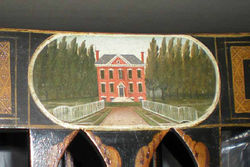

The choice of fence type was dictated by the materials available, local custom, and the need at hand. For instance, worm fences (also called zigzag, snake, split rail, or Virginia fences) did not require posts or post holes and therefore were easily moved to accommodate changing field use and avoided the problem of posts rotting in soil. They were also useful in areas where rocky soil made it difficult to dig post holes or in wooded areas where trees made straight fence lines impractical, as seen in the watercolor sketch by John Lewis Krimmel [Fig. 1]. Paled fences offered a more solid line of defense against deer and rabbits, but had less flexibility and required more labor and finished lumber [Fig. 2]. Such high fences were effective barriers for animals as well as humans, as attested by Robert Waln Jr.’s 1825 description of the board fence at the Friends Asylum for the Insane in Pennsylvania (view text).
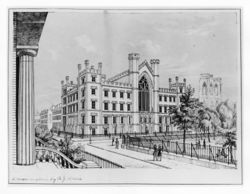
Paling fences created visual barriers and were sometimes erected to screen unpleasant views or to provide privacy, particularly in urban settings. For instance, in 1857 John Fanning Watson complained that “in the usual selfish style of Philadelphia improved grounds” at William Bingham’s Philadelphia residence, “the whole was surrounded and hid from the public gaze by a high fence” (view text). Fences were also used to direct the gaze, whether toward a house, as in Francis Guy’s chairback painting of Rose Hill in Baltimore [Fig. 3], or other focal point. In other cases, fences such as sunken types (later replaced by wire fences) were desired for their inconspicuous presence in the landscape. Numerous descriptions and horticultural advice columns praised the effect of unobstructed views created by enclosures that kept animals or human traffic at bay with minimal visibility (see Ha-ha).

Fences were constructed from a variety of materials. In the Tidewater’s sedimentary soils where stone was scarce, wood was the most common material and was used mainly in paled, post-and-rail or board, and worm fences. Although types of wood that could be used were varied, a typical paling fence utilized different types of wood. For example, hard wood, such as locust, cedar, or oak, was often used for posts; wood with tensile strength, such as oak, poplar, or pine, was used for rails; and lightweight wood, such as pine, could be employed for the pales.[3] Although worm fences [Fig. 4] have been documented in Delaware, New York, and as far north as Canada, they were so common in the Tidewater area that they were often identified as Virginia fences. Thomas Anburey even reported that New Englanders described a drunken man’s impaired movements as “making Virginia fences” (view text). In southern New England’s glacier-formed topography, abundant fieldstone was used for stone walls, which sometimes were referred to as stone fences.[4] Fences could also be created from live plants, predominantly thorn (hawthorn and buckthorn), although writers including Edward James Hooper (1842) and Charles Wyllys Elliott (1848) recommended osage orange, cedar, Chinese arbor vitae, privet, holly, honey and black locust, beech, willow, and hemlock. The advantages of live fences were a matter of great debate, particularly in early nineteenth-century publications that advocated the “new agriculture.” These writings included those by the New York and Massachusetts Agricultural Societies, and later, in periodical form, the Horticulturist. In addition to their durability and long-term cost savings, it was argued that live fences harmonized better with the surrounding landscape (see Hedge). A similar effect could also be achieved with other fences, as suggested by Edward Sayers (1838), by training “vines and creepers” to conceal old and unsightly fences (view text).

Iron gates were used in the 18th century at such sites as Westover, on the James River, Virginia, and the Governor’s Palace in Williamsburg, and iron fences were employed for the fronts of elite dwellings and notable institutions.[5] It was not, however, until the second quarter of the 19th century when the expansion of America’s domestic iron industry and advances in cast iron made iron fences affordable for those of more modest means. This availability is reflected in the more than one hundred fence patents that were registered between 1801 and 1857.[6] Treatises, such as those by A. J. Downing (1849) and William H. Ranlett (1851), provided examples of fashionable designs to be installed in front of suburban yards. Elaborate iron-work fences were particularly popular as enclosures for urban parks [Fig. 5], educational institutions [Fig. 6], and family burial plots [Fig. 7]. These plots, with their elaborate fences, were favorite subjects in illustrated books of the new rural cemeteries [Fig. 8].

Despite the variety of materials and designs, fences shared many common functions. Garden fences, like walls, created micro-climates for plants: southern façades were ideal for promoting early harvests of fruit trees trained on espaliers or protecting tender nursery plants, while northern sides provided sheltered, shady spots in long dry summers. William Cobbett (1819) emphasized the value of fences as shelters in America, given its extremes of heat and cold in contrast to the more temperate English climate (view text).
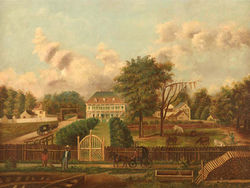
Fences were the primary boundary markers that defined property lines and distinguished “improved” from “unimproved” land, and early legislation frequently required the fencing of landholdings. Fences also marked divisions within a property owner’s estate, such as those between field, meadow, pasture, orchard, and yard; and, within the garden itself, fences separated areas such as the flower garden, kitchen garden, and nursery [Fig. 9]. The form of the fence often reflected its position or function. For example, post-and-rail fences would mark the boundaries and the divisions of the fields, while a palisaded brick wall served as a retaining wall along a slope, and a picket fence delineated the geometrically regular garden adjacent to the house. Not surprisingly, the public view of the property was often framed by more ornamented fence types, and aspiring owners could draw from pattern books, such as that by William and John Halfpenny (1755), for inspiration [Fig. 10]. Numerous images, including Caroline Betts’s painting of Lorenzo on Lake Cazenovia [Fig. 11], show a more elaborate treatment given to the fences in front of houses in contrast to the pale or post-and-rail fences that lined roads and enclosed meadows. William Cobbett (1819), in this vein, described a hierarchy of fences from the “rudest barriers” to the “grandest” and “noblest,” along with “every degree of gradation” in between (view text), and Asher Benjamin (1830) recommended that the size of front fences be suited to the scale of the house ().
Distinctions in the fence in the landscape were also made by painting sections or the sides of fences. In several New England examples, including the Dennie overmantel, utilitarian fences were painted red, while more formal fence sections near the house were painted white. In still other instances, such as the painting View Along the East Battery [Fig. 12], parts of the fence furthest from the house were left unpainted in contrast to the painted fence in front of the house. Views, such as Marie L. Pilsbury’s Louisiana plantation scene [Fig 13], are especially striking since the white gate of the drive stands out in sharp contrast to the unpainted brown post-and-rail fence. While the selective use of white served to highlight portions of the fence, it also conserved white paint, which was more costly.[7]
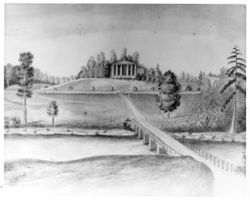
Fences were critical for keeping livestock in and garden pests contained. During the early years of settlement when livestock (such as pigs) were not restrained, colonists fenced their garden plots, while animals wreaked havoc on the open fields of Native Americans.[8] In large estates, above-ground fences or sunken fences around the house were used to separate animals grazing in the open land of larger, more naturalistic landscape parks from more densely planted areas immediately surrounding the house, as depicted in Francis Guy’s 1805 painting of Perry Hall in Baltimore [Fig. 14]. Urban gardens faced their share of potential intruders as well, both animal and human, and fences were an important element in defining urban public spaces such as commons, squares, roads, and parks.
Fences were symbolic, as well as practical, boundaries.[9] Churchyards were often fenced, in part to protect them from wandering animals, and in part to demarcate the sacred space within. The similarity of yard-like enclosures created around family burials suggests an expression of the eternal domestic unit represented within. In both images and actual landscapes, fences around residences signified the division between personal property and the world beyond. This boundary made the presence and treatment of openings, such as gates, particularly important as they marked the passage between these realms of the public and the private. Residential fences were also a visual statement of their owners’ resources and abilities. For example, in William Dering’s portrait of George Booth, the fence in the background divides the near and middle grounds [Fig. 15]. Dering extended the view into the distant, irregular landscape, but signaled the proprietor’s control over the space within the confines of his fence with the regular plantings and trimmed path. Countless representations of houses offer a similar demarcation, usually from the reverse perspective, showing the area surrounding the dwelling separated from the larger landscape by a fence. This division of domestic space is seen in modest gardens from Eunice Pinney’s Mother and Child in Mountain Landscape [Fig. 16] to more elaborate estates such as Janika de Fériet’s The Hermitage [Fig. 17].
Descriptions by travelers, such as Timothy Dwight, also demonstrate the significance of fences as an indication of the prosperity or decline of an area. Timothy Bigelow (1805) described the Shaker Village of Hancock, New York, as “much better fenced than any other in [the] vicinity” (view text). With some pride, a writer in the Horticultural Register in 1836 found Maine wanting in comparison to Massachusetts since there was “not that attention paid to the appearance of fences about the dwellings, door yards, &c. as with us” (view text). In something of an horticultural parable the Horticultural Register (1837) described the proprietor who spent all his money on his house leaving it to stand “dreary and alone. . . an unsightly broken fence to enclose it” while, with more foresight, “a more finished appearance is presented; the house is neatly painted. . . and a picket fence encircles it” (view text).
—Elizabeth Kryder-Reid
Texts
Usage
- Rex, Charles, August 1641, instructions to Sir William Berkeley (quoted in Billings 1975: 56)[10]
- “25. That they apply themselves to the Impaling of orchards and gardens for Roots and fruits, which that Country is so proper for and that every Planter be compelled for every 200 Acres Granted unto him to inclose and sufficiently Fence, either with Pales or Quick sett, and ditch, and so from time to time to preserve inclosed and Fenced a Quarter of an Acre of Ground in the most Convenient place near his dwelling house for Orchards and Gardens.”
- Fitzhugh, William, April 1686, in a letter to Dr. Ralph Smith, describing Greensprings, VA (quoted in Lockwood 1934: 2:46)[11]
- “. . . the Plantation where I now live contains a thousand acres, grounds and fencing. . . a large orchard of about 2500 Apple trees most grafted, well fenced with a locust fence, which is as durable as most brick walls, a Garden, a hundred foot square, well pailed in, a Yeard wherein is most of the aforesaid necessary houses, pallizad’d in with locust Punchens which is as good as if it were walled in and more lasting than any of our bricks.”
- Penn, William, c. 1687, in a letter to James Harrison, inquiring about Pennsbury Manor, country estate of William Penn, near Philadelphia (quoted in Thomforde 1986: 1)[12]
- “I should be glad to see a draugh of Pennsberry wch an Artist would quickly take, wth ye land scip of ye hous, out houses, orchards, also wt grounds you have cleered wt improvemts made. an account how the peach & apple orchards grow; Bear. if any walks be made, & steps at ye water & how yt garden next ye water towards ye house, is layd out & thrives, how farr you advance. . . wt fence about ye yards gardens & orchards.”
- Virginia General Assembly, October 23, 1705, describing a legislative ruling in Virginia (Colonial Williamsburg Foundation)
- “(I) Be it enacted. . . that if any horses, mares, cattle, hogs, sheep, or goats, shall break into any grounds, being inclosed with a strong and sound fence, four foot and half high, and so close that the beasts or kine breaking into the same, could not creep through; or with an hedge two foot high, upon a ditch of three foot deep, and three foot broad, or instead of such hedge, a rail fence of two foot and half high, the hedge or fence being so close that none of the creatures aforesaid can creep through, (which shall be accounted a lawful fence,) the owner. . . shall for the first trespass by any of them committed, make reparation to the party injured.”
- Anonymous, 4 August 1733, describing in the South Carolina Gazette a cemetery in Berkeley County, SC (Colonial Williamsburg Foundation)
- “The new Burying Ground Fence to be done in the same manner it formerly was, the posts of both to be of the best light wood, Chinquepin or Cedar.”
- Ball, Joseph, February 1734, describing a property in Virginia (Library of Congress, Joseph Ball Letter Book)
- “The apple Nursery Fence must be kept upright good & strong, but set upon blocks, so that small hogs may go in, to keep down the weeds.”
- Kalm, Pehr, September 21, 1748, and January 22, 1749, describing fences in Pennsylvania, New Jersey, and New York (1770; repr., 1937: 1:47, 238–39)[13]
- “The fences and pales are generally made here of wooden planks and posts. But a few good economists, having already thought of sparing the woods for future times, have begun to plant quick hedges round their fields; and for this purpose they take the above-mentioned privet, which they plant in a little bank that is thrown up for it.”
- “Fences. The fences built in Pennsylvania and New Jersey, but especially in New York, are those which on account of their serpentine form resembling worms are called ‘worm fences’*in English. The rails which compose this fence are taken from different trees, but they are not all of equal duration. . . In order to make rails the people do not cut down the young trees. . . but they fell here and there large trees, cut them in several places, leaving the pieces as long as it is necessary, and split them into rails of the desired thickness; a single tree affords a multitude of rails. . . Thus the worm fence is one of the most useful sorts of inclosures, especially as they cannot get any posts made of the wood of this county to last above six or eight years in the ground without rotting. . . the worm fences are easily put up again, when they are forced down. . . Considering how much more wood the worm-fences require (since they zigzag) than other fences which go in straight lines, and that they are so soon useless, one may imagine how the forests will be consumed, and what sort of an appearance the country will have forty or fifty years hence.
- “*The well-known zigzag fence of rails crossing at the ends. It is also called ‘snake fence’ or ‘Virginia rail fence.’
- Alexiowitz, Iwan, 1769, in a letter describing Bartram Botanic Garden and Nursery, vicinity of Philadelphia, PA (quoted in Darlington 1849: 50)[14]
- “Thence we rambled through his fields, where the rightangular fences, the heaps of pitched stones, the flourishing clover, announced the best husbandry, as well as the most assiduous attention.”
- Anburey, Thomas, January 20, 1779, describing Jones’s Plantation, near Charlottesville, VA (1789; repr., 1969: 2:323–24)[15]
- “The fences and enclosures in this province are different from others, for those to the northward are made either of stone or rails let into posts, about a foot asunder; here they are composed of what is termed fence rails, which are made out of trees cut or sawed into lengths of about twelve feet, that are mauld or split into rails from four to six inches diameter.
- “When they form an inclosure, these rails are laid so, that they cross each other obliquely at each end, and are laid zig zag to the amount of ten or eleven rails in height, then stakes are put against each corner, double across, with the lower ends drove a little into the ground, and above these stakes is placed a rail of double the size of the others, which is termed the rider, which, in a manner, locks up the whole, and keeps the fence firm and steady.
- “These enclosures are generally seven or eight feet high, they are not very strong but convenient, as they can be removed to any other place, where they may be more necessary; from a mode of constructing these enclosures in a zig zag form, the New-Englanders have a saying, when a man is in liquor, he is making Virginia fences.” back up to History
- Washington, George, 1785, diary entries (Jackson and Twohig, eds., 1978: 4: 199)[16]
- [March 11] “Planted. . . 13 Yellow Willow trees alternately along the Post and Rail fence from the Kitchen to the South ha-haw and from the Servants’ Hall to the Smith’s Shop. . .
- Cutler, Manasseh, July 13, 1787, describing the State House Yard, Philadelphia, PA (1987: 1:263)[17]
- “The Mall is at present nearly surrounded with buildings, which stand near to the board fence that incloses it, and the parts now vacant will, in a short time, be filled up.”
- Brissot de Warville, J. P., August 9, 1788, describing the journey from Boston to New York, NY (1792: 127–28)[18]
- “But the uncleared lands are all located, and the proprietors have inclosed them with fences of different sorts. These several kinds of fences are composed of different materials, which announce the different degrees of culture in the country. Some are composed of the light branches of trees; others, of the trunks of trees laid one upon the other; a third sort is made of long pieces of wood, supporting each other by making angles at the end; a fourth kind is made of long pieces of hewn timber, supported at the ends by passing into holes made in an upright post; a fifth is like the garden fences in England; the last kind is made of stones thrown together to the height of three feet. This last is most durable, and is common in Massachusetts.”
- Bentley, William, October 22, 1790, describing Elias Hasket Derby Farm, Peabody, MA (1962: 1:180)[19]
- “[231] 22. . . The Principal Garden is in three parts divided by an open slat fence painted white, & the fence white washed. It includes 7/8 of an Acre. . . The House is [lined?] with a superb fence, but is itself a mere country House, one story higher than common with a rich owner.”
- Moreau de Saint-Méry, M. L. E., May 25, 1794, describing the fences of houses in America (Roberts and Roberts, eds., 1947: 121–22)[20]
- “In America almost everything is sacrificed to the outside view. To accomplish this the fences of the houses are sometimes varied by these six combinations: 1. Planks are laid vertically and close together. 2. Planks are laid the same way, with a space between them. 3. Little narrow boards are laid across without joining. 4. Vertically placed laths are joined. 5. Vertically placed laths are not joined. 6. Laths are placed vertically, but passing alternately on the outside and the inside of cross members. Further elegance is obtained by using different shades of paint on lattices and partitions.”
- Rochefoucauld Liancourt, François-Alexandre-Frédéric, duc de la, 1795–97, describing Norristown, PA (1800: 1:18)[21]
- “Yet the uninterrupted and high fences of dry wood greatly disfigure the landscape, and produce a tedious sameness. These might be easily replaced by trees which endure the frost, as thorns are supposed here (I think without any just ground) to be unsuitable to the climate. Some of the fields along the road are bordered with traga or cedar, but these experiments are rare; and, in general, the land is inclosed with double fences of wood.”
- Dwight, Timothy, 1796, describing New Haven Green, New Haven, CT (1821: 1:184)[22]
- “Fences, and out-houses are also in the same style [neat and tidy]: and being almost universally painted white, make a delightful appearance to the eye; and appearance, not a little enhanced, by the great multitude of shade-trees: a species of ornament, in which this town is unrivalled.”
- Anonymous, April 18, 1800, describing in the Federal Gazette Willow Brook, seat of John Donnell, Baltimore, MD (quoted in Sarudy 1989: 137)[23]
- “That beautiful, healthy and highly improved seat, within one mile of the city of Baltimore, called Willow Brook, containing about 26 acres of land, the whole of which is under a good post and rail fence, divided and laid off into grass lots, orchards, garden.”
- Bigelow, Timothy, 1805, describing visit to Hancock Shaker Village, NY (quoted in Hammond 1982: 201)[24]
- “[The] lands (are) easily ascertained by the most transient observer; for they are more highly cultivated, laid out with more taste and regularity, and much better fenced than any other in their vicinity.” back up to History
- Drayton, Charles, November 2, 1806, describing The Woodlands, seat of William Hamilton, near Philadelphia, PA (1806: 54—55)[25]
- “The Fences separating the Park-lawn from the Garden on one hand, & the office yard on the other, are 4 ft. 6 high. The former are made with posts & lathes—the latter with posts, rails & boards. They are concealed with evergreeens hedge—of juniper I think. A common post & rail fence, [not in sight from the house,] winds from the public road gate, & joins to the garden fence, which is a double sloped ditch, with a low fence of posts & 3 rails. They seemed insufficient—at least for turbulent horses or even Sheep. The park lawn is not in good order, for lack of being fed upon. Its fences where it is not visible from the house, is of common posts & rails.”
- Stebbins, William, February 6, 1810, describing the White House, Washington, DC (1968: 37)[26]
- “Extended my walk alone to the President’s House:—a handsome edifice, tho’ like the capitol of free stone: the south yard principally made ground, bank’d up by a common stone wall: a plain picket fence on each side, the passage way to the house on the north: —some of the pickets lying on the ground.”
- Peale, Charles Willson, July 29, 1810, in letter to his son, Rembrandt Peale, describing Belfield, estate of Charles Willson Peale, Germantown, PA (Miller et al., eds., 1991: 3:55)[27]
- “This View is taken at a point [from] the Tennants house a small distance, by which you see the Roof of the Mantion over the Garden fence which are of boards on a Stone Wall.” [Fig. 18]
- Lambert, John, 1816, describing Skenesborough, NY, and the Northern and Mid-Atlantic states (1816: 2:28–29, 231–32)[28]
- “The other parts of the farms were covered with the stumps of trees, and enclosed by worm fences, which gave to these settlements a very rough appearance.”
- “A contrary practice is adopted in the northern and middle states, where a succession of farms, meadows, gardens, and habitations, continually meet the eye of the traveller; and if hedges were substituted for rail fences, those States would very much resemble some of the English counties.”
- Hulme, Thomas, June 28, 1818, describing the settlement of Morris Birkbeck, New Harmony, IN (quoted in Cobbett 1819: 475)[29]
- “910. I very much admire Mr. Birkbeck’s mode of fencing. He makes a ditch 4 feet wide at top, sloping to 1 foot wide at bottom, and 4 feet deep. With the earth that comes out of the ditch he makes a bank on one side, which is turfed towards the ditch. Then a long pole is put up from the bottom of the ditch to 2 feet above the bank; this is crossed by a short pole from the other side, and then a rail is laid along between the forks. The banks were growing beautifully, and looked altogether very neat as well as formidable; though a live hedge (which he intends to have) instead of dead poles and rails, upon top, would make the fence far more effectual as well as handsomer.”
- Green, Samuel, May 13, 1820, receipt for Hermitage, estate of Andrew Jackson, Nashville, TN (Hermitage Collections, Andrew Jackson Papers: DLC 9967)
- “To putting up one hundred & twenty one pannel of post and rail cedar fence at half a dollar pr pannel, $60.50”
- Hening, William Waller, 1823, describing a legislative action by the Virginia General Assembly (quoted in Lounsbury 1994: 138)[30]
- “. . . every freeman shall fence in a quarter of an acre of ground before Whitsuntide next to make a garden.”
- Waln, Robert, Jr., 1825, describing the Friends Asylum for the Insane, near Frankford, PA (1825: 231)[31]
- “In the rear of the wings are situated the yards or airing grounds, for the use of the male and female patients, separated by the space in the rear of the centre building, and each containing about five-ninths of an acre of ground, in grass, surrounded by walks. These are enclosed by board fences, ten feet in height, on the top of which is a simple, but effectual, apparatus for preventing escape of the patients. Boards about eight feet long and eight inches broad, and apparently forming part of the stationary fence, but detached from it, are placed around the whole circuit of the enclosure: these are connected to the fence beneath by hinges. Blocks of wood, about two feet long, are attached to these boards on the outside, at the lower part of which, are rings through which a strong wire is conducted: at the extremities of these wires alarum bells are attached. When the patient, in attempting to escape, seizes one of these moveable boards, it turns inwards on its hinges, the adventurer falls back into the yard, and the appendant blocks of wood, protruding, stretch the wire, and sound the alarm, which is distinctly heard through the building.” back up to History
- Committee of the Pennsylvania Horticultural Society, 1830, describing Sweet Briar, seat of Samuel Breck, vicinity of Philadelphia, PA (quoted in Boyd 1929: 425)[32]
- “Mr. Breck has taken considerable pains with a hedge of white hawthorn (Crataegus), which he planted in 1810, and caused to be plashed, stalked, and dressed last Spring by two Englishmen, who understood the business well. Yet he apprehends the whole of the plants will gradually decay, and oblige him to substitute a post and rail fence. Almost every attempt to cultivate a live fence in the neighborhood of Philadelphia seems to have failed. The foliage disappears in August, and the plant itself is short lived in our climate.”
- Committee of the Pennsylvania Horticultural Society, 1830, describing Eaglesfield, country residence of John J. Borie, vicinity of Philadelphia, PA (quoted in Boyd 1929: 441)[32]
- “The lawn is extensive, and divided from the house by a handsome chain fence, supported by posts painted green and very neatly turned. We notice this triple chained barrier, so light and beautiful, because we were informed that its price is as cheap as wood; to which, its graceful curve, and light appearance, render it every way superior.”
- Mason, General John, c. 1830, describing Gunston Hall, seat of George Mason, Mason Neck, VA (quoted in Rowland 1964: 1:100)[33]
- “The isthmus on the northern boundary is narrow and the whole estate was kept completely enclosed, by a fence on that side of about one mile in length running from the head of Holt’s to the margin of Pohick Creek. This fence was maintained with great care and in good repair in my father’s time, in order to secure his own stock the exclusive range within it, and made of uncommon height, to keep in the native deer which had been preserved there in abundance from the first settlement of the country, and indeed are yet there in considerable numbers.”
- Ingraham, Joseph Holt, 1835, describing the villas and gardens along the Mississippi River (1835: 1:230)[34]
- “An hour’s drive, after clearing the suburbs, past a succession of isolated villas, encircled by slender columns and airy galleries, and surrounded by richly foliaged gardens, whose fences were bursting with the luxuriance which they could scarcely confine, brought us in front of a charming residence.”
- B., J., October 1, 1836, “Horticulture in Maine” (Horticultural Register 2: 385)[35]
- “Through the whole country, the substantials of life seem to be more attended to than ornament or the luxuries of horticulture.—There is not that attention paid to the appearance of fences about the dwellings, door yards, &c. as with us.” back up to History
- Adams, Nehemiah, 1842, describing Boston Common, Boston, MA (1842: 42–43)[36]
- “The iron fence and brick side-walk which surround the Common are noble monuments of public enterprise and of the energy of American mechanics. The burial-ground formerly reached to the southern line of the Common. It was resolved to continue the mall through the burial-ground, but it was foreseen that, in doing it, public accomodation would interfere with the private and sacred attachment of individuals to their ancestral tombs. . . [After the burials were moved] The mall was continued through the burial-ground to make the entire circuit of the Common. A slight and graceful iron fence was thrown around the tombs, and a rich and durable fence of the same material, with a brick wall outside, surrounding the whole Common, a circumference of five thousand eight hundred and sixty-seven feet, was begun and completed within six months.”
- Longfellow, Samuel, September 3, 1845, describing the Vassall-Craigie-Longfellow House, Cambridge, MA (quoted in Evans 1993: 1:40)[37]
- “A buckthorn hedge has been made between us & Mr. Hastings, and Mr. Worcester not satisfied with the rustic open fence which separates between us demands a hedge there also which will cover up entirely the glimpse that I get from my western window and which I do not at all like to loose [sic].” [Fig. 19]
- Cleaveland, Nehemiah, 1847, describing Mount Auburn Cemetery, Cambridge, MA (quoted in Walter 1847: 20)[38]
- “In 1844, the increasing funds of the corporation justified a new expenditure for the plain but massy iron fence which encloses the front of the Cemetery. This fence is ten feet in height, and supported on granite posts extending four feet into the ground. It measures half a mile in length, and will, when completed, effectually preserve the Cemetery inviolate from any rude intrusion. The cost of the gateway was about $10,000—the fence, $15,000.
- “A continuation of the iron fence on the easterly side is now under contract, and a strong wooden palisade is, as we learn, to be erected on the remaining boundary during the present year.”
- Notman, John, 1848, describing his designs for the Hollywood Cemetery, Richmond, VA (quoted in Greiff 1979: 145)[39]
- “The east hill should be planted densely, the plants may be of any kinds—better it should be overgrown with the common pine than remain in its present state; anything growing on that side would make the Cemetery seem more private, which is very desirable, as all who feel must know—and indeed it may be laid down as a rule, that all the exterior fences of a rural cemetery ought to be enveloped in shade of trees or young plantings of trees, else why do we fence our lots, or shut out the world’s otherwise, if not in grief—therefore, all along the east and west fences should be thickly planted, occasionally spreading out wide as I have marked upon the plan on these two lines.”
- Kirkbride, Thomas S., April 1848, describing pleasure grounds and farm of the Pennsylvania Hospital for the Insane, Philadelphia, PA (American Journal of Insanity 4: 347, 349)[40]
- “The pleasure grounds of the two sexes are very effectually separated on the eastern side, by the deer-park, surrounded by a high palisade fence, but the Park itself is so low that it is completely overlooked from both sides; and the different animals in it are in full view from the adjoining grounds used by the patients of both sexes. . .
- “Between the north lodge and the deer-park, separated from the latter by a sunk palisade fence, is a neat flower garden. . .
- “The fences that have been put up, were rendered necessary by the uses to which the different parts of the grounds were appropriated. A large part of the palisade fences, like those enclosing the deer-park and drying-yard, were to effect the separation of the sexes, and the close fences have been made, almost invariably, for the sole purpose of protecting the patients from observation, and giving them the proper degree of privacy.”
- Tuthill, Louisa C. (Louisa Caroline), 1848, describing New Haven Burying Ground, New Haven, CT (1848: 337)[41]
- “The ‘burying-ground’ at New Haven, Connecticut, has long been celebrated for its beauty. It has recently been enclosed with a massive wall on three sides, and a bronzed iron fence in front. The entrance is of free-stone, in the Egyptian style. . . H. Austin architect.”
- Watson, John Fanning, 1857, describing the house of Israel Pemberton, Washington Square, and the house of William Bingham, Philadelphia, (1:375, 405, 414)[42]
- “The low fence along the garden on the line of Third street, gave a full expose of the garden walks and shrubbery, and never failed to arrest the attention of those who passed that way.”
- “THIS beautiful square, now so much the resort of citizens and strangers, as a promenade, was, only twenty-five years ago, a ‘Potter’s Field.’ . . . It was long enclosed in a post and rail fence, and always produced much grass.”
- “The grounds generally he had laid out in beautiful style, and filled the whole with curious and rare clumps and shades of trees; but in the usual selfish style of Philadelphia improved grounds, the whole was surrounded and hid from the public gaze by a high fence.” back up to History
Citations
- Worlidge, John, 1669, Systema Agriculturae (1669: 85–86)[43]
- “Seeing that Fencing, and Enclosing of Land is most evident to be a piece of the highest Improvement of Lands, and that all our Plantations of Woods, Fruits, and other Tillage, are thereby secured from external Injuries, which otherwise would lie open to the Cattel. . . And also subject to the lusts of vile persons. . .
- “For which reason we are obliged to maintain a good Fence, if we expect an answerable success to our Labors.”
- Marshall, Charles, 1799, An Introduction to the Knowledge and Practice of Gardening (1799: 1:114–15, 124)[44]
- “For hedges about a garden, (i.e. for the divisions of it) the laurel, yew, and holly are the principal evergreens: the former as a lofty and open fence, the second as close and moderate in height, and to be cut to any thing, the last as trainable by judicious pruning to an impregnable and beautiful fence. . .
- “Here [about the house] should be also a good portion of grass plat, or lawnwhich so delights the eye when neatly kept, also borders of shewy flowers, which, if backed by any kind of fence, it should be hid with evergreens, or at least with deciduous shrubs, that the scene may be as much as possible vivacious.”
- Marshall, William, 1803, On Planting and Rural Ornament (1803: 1:258–59)[45]
- “THE FENCE, where the place is large, becomes necessary: yet the eye dislikes constraint. Our ideas of liberty carry us beyond our species: the imagination feels a dislike in seeing even the brute creation in a state of confinement. Beside, a tall fence frequently hides, from the sight, objects the most pleasing; not only the flocks and herds, but the surface they graze upon. These considerations have brought the unseen fence into general use.”
- Repton, Humphry, 1803, Observations on the Theory and Practice of Landscape Gardening (1803: 80, 84)[46]
- “That the boundary fence of a place should be concealed from the house, is among the few general principles admitted in modern gardening; but even in this instance, want of precision has led to error; the necessary distinction is seldom made between the fence which incloses a park, and those fences which are adapted to separate and protect the subdivisions within such inclosure. . .
- “To describe the various sorts of fences suitable to various purposes, would exceed the limits and intentions of this work: every county has its peculiar mode of fencing, both in the construction of hedges and ditches, which belong rather to the farmer than the landscape gardener; and in the different forms and materials of pales, rails, hurdles, gates, &c.”
- M’Mahon, Bernard, 1806, The American Gardener’s Calendar (1806: 57, 65)[47]
- “The [pleasure] ground should be previously fenced, which may be occasionally a hedge, paling or wall, &c. as most convenient. . .
- “It being absolutely necessary to have the whole of the pleasure ground surrounded with a good fence of some kind, as a defence against cattle, &c. a foss being a kind of concealed fence, will answer that purpose where it can conveniently be made, without interrupting the view of such neighbouring parts as are beautified by art or nature, and at the same time affect an appearance that these are only a continuation of the pleasure-ground. Over the foss in various parts may be made Chinese and other curious and fanciful bridges, which will have a romantic and pleasing effect.”
- Main, Thomas, September 28, 1807, Directions for the Transplantation and Management of Young Thorn or Other Hedge Plants (1807: 37–38)[48]
- “A promiscuous assemblage of several different kinds of plants in a hedge cannot be recommended; such a heterogeneous composition will neither make a good fence nor look handsome.
- “It may, however, be allowable for me to say, that this mode of fencing, whenever it is practised in the United States, will contribute its share to give an orderly and systematic turn to our plans of rural policy, conducive to a permanent neatness and regularity among arrangements that are commonly in a continual state of confusion and change.”
- Gregory, G. (George), 1816, A New and Complete Dictionary of Arts and Sciences (1816: 2:n.p.)[49]
- “FENCE, in country affairs, a hedge, wall, ditch, bank, or other inclosure, made around gardens, woods, cornfields, &c. See HUSBANDRY. . .
- “GARDENING. . .
- “The situation of a garden should be dry, but rather low than high, and as sheltered as can be from the north and east winds. These points of the compass should be guarded against by high and good fences; by a wall of at least ten feet high; lower walls do not answer so well for fruit-trees, though one of eight may do. A garden should be so situated, to be as much warmer as possible than the general temper of the air is without, or ought to be made warmer by the ring and subdivision fences. This advantage is essential to the expectation we have from a garden locally considered.” back up to History
- Abercrombie, John, with James Mean, 1817, Abercrombie’s Practical Gardener (1817: 3, 339, 461–63)[50]
- “Competent fences are also serviceable in sheltering tender seedlings, and in forming warm borders for early crops and winter-standing plants; while, in another direction, some part of the line of fence will afford a shady border in summer, which is required by the peculiar constitutions of many small annual plants. . .
- “Fences.—The Flower Garden, which is not an appendage to ornamented grounds, will require a fence, wherever the domestic buildings do not serve as a boundary. For the inclosure, a wall or close paling is on two accounts to be preferred on the north side; both to serve as a screen, and to afford a warm internal face for training fruit-trees. When one of those is not adopted, recourse may be had to a good hedge-fence, planted on a bank, and defended by an outward ditch. The best outer hedge-fence is formed of white-thorn and holly. The ha-ha, or sunk-fence in a fosse, is a happy contrivance for preserving a distant prospect: but this is seldom adopted when the adjoining land belongs to another occupier. . .
- “External Fences.—Fences of all kinds are rather necessary and useful, as instruments of shelter and security, than to be chosen as materials of ornament. Whether the view terminates on the fence, or is directed beyond it, the effect on the scene at best is negative: thus a fence is sometimes made higher than its proper use requires, merely to shut out something more unsightly; and, in judiciously employing that capital invention, the sunk fence or ha-ha, the advantage, though great, is purely negative—some prospect worth retaining at considerable cost is not obstructed. . .
- “Internal Fences.—These must be lighter and more elegant: but the materials will equally vary with the local position and purpose. What has been said of shrubs for internal fences under Flower Garden, is applicable to the most extensive ornamented grounds; except that regularity is less requisite, if not out of place; and primness ought to be avoided. Posts, with a single chain, or a rope well pitched, are sometimes enough to keep cattle from a walk. When a stronger barrier is wanted against animals grazing the pasture near the house, so as not to intercept a distant view, one of the best devices is what is termed the invisible fence; which is composed of lines of elastic wire passed through upright iron stancheons, the whole painted green. . .
- “Instead of the ha-ha, or the invisible fence, the landscape-gardener sometimes forms a terrace three feet high; at the verge of this, an iron rail, or a double rail, run along two feet high, is a sufficient fence. . . Raised fences, in straight lines, and meeting so as to form angles, are totally at variance with all ideas of picturesque beauty: but a perfectly straight fence, drawn across a valley, appears to the eye as though serpentine; and therefore, without controverting any assumed principle, fences may run in the shortest direction over unequal surfaces; a few trees or bushes may be planted where the straightness, in a coincident line of view from the garden, would be most visible.”
- Cobbett, William, 1819, The American Gardener (1819: 19–21, 28–29, 106, 355, 957)[51]
- “31. The fence of a garden is an important matter; for, we have to view it not only as giving protection against intruders, two-legged as well as four-legged, but as affording shelter in cold weather and shade in hot, in both which respects a fence may be made of great utility in an American Garden, where cold and heat are experienced in an extreme degree. . .
- “33. In America a fence is not wanted for this purpose [raising fruit]; but it is very necessary for protection; for shelter; and for shade. . .
- “34. With regard to the second point; the shelter; this is of great consequence; for, it is very well known, that, on the south side of a good high fence, you can have peas, lettuces, radish, and many other things, full ten days earlier in the spring, than you can have them in the unsheltered ground. . . .
- “49. And why should America not possess this most beautiful and useful plant [the Haw-Thorn]? She has English gew-gaws, English Play-Actors, English Cards and English Dice and Billiards; English fooleries and English vices enough in all conscience; and why not English Hedges, instead of post-and-rail and board fences? If, instead of these steril-looking and cheerless enclosures the gardens and meadows and fields, in the neighbourhood of New York and other cities and towns, were divided by quick-set hedges, what a difference would the alteration make in the look, and in the real value too, of those gardens, meadows and fields! . . .
- “486. Forest trees. . . From the Transactions of the Society of Agriculture of New York, we learn, that hawthorn hedges and other live fences are generally adopted in the cultivated districts; but the time is not yet arrived for forming timber-plantations. . .
- “1803. Rails or fences, for parks and garden-scenery, are, as to lines, similarly characterized as gates; and, like gates, fences are of many species, from the rudest barriers without nails or iron work. . . to the numerous sorts of iron and wire barriers. . .
- “1804. Walls are unquestionably the grandest fences for parks; and arched portals, the noblest entrances; between these and the hedge or pale, and rustic gate, designs in every degree of gradation, both for lodges, gates, and fences, will be found in the works of Wright, Gandy, Robertson, Aikin, Pocock, and other architects who have published on the rural department of their art. The pattern books of manufacturers of iron gates and hurdles, and of wire workers, may also be advantageously consulted. . .
- “6874. Fences. Masses, in the ancient style of planting, were generally surrounded by walls or other durable fences. Here the barrier was considered as an object or permanent part of the scene, and for that reason was executed substantially, and even ornamentally. They were generally walls substantially coped, and furnished with handsome gates and piers. The rows of avenues and small clumps, or platoons intended to be finally thrown open, were enclosed by the most convenient temporary fence.” back up to History
- Parmentier, André, 1828, The Art of Landscape Gardening (1828: 186)[52]
- “The most should be made of the agreeable and interesting views which may be had in the neighbouring landscape. They may be made useful to the general plan by being represented as the property of the proprietor.
- “For this reason, I highly approve of blind fences, and live hedges. But fences, necessary as enclosures, should be concealed so as not to appear as boundaries to the establishment, and present to the eye a disagreeable interruption in the prospect.”
- Benjamin, Asher, 1830, “Front Fences” (1830; repr., 1972: 68–69)[53]
- “PLATE XXXIII. On this plate are three designs for fences, suitable for the enclosure of a country residence, which may be made of wood, when iron is not to be obtained, or when expense is to be avoided. . .
- “It is not supposed that the size of these examples will suit all situations. There are many situations which require the size of front fences to be varied; as for instance, when the house is very large and located on an elevated piece of ground, and at a considerable distance from the road: in this case the fence should be of the largest dimensions. But if the house be small, and so situated as to have the fence near it, the fence ought then to be small and low, so that it may not appear as a principal in the structure.” [Fig. 20] back up to History
- Bridgeman, Thomas, 1832, The Young Gardener’s Assistant (1832: 110, 134, 170)[54]
- “A Flower Garden should be protected from cold cutting winds by close fences, or plantations of shrubs, forming a close and compact hedge, which should be neatly trimmed every year. . .
- “When Shrubs, Creepers, or Climbers are planted against walls or trellises, either on account of their rarity, delicacy, or to conceal a rough fence or other unsightly object, they require different modes of training. . .
- “The following observations on Fruit Gardens are taken from the third volume of the New-York Farmer and Horticultural Reposity [sic]. Article 190, page 225, communicated by an Old Man:
- “‘A fruit garden in this free country ought to be protected by nothing less formidable than a pale or picket fence. It is in vain to think of having good fruit in small quantities, unless the proprietor can control every thumb and finger within his grounds, so that his stone-fruit, more especially, may be fully ripe before it be removed from the tree. . .
- “‘A pale or picket fence is a great protection to a fruit garden; for though some desperadoes may break through a few times in a season, it will effectually prevent the inroads of the small fry; and it has another important advantage: there are men and grown boys whose business frequently leads them across lots, through Peach orchards, and directly under Pear trees, that stand in a common enclosure, but who are too cautious to scale a garden fence, because they have no excuse for appearing on the inside; and these constitute a majority of the prowlers.
- “‘Further, those who shoot into a garden at night, generally take aim in the day time. Prevent their observations, (this fence will in many cases prevent it,) and the temptation and danger will greatly be lessened.’”
- Teschemacher, James E., November 1, 1835, “On Horticultural Architecture” (Horticultural Register 1: 409)[55]
- “Suppose the area or garden space to be small, one great object would be to shut out by shrubbery the boundaries, so that the small extent might not appear, to fill every angle and corner with the Lilac or other large and spreading plant, and to take every advantage of the adjoining land. Thus imagine the neighboring piece to be grass; by means of a very open or of a sunk fence and a grass plat the grass on both lands would appear to combine and present an extensive expanse of green, or if wood adjoins, then by judicious transplantation an uninterrupted line of copse would be formed, on which the eye would rest with pleasure. The invisible fences commonly used in England, might here be of great service, they are made of thick iron wire, about four feet high, with thin iron posts at distances of eight or ten feet, painted black, so that they form no impediment to such combinations of prospect with contiguous properties. The same may be done where a rivulet or a piece of water exists near, observing always that such innocent appropriations of our neighbor’s property is much better enjoyed when only caught at glimpses and between intervals of shrubbery. . .”
- Anonymous, April 1, 1837, “Landscape Gardening” (Horticultural Register 3: 121–23)[56]
- “The first thing, when a spot is fixed on for a house, if it be in a new country especially, is to cut down all the native trees and shrubs within several rods of it. The proprietor then sets to work and applies his whole resources to build as large a house as possible. When the work is completed his funds are exhausted; he can make no further improvements about his house; it is left standing, dreary and alone, perhaps unpainted, an unsightly broken fence to enclose it, and the nakedness of the yard only relieved by an old barrel, a pile of wood, and broken hoops and boards. Sometimes indeed a more finished appearance is presented; the house is neatly painted, a handsome grass plat extends before it, and a picket fence encircles it.” back up to History
- Sayers, Edward, 1838, The American Flower Garden Companion (1838: 18, 129)[57]
- “Ivy and Virginian creepers [are most proper] for walls, tall shrubs for concealing old boarded fences, and unsightly objects. . .
- “The trellises, arbors, walls, fences, and so on, should be covered with vines and creepers, so that the whole may have a corresponding appearance.” back up to History
- Downing, Andrew Jackson, February 1838, “On the Cultivation of Hedges in the United States” (Magazine of Horticulture 4: 6, 43)[58]
- “In many sections of the Union, where timber is becoming scarce, and stone for fencing does not abound, a substitute is anxiously sought after, and must be found in some species of plant, capable of making a close and impenetrable hedge. The advantages of live fences are great durability, imperviousness to man and beast, a trifling expense in keeping in order, and the great beauty and elegance of their appearance. Harmonizing in color with the pleasant green of the lawn and fields, they may, without (like board fences) being offensive to the eye, be brought, in many places, quite near to the dwelling-house. . .
- “The wall of masonry, the iron paling, or the wooden fence, may be well suited to the vicinity of houses or crowded towns; but for harmony of color, freshness of foliage, durability, and, in short, all that is most desirable for beauty and protection, the verdant hedge is without an equal.”
- Kenrick, William, April 1838, “Live Hedges” (Magazine of Horticulture 4: 121)[59]
- “Live hedges constitute the most durable and effectual, as well as the most beautiful fences known, when properly managed and well trained. A perfect hedge should form a barrier, close and compact to the surface of the earth.”
- Gentle, Andrew, 1841, Every Man His Own Gardener (1841: 93)[60]
- “I would prefer a kitchen garden near the house, but not fully in sight, partly surrounded with trees, ornamental as well as fruit, or grape vines, sloping a little to the south, and facing the sun at 11 o’clock, with a variety of soils, all of good depth, and free from stones or gravel, or rain water standing on it. It may be either square or oblong, but is most convenient to work when the sides are straight, with a fence of moderate height. In laying out, I would prefer a border all round the width of the fence, the walk half the width of the border, the main cross walks four feet wide, to plant currants, gooseberry, and raspberry bushes, four feet apart, or strawberry plants near the farmyard, and convenient for water.
- “For a market garden the same sort of ground, with a good fence all round. . .”
- Hooper, Edward James, 1842, The Practical Farmer, Gardener and Housewife (1842: 99–100, 155)[61]
- “FENCES. This subject is of great importance to the farmer. There is no tax upon his purse and labor so great, as that which demands the continual making and repairing of his fences. . . According to the present system, hundreds of half starved animals of all kinds are continually breaking into, or jumping over, or knocking down, the best kind of worm fences. It would be much to the ultimate advantage of the proprietors of land, if they would, wherever it is practicable, resort to the making of stone fences. . . With respect to live fences, they are found, in England, to be the best sort under general circumstances, excepting where there is abundance of stone at hand. . . In making fences of this kind, we should of course try our native plants and trees, before resorting to foreign kinds, on account of the uncertainties of climate. . . The plants in America which are at all suitable for hedges, are the American thorn, the cedar, the holly, the crab, the honey locust, the beech, the willow, the hemlock and the black locust. . .
- “HEDGES. These are becoming, and in some situations have become, highly desirable. Where there is plenty of rail timber, it will naturally be used for fences before any live enclosures. Where there is plenty of rocks also, these are the best and in the end the most economical materials for fences that can be used. But where no rocks are found, and no rail timber, it will be useful to substitute live hedges. In different sections of the country different kinds of plants proper for live fences will naturally exist. The locust for this purpose is one of the most valuable trees in the south. The Buckthorn in New England. . . The European hawthorn. . . in the west.”
- Anonymous, July 28, 1842, “Words of a Solomon and Sacred Roll. . .” (Western Reserve Historical Society Library, Shaker Manuscript Collection, reel 67VIIA43)
- “I do require that ye fence your meeting ground after the following order, as soon as ye consistently can, after you have ascertained the sacred spot which I have chosen. Build ye a smooth board fence and paint it white. **Make it 4 1/2 feet high, with a board flatwise on top.”
- Loudon, Jane, 1845, Gardening for Ladies (1845: 205–6)[62]
- “FENCES for flower-gardens and shrubberies, are either such as are intended to be invisible, or, more properly, not acknowledged,—such as barriers of wire, or, light iron rods, and sunk fences; or such as are intended to be acknowledged, and to form part of the landscape,—such as architectural parapets and hedges. . .
- “Architectural fences are used in small gardens, close to the house; and they should generally be low walls, of open work, in the style of the architecture of the building; and these walls may have piers at regular distances, terminating in vases, or other architectural ornaments, provided these are in harmony with the house. These walls, and indeed all other architectural fences, should be varied with shrubby plants planted against them, so as to harmonize them with the plants in the beds and borders within.”
- Johnson, George William, 1847, A Dictionary of Modern Gardening (1847: 221–22)[63]
- “FENCES are employed to mark the boundary of property, to exclude trespassers, either human or quadrupedal, and to afford shelter. They are either live fences, and are then known as hedges, or dead, and are then either banks, ditches, palings, or walls; or they are a union of those two, to which titles the reader is referred.
- “The following is the English law on the subject:—
- “In the eye of the law a hedge, fence, ditch, or other inclosure of land, is for its better manuring and improvement; and various remedies are therefore provided for their preservation. . .
- “Stealing metal garden-fencing is a felony. In America each State has its own peculiar laws on this as on other subjects. In Pennsylvania, by an Act of 1700, entitled ‘An act for the regulating and maintaining of Fences,’ it was provided that ‘all cornfields and grounds kept for inclosures within the said province and counties annexed, shall be well fenced with fence at least five feet high, and close at the bottom, &c.’ By an Act of 1729, it was provided that ‘to prevent disputes about the sufficiency of fences, all fences shall be esteemed lawful and sufficient, though they be not close at the bottom, so that the distance from the ground to the bottom thereof, exceed not nine inches; and that they be four feet and a half high, and not under.’ Both acts are operative in certain counties only.—See Purdon’s Digest.
- “Ornamental fences for enclosing gardens, yards, &c., are almost as diversified as the ideas of beauty in the human mind. ‘The impression, on viewing grounds laid out with some pretension to taste, is governed in a degree, by the style and character of the surrounding fence. It is a great mistake to suppose the most elaborate (and of course costly) are the most pleasing; yet acting on this supposition, we see exhibited fences which appear to have been planned as if to show the amount of money which could be thus expended, and after all, they rather disgust than please.
- “‘The figures 42, 43, 44, illustrate three simple designs, formed by straight slats or pales, and therefore of the least expense; they are readily executed, and agreeable from their simplicity. The colour which should be used, is of course a matter of taste; white is generally preferred, though dark shades, even jet black, are the most pleasing to many; for ourselves, we should choose the latter, though it be not the best, so far as the preservation of the wood is concerned.’—Rural Reg.”
- Elliott, Charles Wyllys, October 1848, “Reviews: Cottages and Cottage Life” (Horticulturist 3: 181)[64]
- “As far as practicable, make divisions which are necessary about the house of the ha-ha or blind fence, or of hedges, for which purpose the Maclura or Osage Orange is believed to be one of the most desirable plants.”
- Elder, Walter, 1849, The Cottage Garden of America (1849: 218)[65]
- “A. What a fine place you have got! that is a neat, well painted front fence; the flower plat between it and the house, with the evergreen in the centre is beautiful, and that verandah over the door, covered with flowering vines, looks well.”
- Downing, Andrew Johnson, 1849, A Treatise on the Theory and Practice of Landscape Gardening (1849: 343–44)[66]
- “Fences are often among the most unsightly and offensive objects in our country seats. Some persons appear to have a passion for subdividing their grounds into a great number of fields; a process which is scarcely ever advisable even in common farms, but for which there can be no apology in elegant residences. The close proximity of fences to the house gives the whole place a confined and mean character. . . It is frequently the case that, on that side of the house nearest the outbuildings, fences are, for convenience, brought in its close neighborhood, and here they are easily concealed by plantations; but on the other sides, open and unobstructed views should be preserved, by removing all barriers not absolutely necessary.
- “An old stone wall covered with creepers and climbing plants, may become a picturesque barrier a thousand times superior to such a fence. But there is never one instance in a thousand where any barrier is necessary.”
- Sargent, Henry Winthrop, November 1849, “Invisible Iron Fences” (Horticulturist 4: 212–13)[67]
- “Too much has been already said and written upon the subject of wire fences, to require any remarks from me upon their beauty and economy. Even upon farms, they are cheaper and more durable, and vastly more economical, than anything else, since no ground is lost on either side; and the plough and the scythe can be used immediately up to and under them. Upon ornamental places, especially of any size, I consider them almost indispensable to high keeping.
- “The great fault of our places in America, is the want of a proper termination to the ornamental grounds; or, rather, some intelligible division between the ornamental and practical. . .
- “The wire fence, therefore, forms an agreeable termination or setting to our ornamental grounds; or, if needs be, a division between the dressed and undressed portions of the estate. By its adoption, we might materially diminish the amount of lawn now kept under the scythe,—producing similar effects by substituting cattle—especially sheep—and increasing very much the charm of the landscape by the introduction of animated nature.
- “I doubt if the keenest eye can detect my fence at 30 or 40 yards distance. Consequently, our finest places even do not require a lawn larger than twice this breadth in diameter, provided the grass on the other side is kept equally short by sheep.”
- Jeffreys [pseud.], January 1850, “Critique on November Horticulturist” (Horticulturist 4: 313)[68]
- “Invisible Wire Fences.—Yes, and visible ones too, I trust, will soon begin to appear in this rail-fence and stone-wall distracted country of ours. Why it is that in the grounds of our wealthy country residents, they have not long ago been adopted, is passing strange. In all the long catalogue of farm, park, lawn and garden enclosures, there is nothing equal to it. . .
- “The substitution of wire fences for those now in use, will give to every farm, park, or lawn where they are introduced, a higher value. The improvement will be incalculable. Instead of rickety, zig-zag rail and board fences, and dilapidated stone walls with their interminable attendants of brush, briars and vermin, they will afford clean cultivation, and save a great amount of labor and waste now suffered by every one who has them to support.”
Images
Inscribed
John or William Bartram, "A Draught of John Bartram’s House and Garden as it appears from the River", 1758.
Anonymous, Plat of 117 Broad Street, 1797.
Anonymous, Plat of 117 Broad Street, 1797.
Charles Willson Peale, Sketches of Belfield [detail], 1810.
Charles Willson Peale, Sketches of Belfield, 1810.
Lewis Miller, “Old Philip Waltemeyer makeing a fence of boards at the old Southern Church yard,” 1813.
J. C. Loudon, Diagram of worm fence, in An Encyclopaedia of Gardening (1834), 412, fig. 276.
Miller & Co., Map of the residence & park grounds, near Bordentown, New Jersey: of the late Joseph Napoleon Bonaparte, ex-king of Spain, 1847.
Thomas S. Sinclair, “Plan of the Pleasure Grounds and Farm of the Pennsylvania Hospital for the Insane at Philadelphia,” in American Journal of Insanity, vol. 4, (April 1848).
Anonymous, “Plan of a Mansion Residence, laid out in the natural style,” in A. J. Downing, A Treatise on the Theory and Practice of Landscape Gardening (1849), 115, fig. 25. “At i, a light inconspicuous wire fence. . .”
Frances Palmer, Elevations and profiles of wood fences, in William H. Ranlett, The Architect vol. 2 (1851), pl. 30.
Associated
Edward Savage, The East Front of Mount Vernon, c.1787—92.
Alexander Robertson (artist), Francis Jukes (engraver), “Mount Vernon in Virginia,” 1800.
George Ropes, Mount Vernon, 1806.
Charles Willson Peale, Ground plot of Belfield, 1810.
George W. Stilwell, Patterns of railings at Green-Wood Cemetery, in Nehemiah Cleaveland, Green-Wood Illustrated (1847), pl. after 94.
Attributed
Benjamin Henry Latrobe, “Greenspring, home of William Ludwell Lee, James City County, Virginia,” n.d.
Anonymous, Surveyor’s plat of the courthouse and adjacent land in Charles County, MD, 1697. Fence is the zigzag line running vertically in center.
Anonymous, Fairhill, The Seat of Isaac Norris Esq., 18th century.
Charles Willson Peale, Parnassus, c. 1769.
Eliza Coggeshall, Brick House with Flowers and Birds on Fence, 1784, in Sotheby’s New York, Important American Schoolgirl Embroideries: The Landmark Collection of Betty Ring (January 2012): 53.[69]
John Nancarrow, "Plan of the Seat of John Penn jun’r: Esqr: in Blockley Township and County of Philadelphia," c. 1785. A fence is visible near the point indicated with the letter "f".
Thomas Coram, “View at St. James’s Goose Creek,” 1792.
John Drayton, A View of the Battery and Harbour of New York, and the Ambuscade Frigate, 1794.
David Leonard, A S. W. view of the College in Providence, together with the President's House & Gardens, c. 1795.
Anne Pope, Beige House, Birds Flying Over with Foreyard, 1796, in Sotheby’s New York, Important American Schoolgirl Embroideries: The Landmark Collection of Betty Ring (January 2012): 15.[69]
Clarissa Deming, Map of Deming Orchard, after 1798.
Thomas Coram, “View on the Road, Foot of Coll. Motte’s Rice field, Goose Creek,” 1800.
Amy Cox, attr., Box Grove, c. 1800.
Jonathan Budington or Dr. Francis Forgue, attr., View of Main Street in Fairfield, Connecticut, c. 1800.
Anonymous (artist), George Hayward (lithographer), Vauxhall Garden 1803, 1856.
Mary Antrim, Brick House with Two Foreyards and Animals, 1807, in Sotheby’s New York, Important American Schoolgirl Embroideries: The Landmark Collection of Betty Ring (January 2012): 72.[69]
John Archibald Woodside, Lemon Hill, 1807.
George Ropes, Salem Common on Training Day, 1808.
Rebecca Chester, A Full View of Deadrick’s Hill, 1810.
Mary Moulton, Needlework Sampler, 1813, in Sotheby’s New York, Important American Schoolgirl Embroideries: The Landmark Collection of Betty Ring (January 2012): 27.[69]
Charles Willson Peale, View of the Garden at Belfield, 1816.
Charles Willson Peale, View of the garden at Belfield, [detail] 1816.
Benjamin Henry Latrobe, “Plan of the public Square in the city of New Orleans, as proposed to be improved. . .” [detail], March 20, 1819.
Marie L. Pilsbury, Louisiana Plantation Scene, 1820.
Robert Campbell, after Thomas Birch, View of the Dam and Water Works at Fairmount, Philadelphia, 1824.
Arthur J. Stansbury, City Hall Park From the Northwest Corner of Broadway and Chambers Street, c. 1825.
Anonymous, The Plantation, c. 1825.
Alexander Jackson Davis, Castle Garden, N. York, c. 1825–28.
W. J. Bennett, Broad Way from the Bowling Green, c. 1826.
Anthony St. John Baker, “View of the White House,” 1826, in Mémoires d’un voyageur qui se repose (1850).
Hugh Bridport, The Pagoda and Labyrinth Garden, c. 1828.
Samuel Barnard, View Along the East Battery, Charleston, 1831.
Alexander Jackson Davis, Ithiel Town, and James Dakin, New York University, Washington Square, 1833.
W. R. Hamilton, Landscape View of a Garden and House [detail], 1836.
F. A. Holtzwart, A View of Reading Taken from the West Side of the Schuylkill, 1837.
Robert Mills, “Picturesque View of the Building, and Grounds in front,” 1841.
Frances Palmer (artist), Nathaniel Currier (lithographer), “Union Place Hotel, Union Square New-York,” c. 1845.
Anonymous, “Bowling Green Fountain,” in E. Porter Belden, New-York, Past, Present, and Future (1850), opp. 30.
Robert P. Smith, “View of Washington,” c. 1850.
Anonymous, Capitol Under Construction, View Looking East Toward the Capitol From Third Street Vicinity, July 1860.
Middleton, Strobridge & Co. (engraver), “Mount Vernon, the home of Washington,” c. 1861. A fence can be seen along right edge of the house grounds.
Notes
- ↑ Humphry Repton, Observations on the Theory and Practice of Landscape Gardening (London: Printed by T. Bensley for J. Taylor, 1803), 84, view on Zotero.
- ↑ For a more detailed discussion of fence types, see Vanessa Patrick, “Partitioning the Landscape,” Colonial Williamsburg Research Report (Williamsburg, VA: Williamsburg Foundation, 1983), view on Zotero; Elizabeth Wilkinson and Marjorie Henderson, eds., Decorating Eden: A Comprehensive Sourcebook of Classic Garden Details (San Francisco: Chronicle Books, 1992), 42–69, view on Zotero; Wilbur Zelinsky, “Walls and Fences,” in Changing Rural Landscapes, ed. Ervin H. and Margaret J. Zube (Amherst: University of Massachusetts Press, 1977), 53–63, view on Zotero.
- ↑ Patrick 1983, 2, 16, view on Zotero.
- ↑ While treatise and dictionary definitions of “fence” list stone and brick as building materials, it was common practice in America to refer to stone and brick barriers as walls. In 1871, the first year for which statistics were kept, a study of fence types in New England revealed that stone fences ranged from 32 percent in Vermont and 33 percent in Connecticut to 67 percent in Maine and 79 percent in Rhode Island; see Zelinsky 1977, 59, view on Zotero.
- ↑ At Westover, research has revealed that the iron-gate was originally painted white (Carl Lounsbury, personal communication).
- ↑ See Gregory K. Dreicer, “Wired! The Fence Industry and the Invention of Chain Link,” in Between Fences, ed. Gregory K. Dreicer (Washington, DC: National Building Museum; New York: Princeton Architectural Press, 1996), 71, view on Zotero.
- ↑ Robert Emlen, Shaker Village Views: Illustrated Maps and Landscape Drawings by Shaker Artists of the Nineteenth Century (Hanover, NH, and London: University Press of New England, 1987), 8, view on Zotero.
- ↑ William Cronon, Changes in the Land: Indians, Colonists, and the Ecology of New England (New York: Hill and Wang, 1983), 130–31, view on Zotero.
- ↑ The functions, both symbolic and practical, of fences have been explored in an exhibition organized by Gregory K. Dreicer with an accompanying catalogue, Between Fences, cited above.
- ↑ Warren M. Billings, ed. The Old Dominion in the Seventeenth Century: A Documentary History of Virginia, 1606-1689 (Williamsburg, VA: Institute of Early American History and Culture at Williamsburg, Virginia, 1975), view on Zotero.
- ↑ Alice B. Lockwood, ed., Gardens of Colony and State: Gardens and Gardeners of the American Colonies and of the Republic before 1840, 2 vols. (New York: Charles Scribner’s for the Garden Club of America, 1931–34), view on Zotero.
- ↑ Charles Thomforde, “William Penn’s Estate at Pennsbury and the Plants of Its Kitchen Garden” (MS thesis, University of Delaware, 1986), view on Zotero.
- ↑ Pehr Kalm, The America of 1750: Peter Kalm’s Travels in North America. The English Version of 1770, 2 vols. (1770; repr., New York: Wilson-Erickson, 1937), view on Zotero.
- ↑ Williams Darlington, Memorials of John Bartram and Humphry Marshall: With Notices of Their Botanical Contemporaries (Philadelphia: Lindsay & Blakiston, 1849), view on Zotero.
- ↑ Thomas Anburey, Travels through the Interior Parts of America 2 vols. (1789; repr. New York: New York Times and Arno Pres, 1969), view on Zotero.
- ↑ Donald Jackson and Dorothy Twohig, eds., The Diaries of George Washington, 6 vols. (Charlottesville: University Press of Virginia, 1978), view on Zotero.
- ↑ Manasseh Cutler, Life, Journals, and Correspondence of Rev. Manasseh Cutler, ed. William Parker Cutler and Julia Perkin Cutler, 2 vols. (Athens: Ohio University Press, 1987), view on Zotero.
- ↑ J.-P. (Jacques-Pierre) Brissot de Warville, New Travels in the United States Performed in 1788 (New York: T. & J. Swords, 1792), view on Zotero.
- ↑ William Bentley, The Diary of William Bentley, D.D., Pastor of the East Church, Salem, Massachusetts, 4 vols. (Gloucester, MA: Peter Smith, 1962), view on Zotero.
- ↑ Kenneth Roberts and Anna M. Roberts, eds., Moreau de St. Méry’s American Journey, [1793–1798] (Garden City, NY: Doubleday, 1947), view on Zotero.
- ↑ François-Alexandre-Frédéric, duc de la Rochefoucauld Liancourt, Travels through the United States of North America, the Country of the Iroquois, and Upper Canada, in the Years 1795, 1796, and 1797, ed. Brisson Dupont and Charles Ponges, trans. H. Newman, 2nd ed., 4 vols. (London: R. Philips, 1800), view on Zotero.
- ↑ Timothy Dwight, Travels in New England and New York, 4 vols. (New Haven, CT: Timothy Dwight, 1821–22), view on Zotero.
- ↑ Barbara Wells Sarudy, “Eighteenth-Century Gardens of the Chesapeake,” Journal of Garden History 9, no.3 (July–September 1989): 104–59, view on Zotero.
- ↑ Charles Arthur Hammond, “‘Where the Arts and the Virtues Unite’: Country Life Near Boston, 1637–1864” (PhD diss., Boston University, 1982), view on Zotero.
- ↑ Charles Drayton, “The Diary of Charles Drayton I, 1806,” Drayton Papers, MS 0152, Drayton Hall, SC, view on Zotero.
- ↑ William Stebbins, The Journal of William Stebbins ed. Pierce W. Gaines (Hartford, CT: Acorn Club, 1968), view on Zotero.
- ↑ Lillian B. Miller et al., eds., The Selected Papers of Charles Willson Peale and His Family, 5 vols. (New Haven, CT: Yale University Press, 1983–2000), view on Zotero.
- ↑ John Lambert, Travels through Canada, and the United States of North America in the Years 1806, 1807, and 1808, 2 vols. (London: Baldwin, Cradock, and Joy, 1816), view on Zotero.
- ↑ William Cobbett, A Year’s Residence in the United States of America (London: Sherwood, Neely and Jones, 1819), view on Zotero.
- ↑ Carl R. Lounsbury, ed. An Illustrated Glossary of Early Southern Architecture and Landscape (New York: Oxford University Press, 1994), view on Zotero.
- ↑ Robert Waln Jr., “An Account of the Asylum for the Insane, Established by the Society of Friends, near Frankford, in the Vicinity of Philadelphia,” Philadelphia Journal of the Medical and Physical Sciences 1, no. 2 (1825): 225–51, view on Zotero.
- ↑ 32.0 32.1 James Boyd, A History of the Pennsylvania Horticultural Society, 1827–1927 (Philadelphia: Pennsylvania Horticultural Society, 1929), view on Zotero.
- ↑ Kate Mason Rowland, The Life of George Mason: 1725–1792, 2 vols. (New York: Russell and Russell, 1964), view on Zotero.
- ↑ Joseph Holt Ingraham, The South-West, 2 vols. (New York: Harper, 1835), view on Zotero.
- ↑ J. B. “Horticulture in Maine,” Horticultural Register, and Gardener’s Magazine 2 (October 1, 1836): 380–86, view on Zotero.
- ↑ Nehemiah Adams, Boston Common (Boston: William D. Ticknor and H. B. Williams, 1842), view on Zotero.
- ↑ Catherine Evans, Cultural Landscape Report for Longfellow National Historic Site, History and Existing Conditions, 2 vols. (Boston: National Park Service, North Atlantic Region, 1993), view on Zotero.
- ↑ Cornelia W. Walter, Mount Auburn Illustrated (New York: Martin and Johnson, 1847), view on Zotero.
- ↑ Constance Greiff, John Notman, Architect, 1810–1865 (Philadelphia: Athenaeum of Philadelphia, 1979), view on Zotero.
- ↑ Thomas S. Kirkbride, “Description of the Pleasure Grounds and Farm of the Pennsylvania Hospital for the Insane, With Remarks,” American Journal of Insanity 4, no. 4 (April 1848): 347–54, view on Zotero.
- ↑ Louisa Tuthill, History of Architecture, from the Earliest Times; Its Present Condition in Europe and the United States; with a Biography of Eminent Architects, and a Glossary of Architectural Terms (Philadelphia: Lindsay and Blakiston, 1848), view on Zotero.
- ↑ John Fanning Watson, Annals of Philadelphia and Pennsylvania in the Olden Time; Being a Collection of Memoirs, Anecdotes, and Incidents of the City and Its Inhabitants. . . , 2 vols. (Philadelphia: E. Thomas, 1857), view on Zotero.
- ↑ John Worlidge, Systema Agriculturae, The Mystery of Husbandry Discovered (London: T. Johnson. 1669), view on Zotero.
- ↑ Charles Marshall, An Introduction to the Knowledge and Practice of Gardening, 1st American ed., 2 vols. (Boston: Samuel Etheridge, 1799), view on Zotero.
- ↑ Williams Marshall, On Planting and Rural Ornament: A Practical Treatise. . ., 2 vols. (London: G. and W. Nicol; G. and J. Robinson; T. Cadell, and W. Davies, 1803), view on Zotero.
- ↑ Humphry Repton, Observations on the Theory and Practice of Landscape Gardening (London: printed by T. Bensley for J. Taylor, 1803), view on Zotero.
- ↑ Bernard M’Mahon, The American Gardener’s Calendar: Adapted to the Climates and Seasons of the United States. Containing a Complete Account of All the Work Necessary to Be Done. . . for Every Month of the Year. . . (Philadelphia: printed by B. Graves for the author, 1806), view on Zotero.
- ↑ Thomas Main, Directions for the Transplantation and Management of Young Thorn or Other Hedge Plants, Preparative to Their Being Set in Hedges, with Some Practical Observations on the Method of Plain Hedging (Washington, DC: A. G. and Way, 1807), view on Zotero.
- ↑ George Gregory, A New and Complete Dictionary of Arts and Sciences, 3 vols, (Philadelphia: Isaac Peirce, 1816), view on Zotero.
- ↑ John Abercrombie, Abercrombie’s Practical Gardener Or, Improved System of Modern Horticulture (London: T. Cadell and W. Davies, 1817), view on Zotero.
- ↑ William Cobbett, The American Gardener, 1st ed. (Claremont, NH: Manufacturing Company, 1819), view on Zotero.
- ↑ André Parmentier, “The Art of Landscape Gardening,” in The New American Gardener, ed. Thomas Fessenden (Boston: J. B. Russell, 1828), view on Zotero.
- ↑ Asher Benjamin, The Practical House Carpenter (1830; repr. New York: Da Capo, 1972), view on Zotero.
- ↑ Thomas Bridgeman, The Young Gardener’s Assistant, 3rd ed. (New York: Geo. Robertson, 1832), view on Zotero.
- ↑ James E. Teschemacher, “On Horticultural Architecture,” Horticultural Register, and Gardener’s Magazine 1 (November 1, 1835): 409–12, view on Zotero.
- ↑ Anonymous, “Landscape Gardening,” Horticultural Register, and Gardener’s Magazine 3 (April 1, 1837): 121–31, view on Zotero.
- ↑ Edward Sayers, The American Flower Garden Companion, Adapted to the Northern States (Boston: Joseph Breck, 1838), view on Zotero.
- ↑ A. J. Downing, “On the Cultivation of Hedges in the United States,” Magazine of Horticulture, Botany, and All Useful Discoveries and Improvements in Rural Affairs 4, no. 2 (February 1838): 41–44, view on Zotero.
- ↑ William Kenrick, “Live Hedges,” Magazine of Horticulture, Botany, and All Useful Discoveries and Improvements in Rural Affairs 4, no. 4 (April 1838): 121–23, view on Zotero.
- ↑ Andrew Gentle, Every Man His Own Gardener; Or, a Plain Treatise on the Cultivation of Every Requisite Vegetable in the Kitchen Garden, Alphabetically Arranged. With Directions for the Green & Hothouse, Vineyard, Nursery, &c. Being the Result of Thirty-Five Years’ Practical Experience in This Climate. Intended Principally for the Inexperienced Horticulturist (New York: the author, 1841), iii–iv, view on Zotero.
- ↑ Edward James Hooper, The Practical Farmer, Gardener and Housewife, or Dictionary of Agriculture, Horticulture, and Domestic Economy (Cincinnati, OH: George Conclin, 1842), view on Zotero.
- ↑ Jane Loudon, Gardening for Ladies; and Companion to the Flower-Garden, ed. A. J. Downing (New York: Wiley & Putnam, 1845), view on Zotero.
- ↑ George William Johnson, A Dictionary of Modern Gardening, ed. David Landreth (Philadelphia: Lea and Blanchard, 1847), view on Zotero.
- ↑ Charles Wyllys Elliott, “Reviews: Cottages and Cottage Life,” Horticulturist and Journal of Rural Art and Rural Taste 3, no. 4 (October 1848): 179–82, view on Zotero.
- ↑ Walter Elder, The Cottage Garden of America (Philadelphia: Moss, 1849), view on Zotero.
- ↑ A. J. [Andrew Jackson] Downing, A Treatise on the Theory and Practice of Landscape Gardening, Adapted to North America. . . , 4th ed. (New York: G. P. Putnam, 1849), view on Zotero.
- ↑ Henry Winthrop Sargent, “Invisible Iron Fences,” Horticulturist and Journal of Rural Art and Rural Taste 4, no. 5 (November 1849): 211–14, view on Zotero.
- ↑ Jeffreys [pseud.], “Critique on November Horticulturist,” Horticulturist and Journal of Rural Art and Rural Taste 4, no. 7 (January 1850): 310–15, view on Zotero.
- ↑ 69.0 69.1 69.2 69.3 69.4 Sotheby’s New York, Important American Schoolgirl Embroideries (January 2012), view on Zotero.

